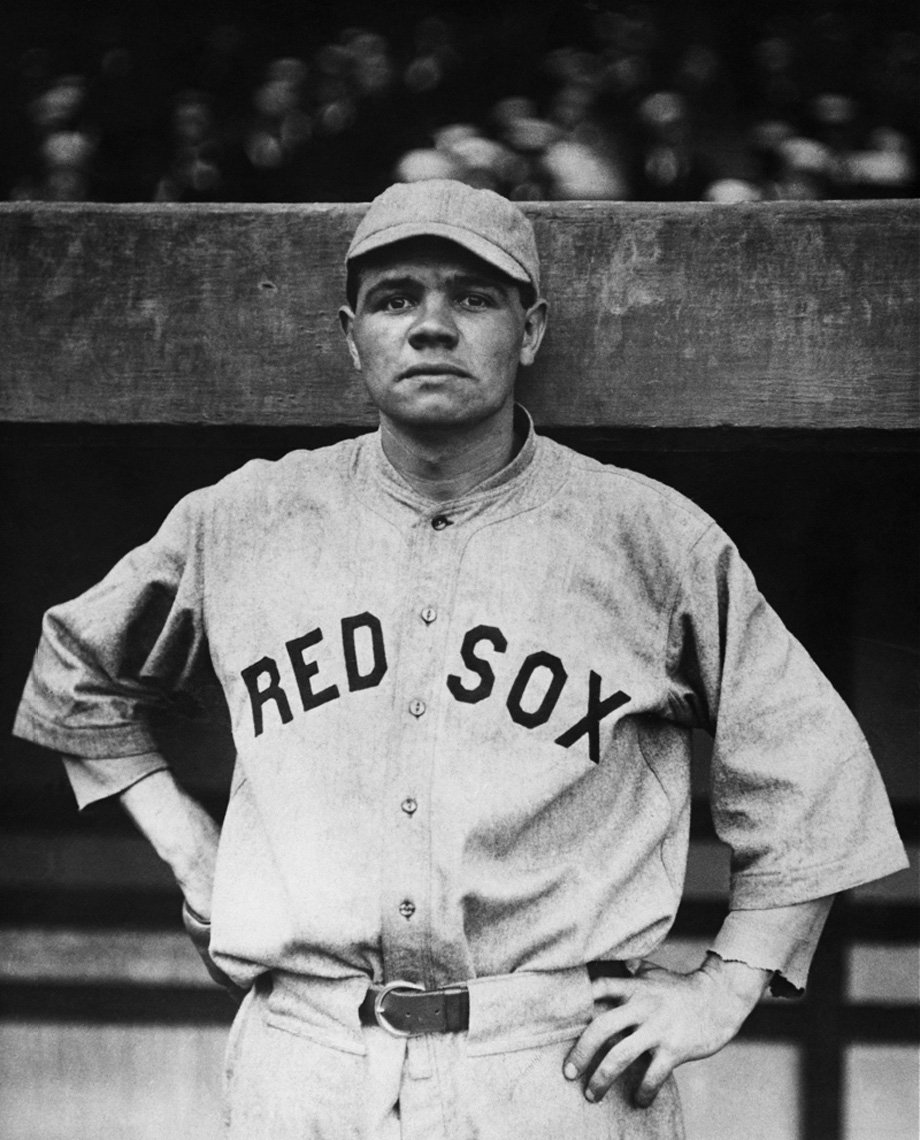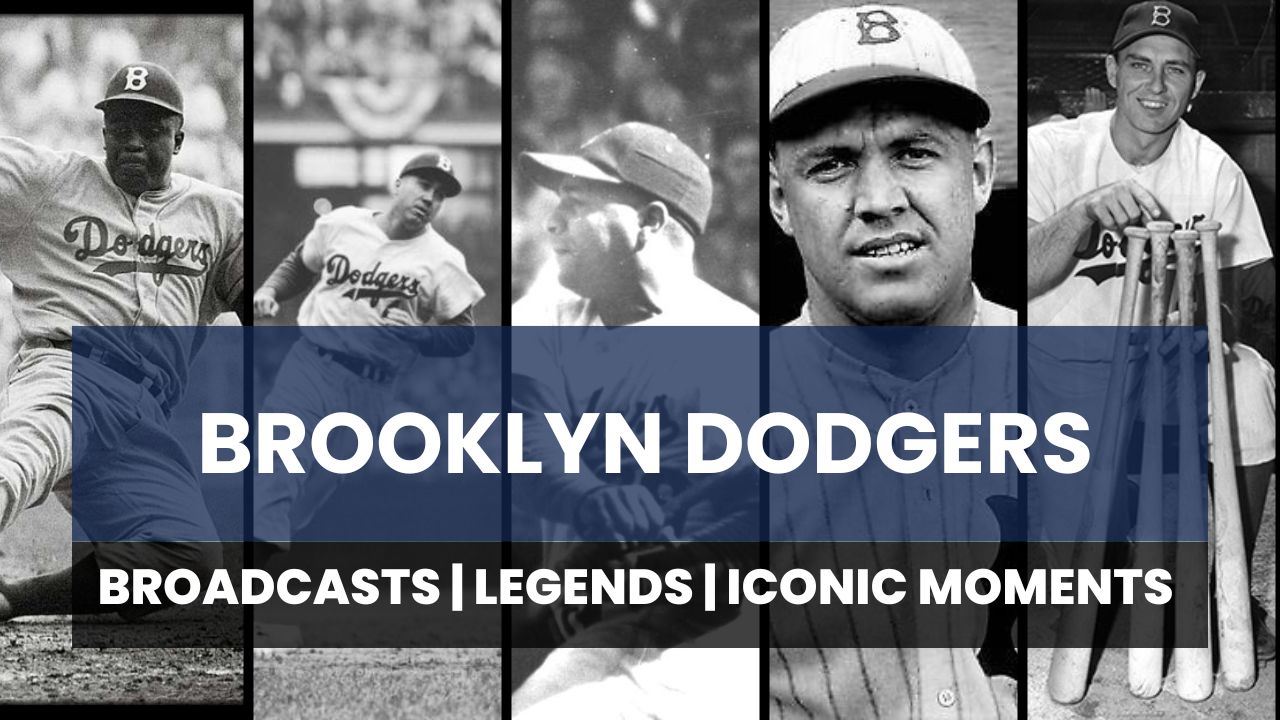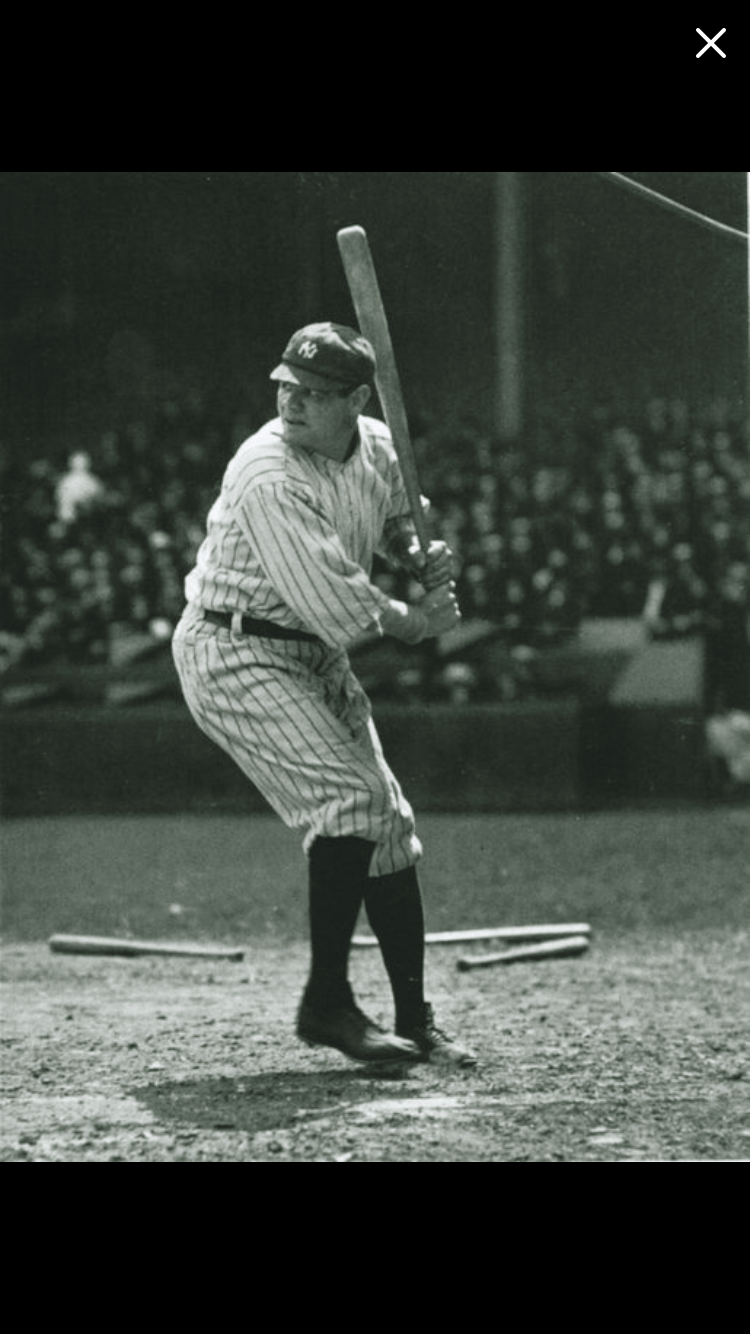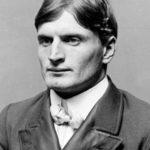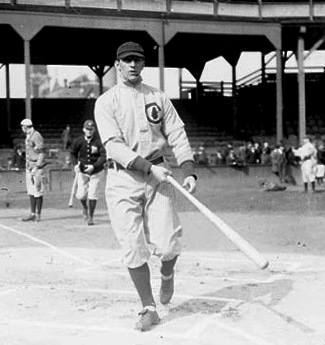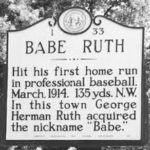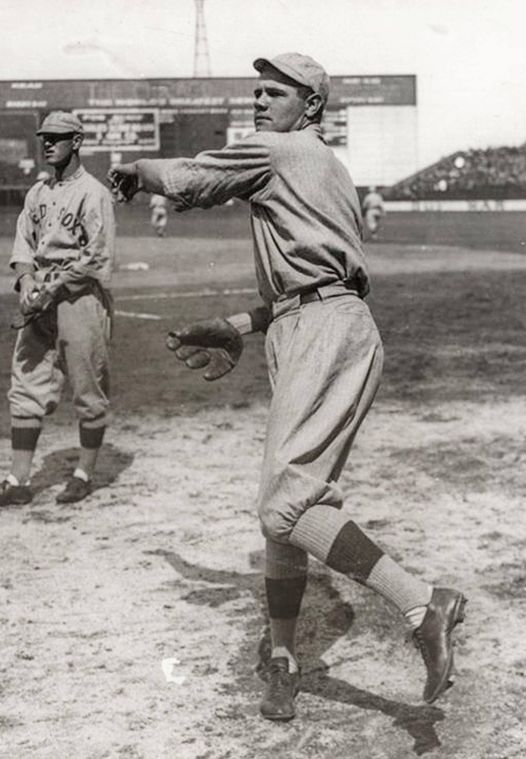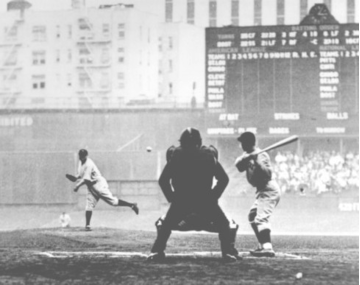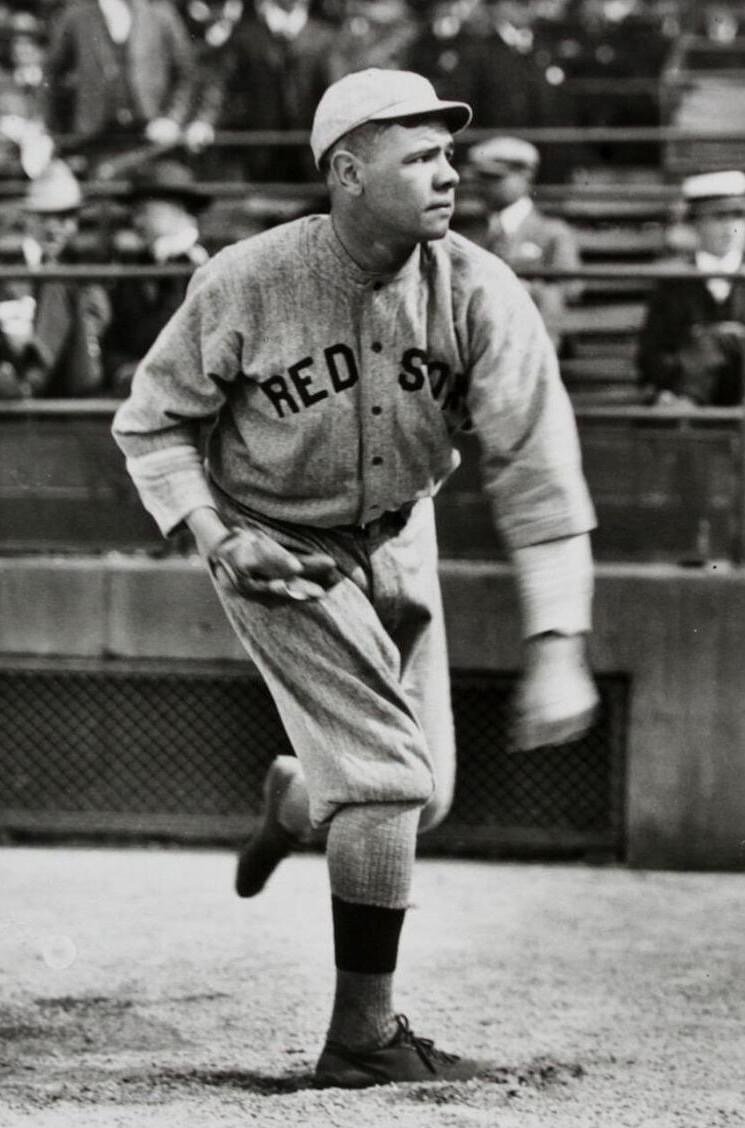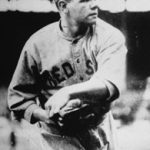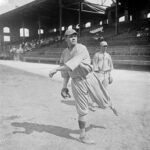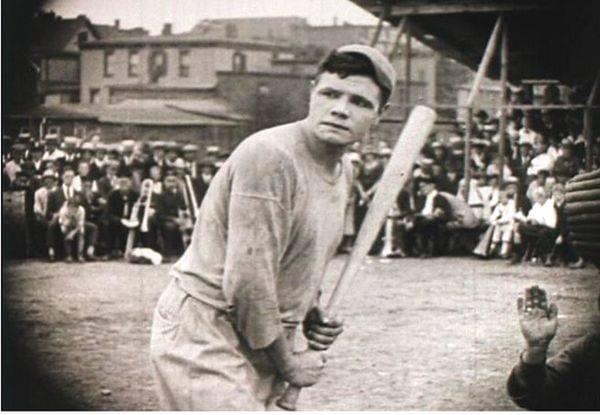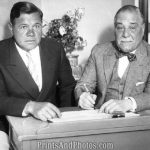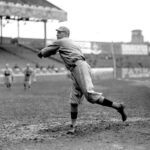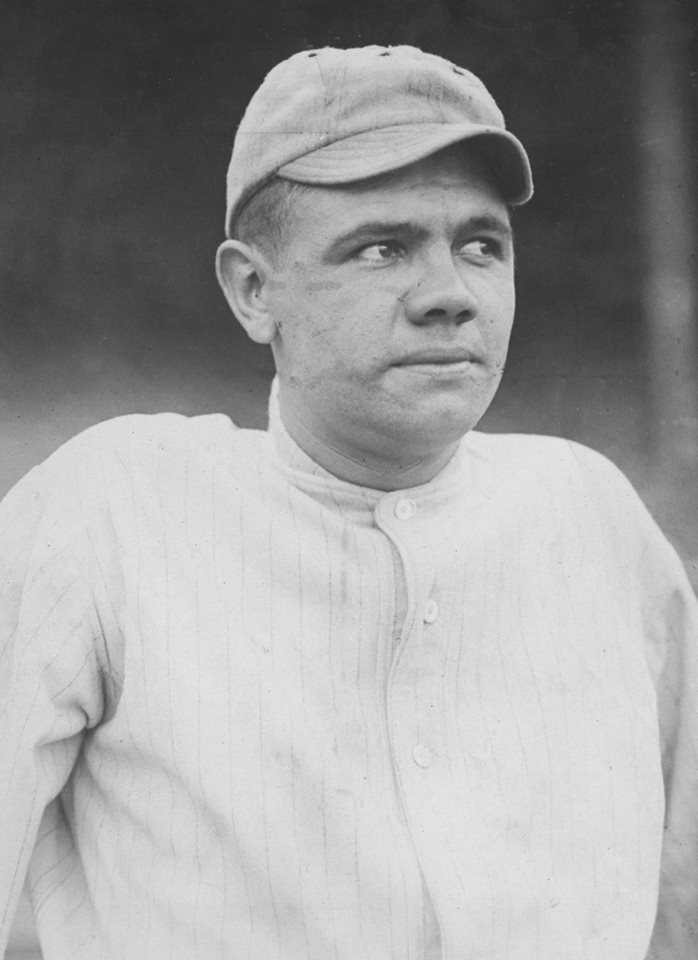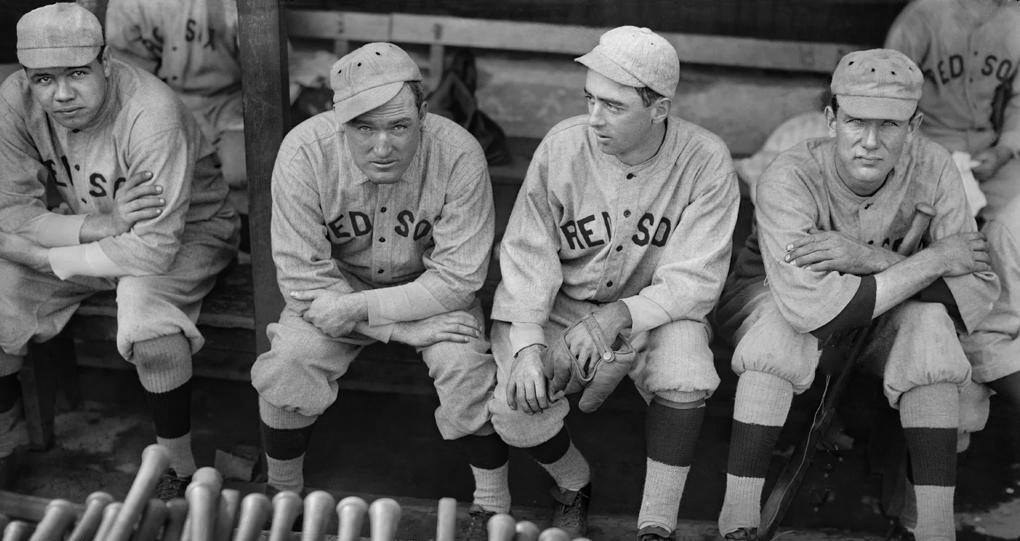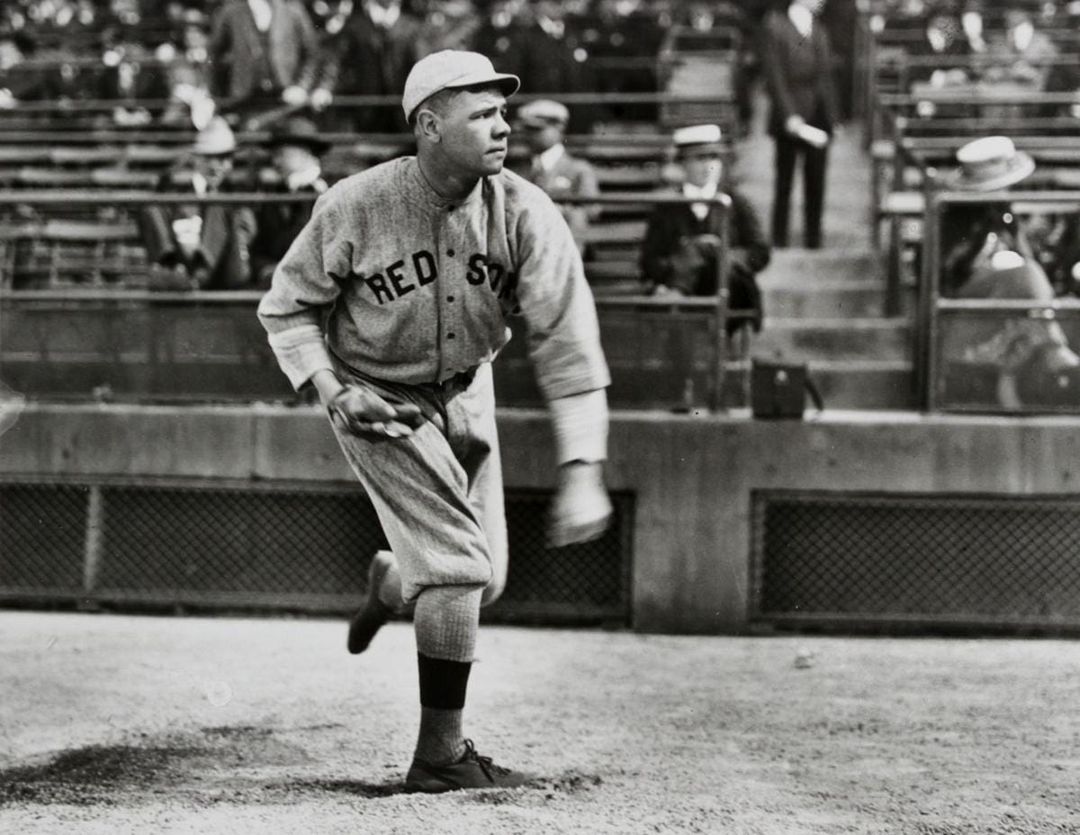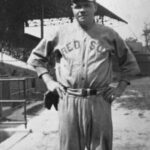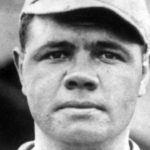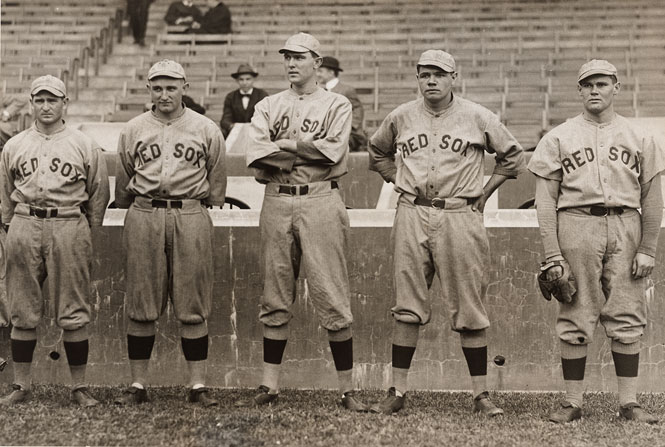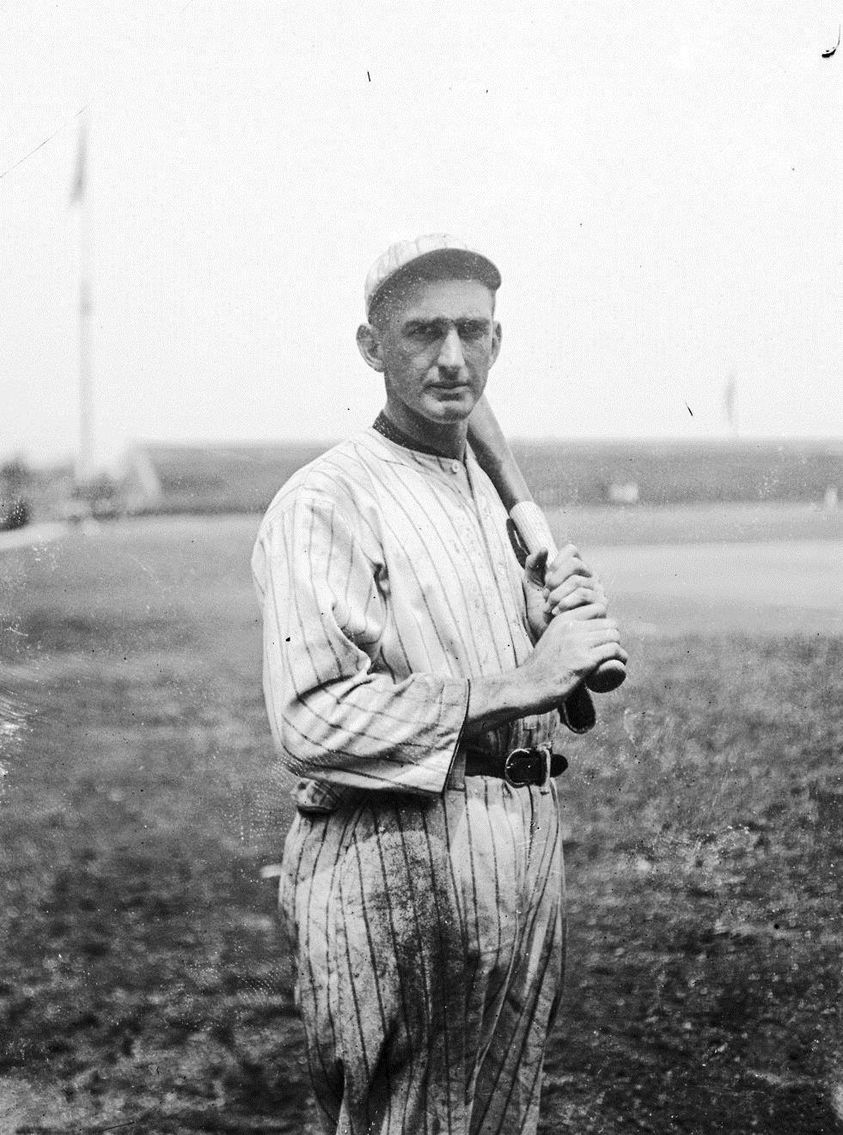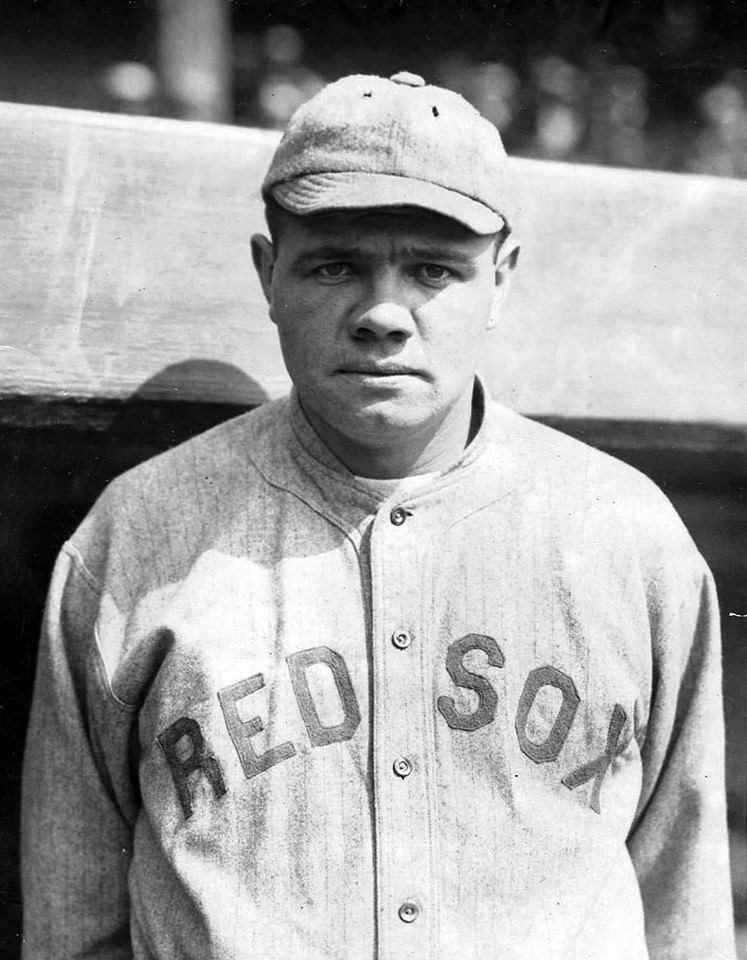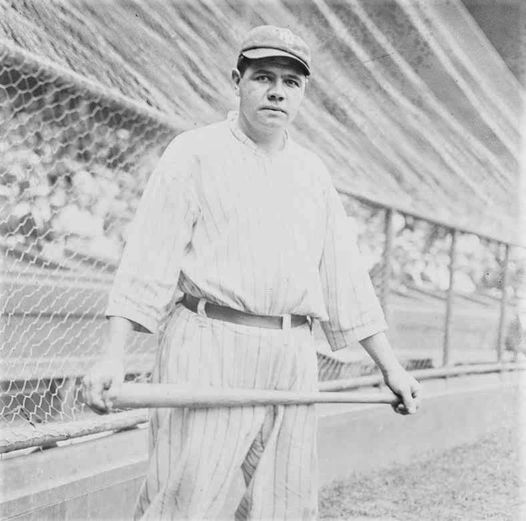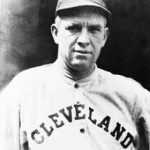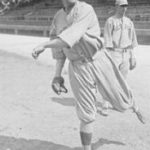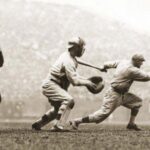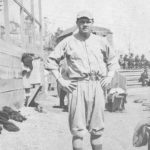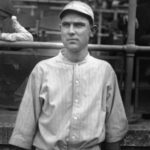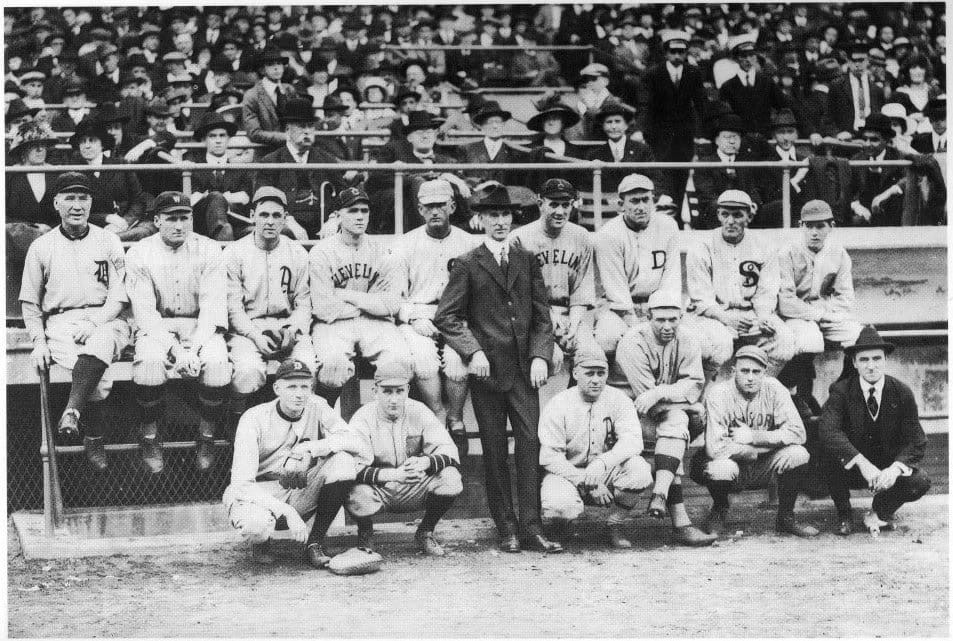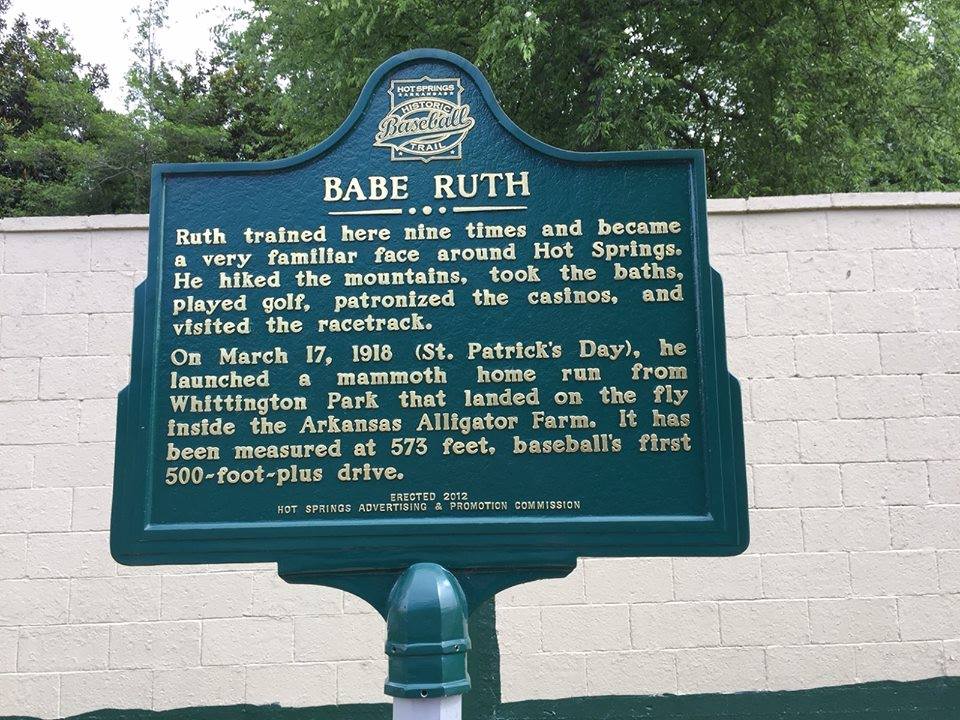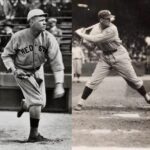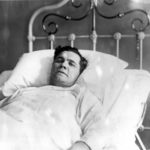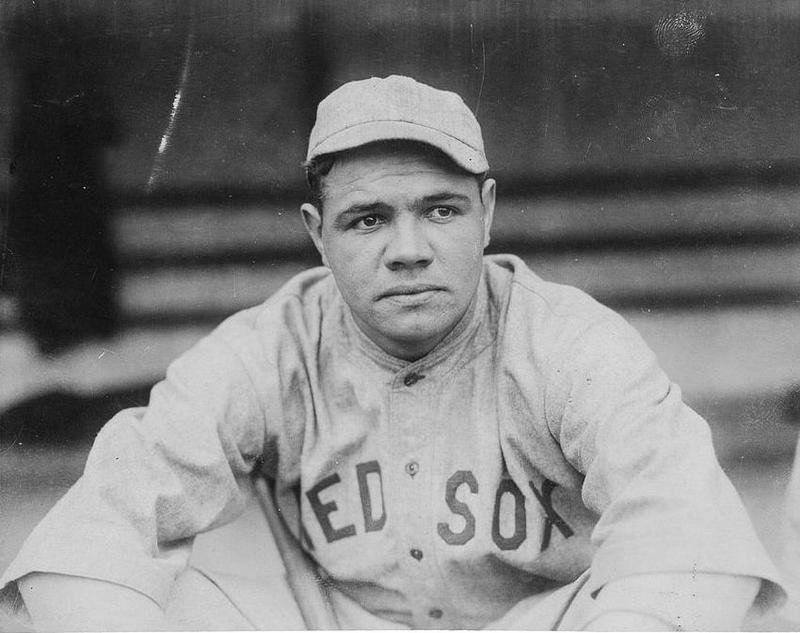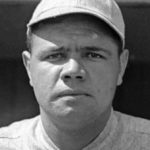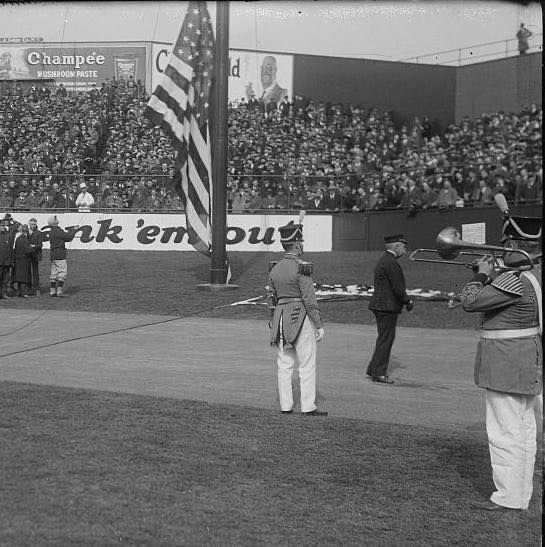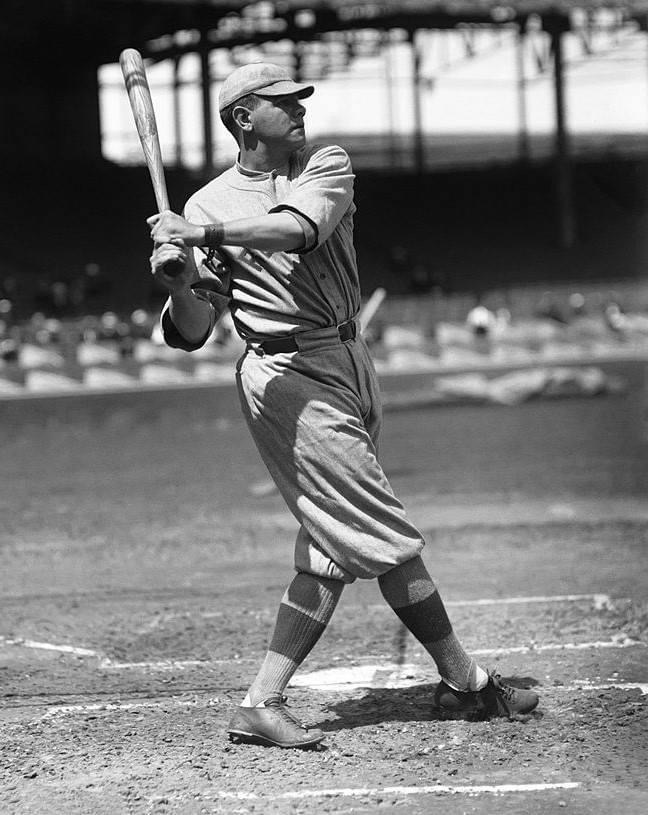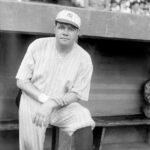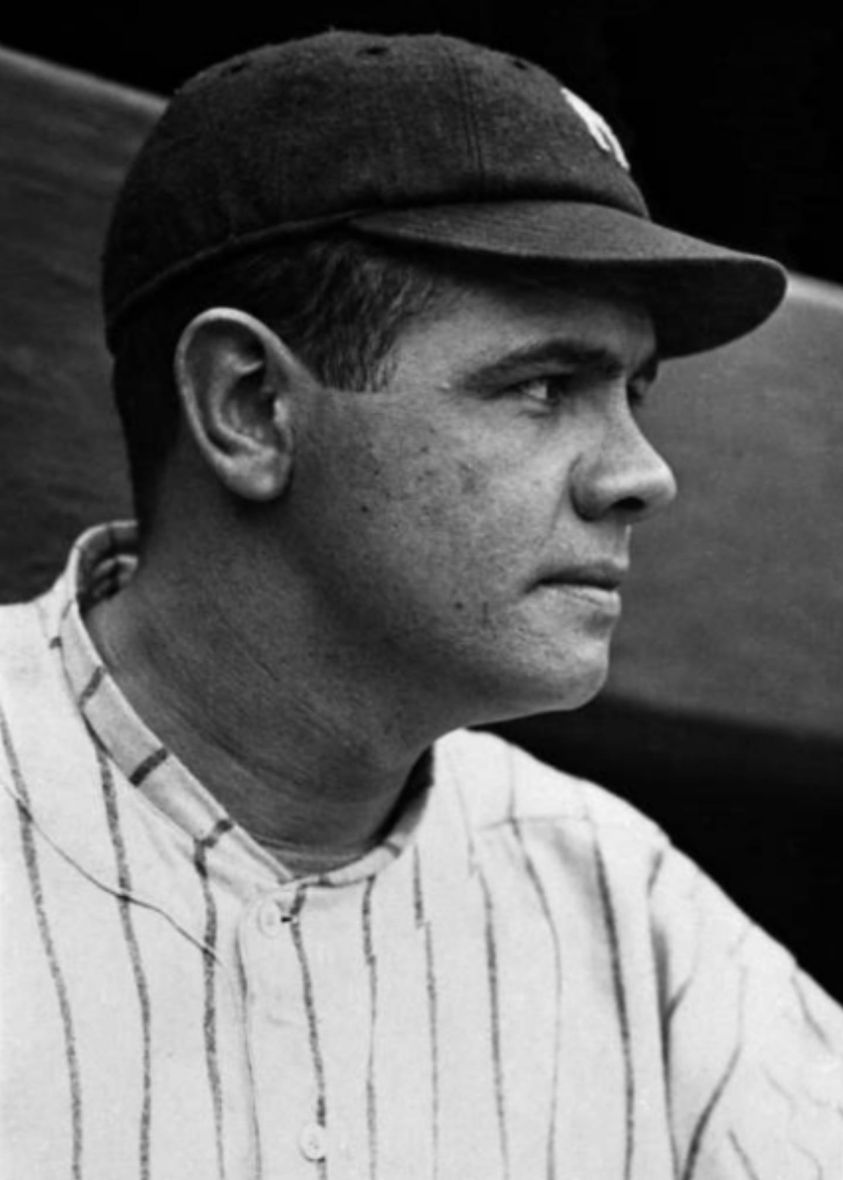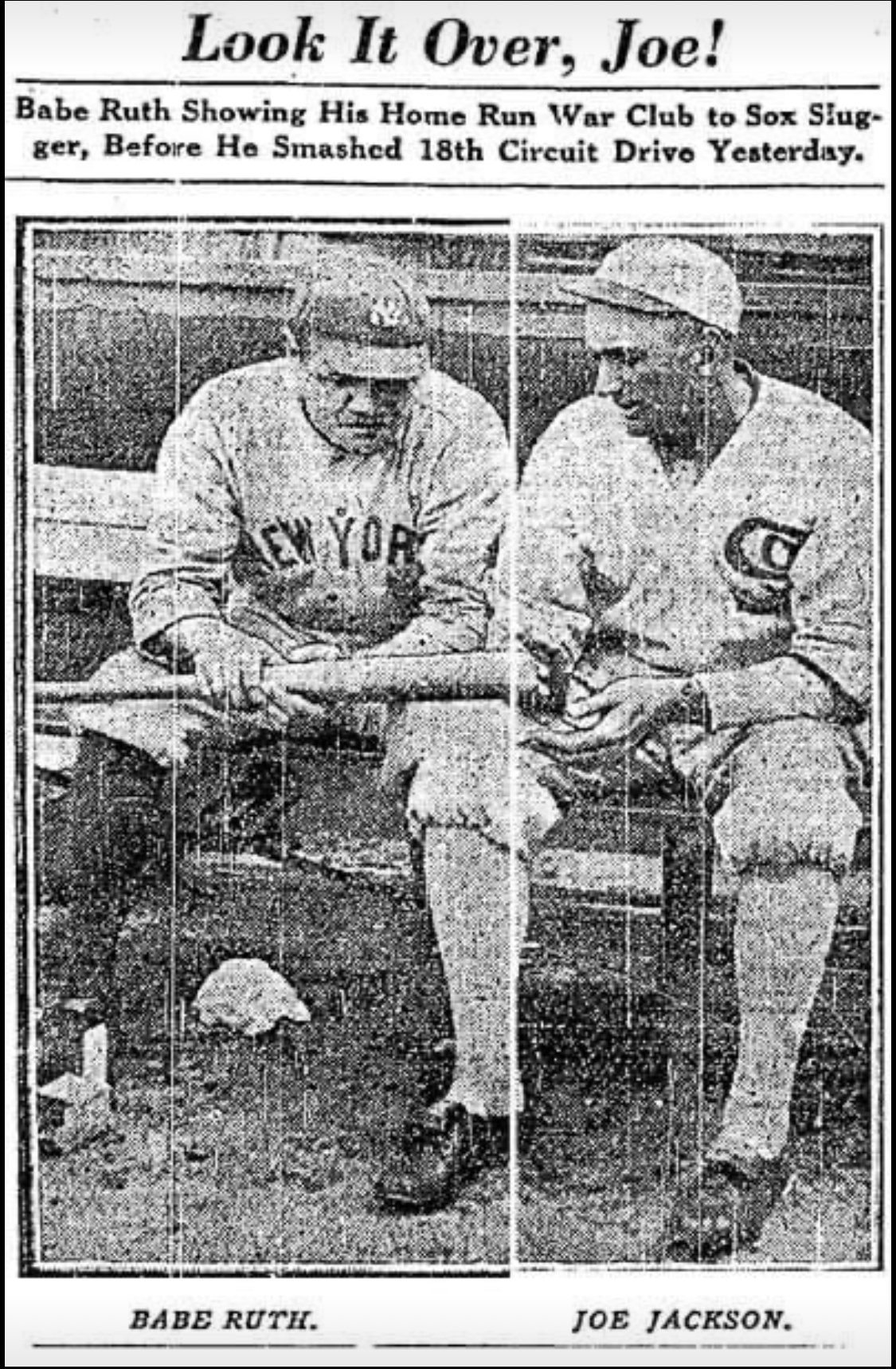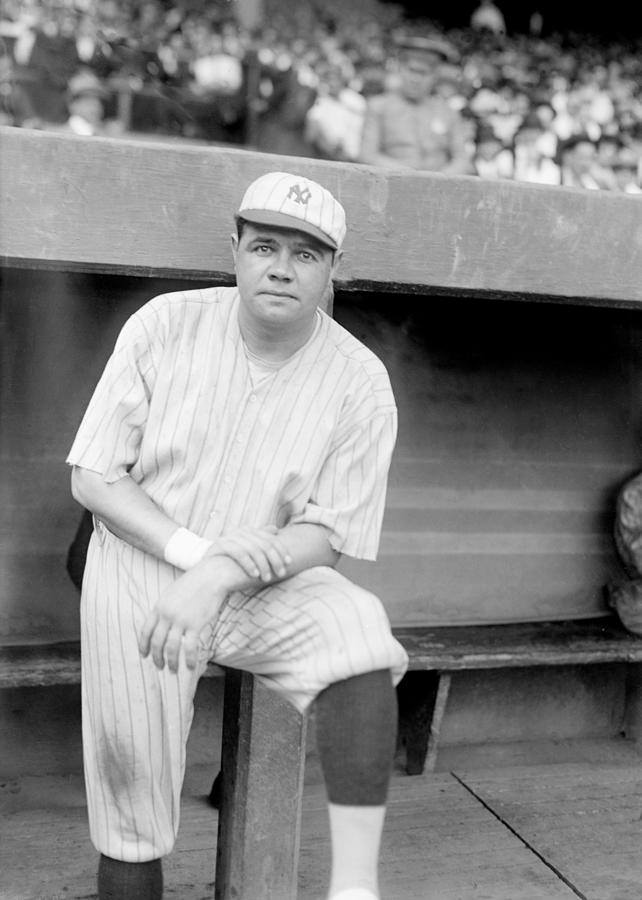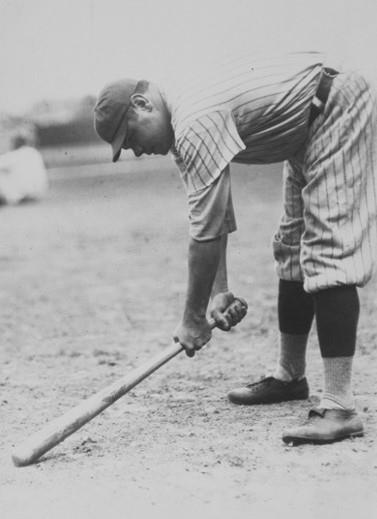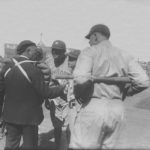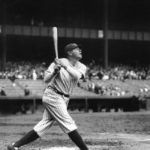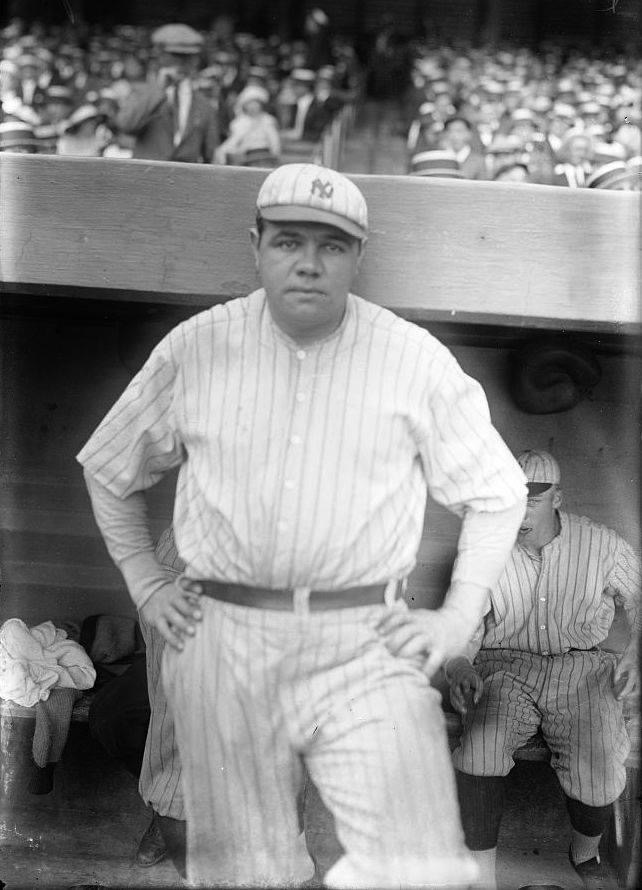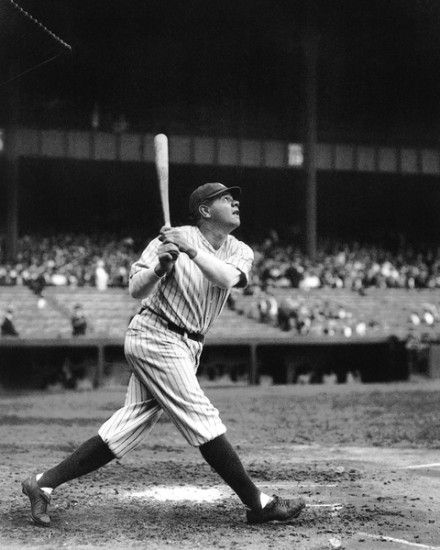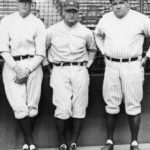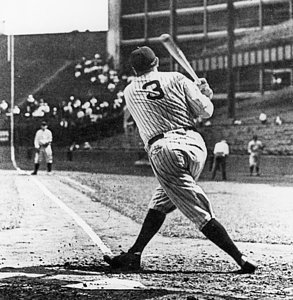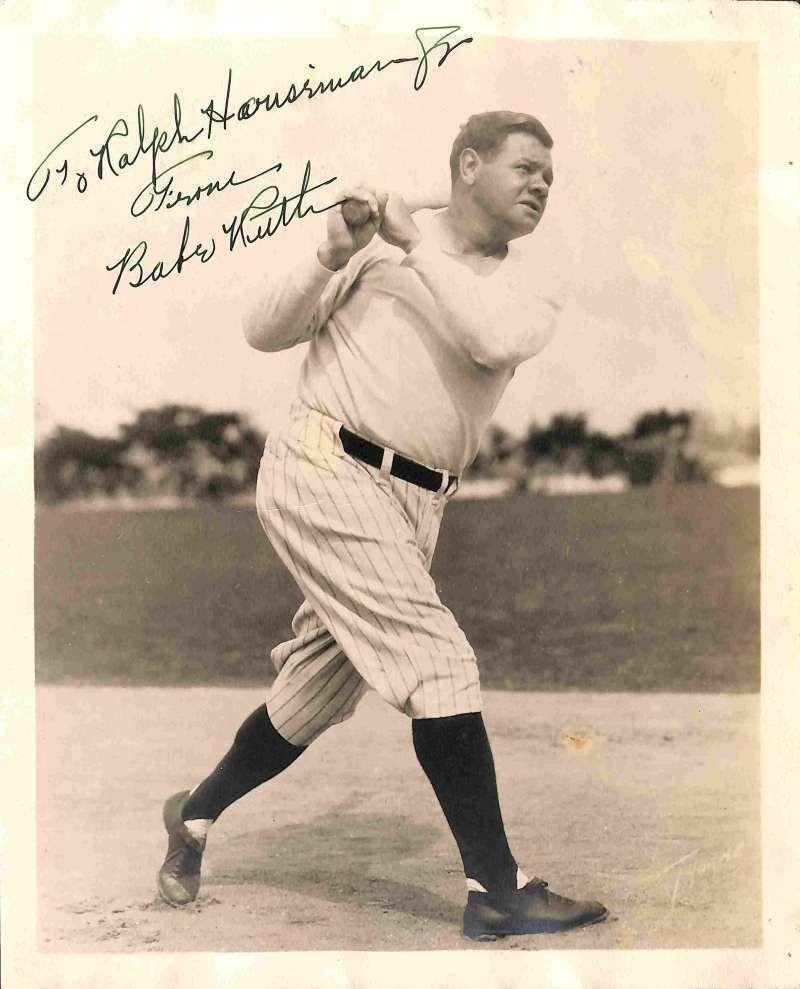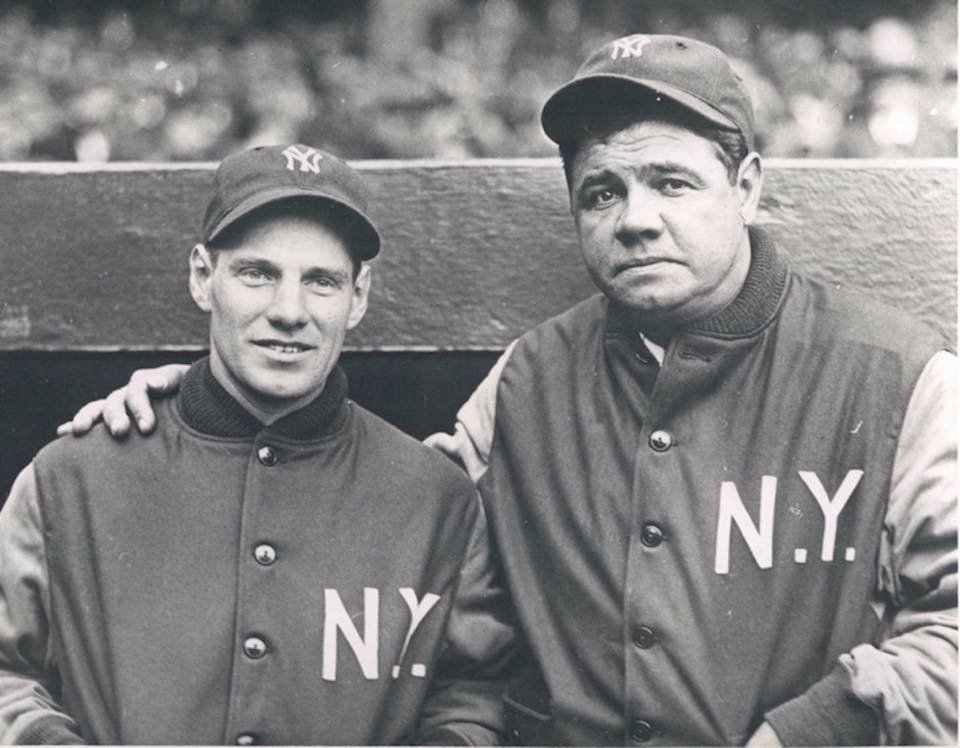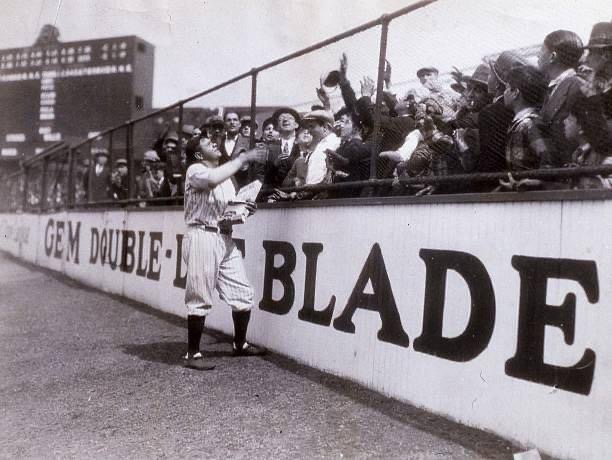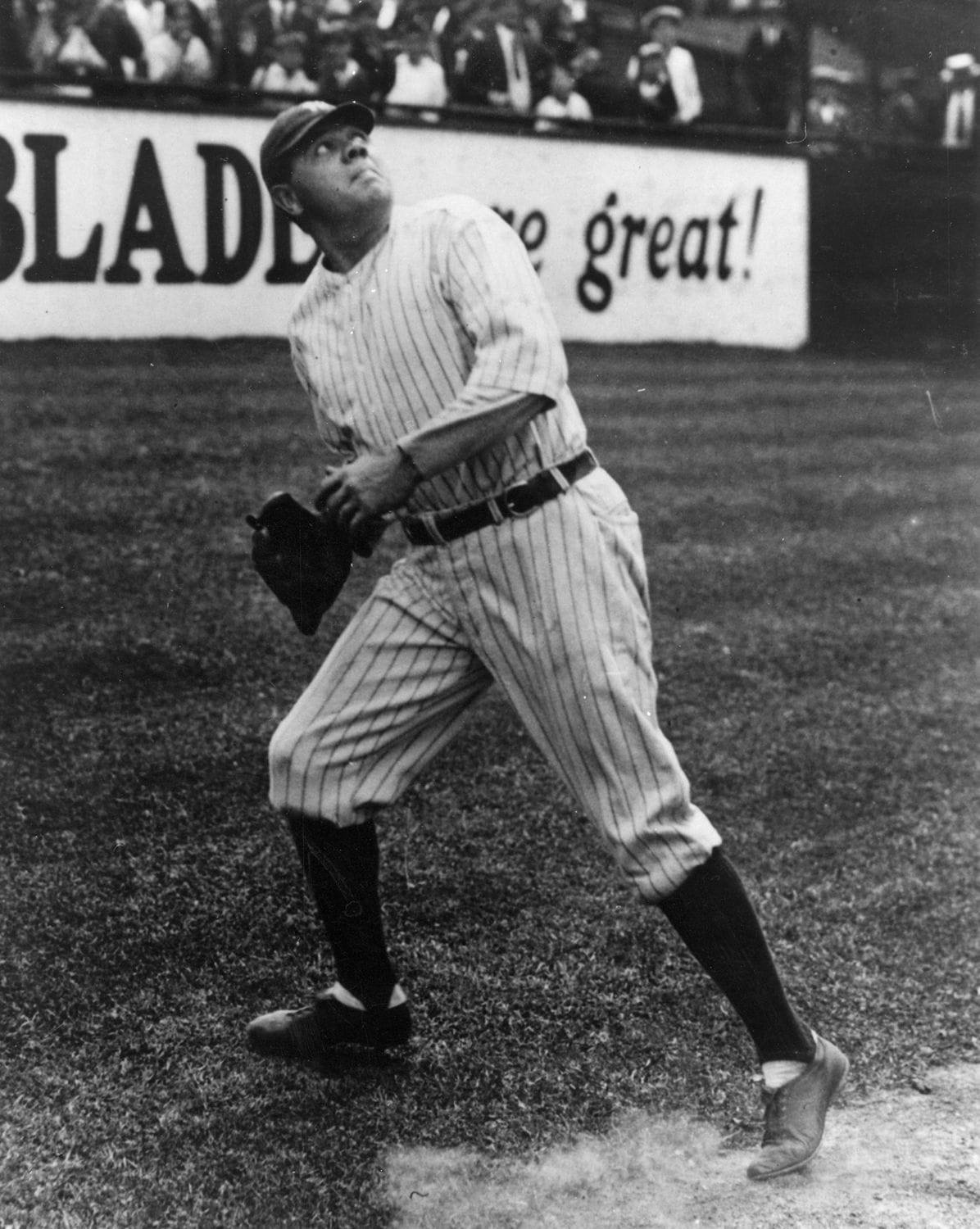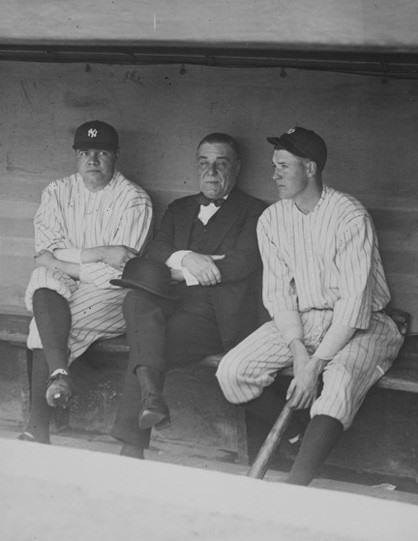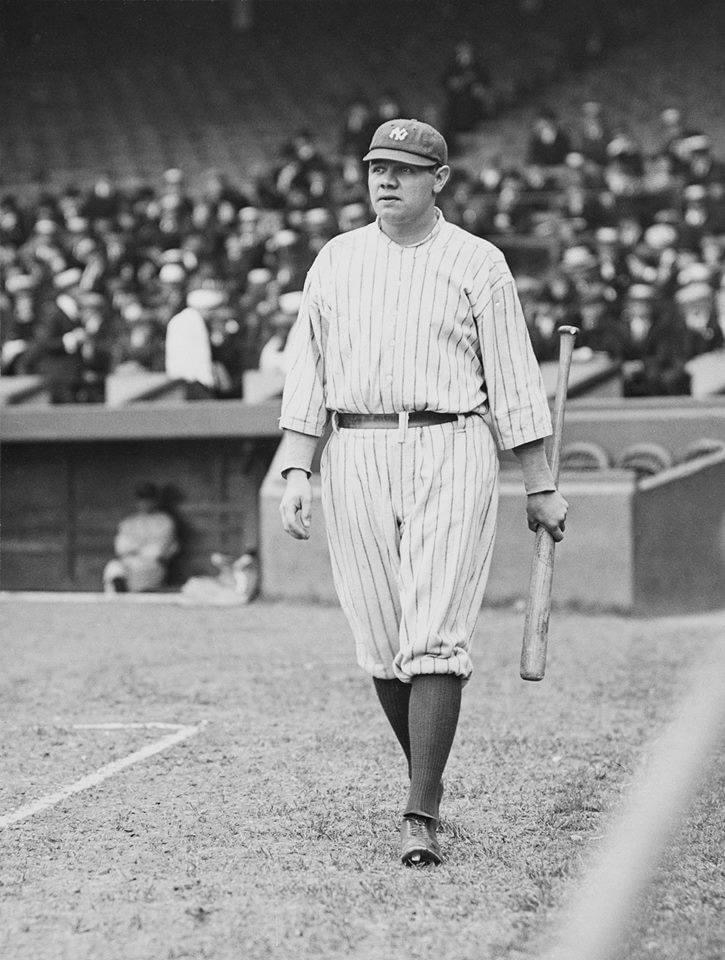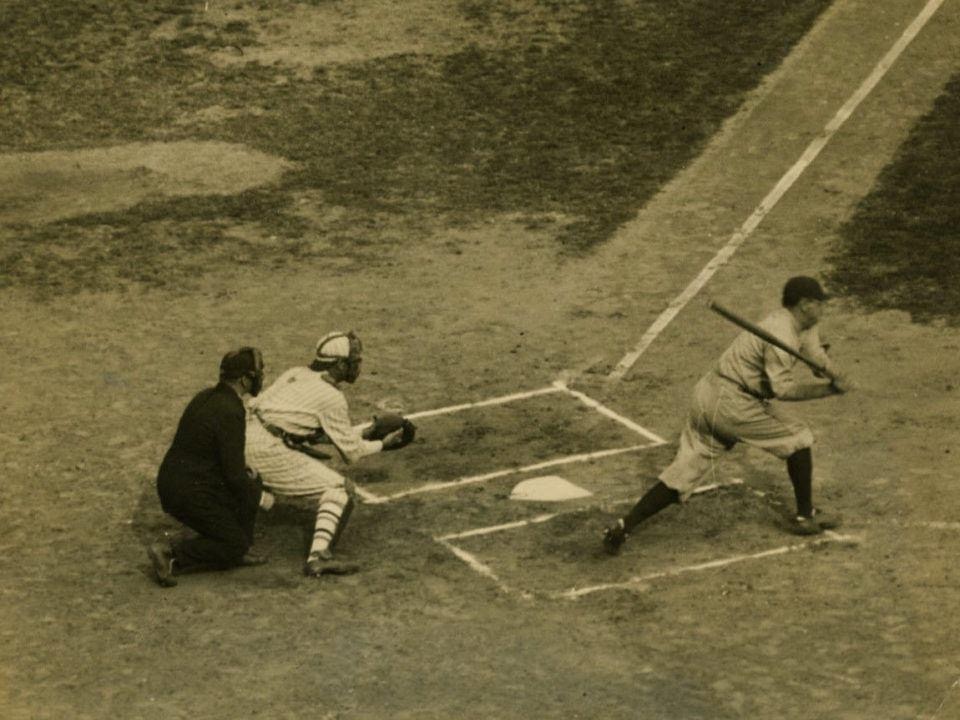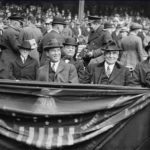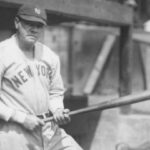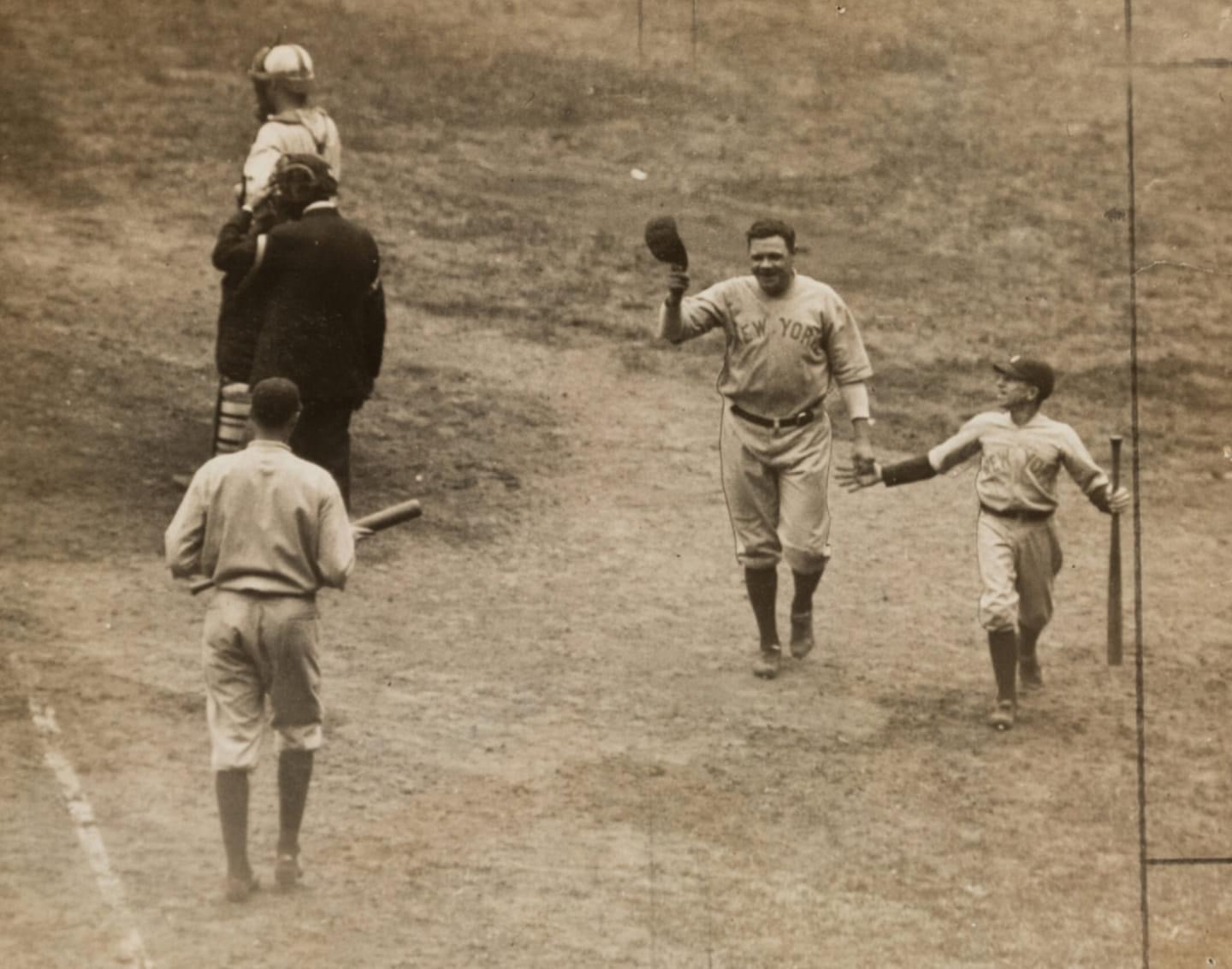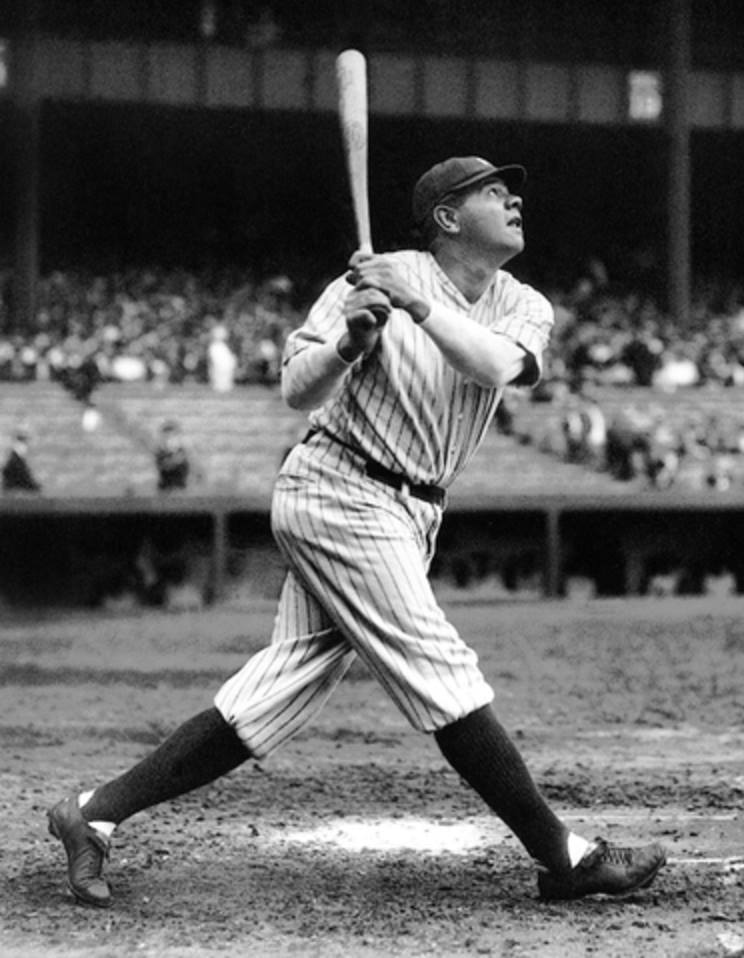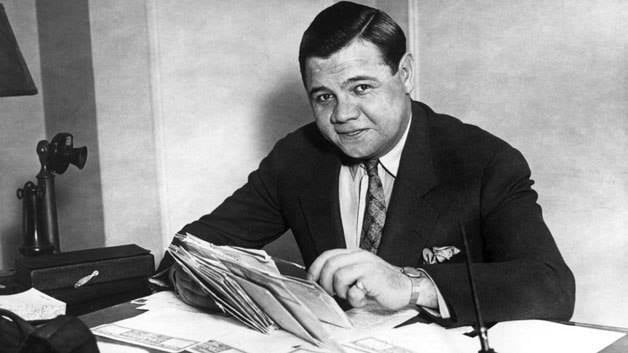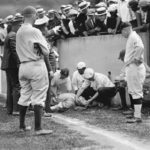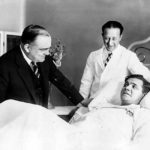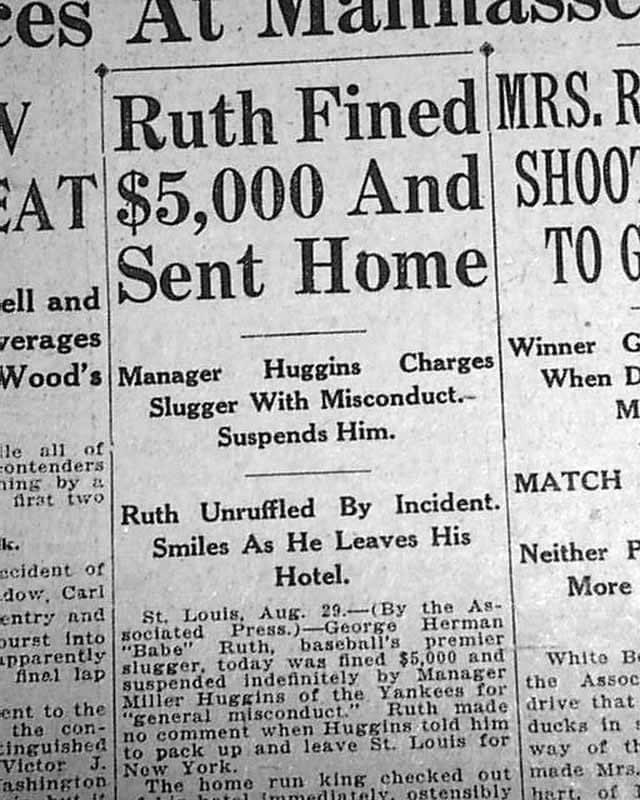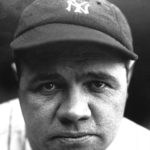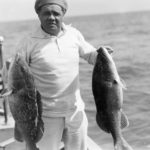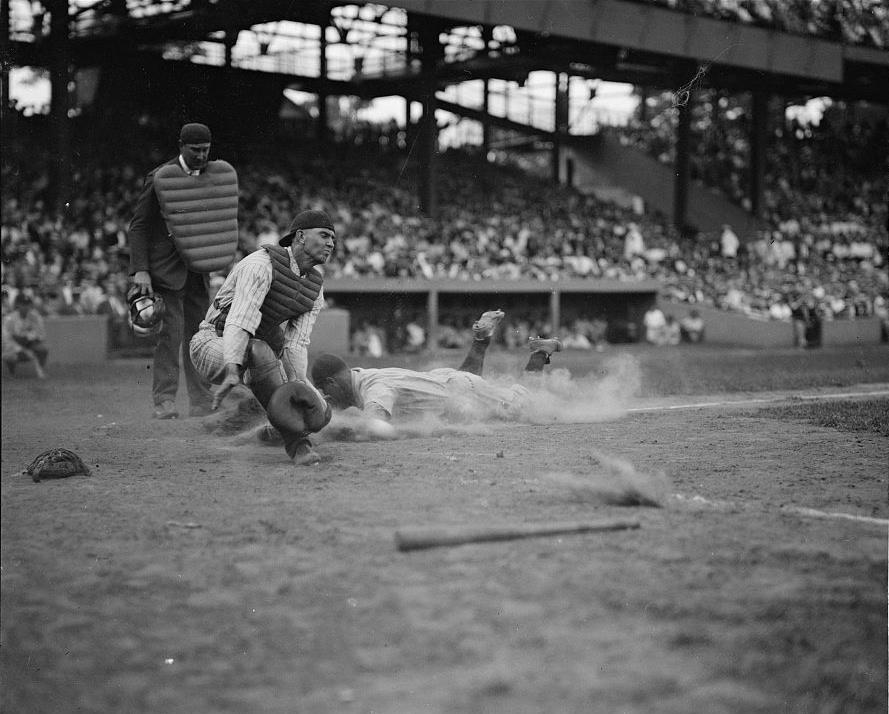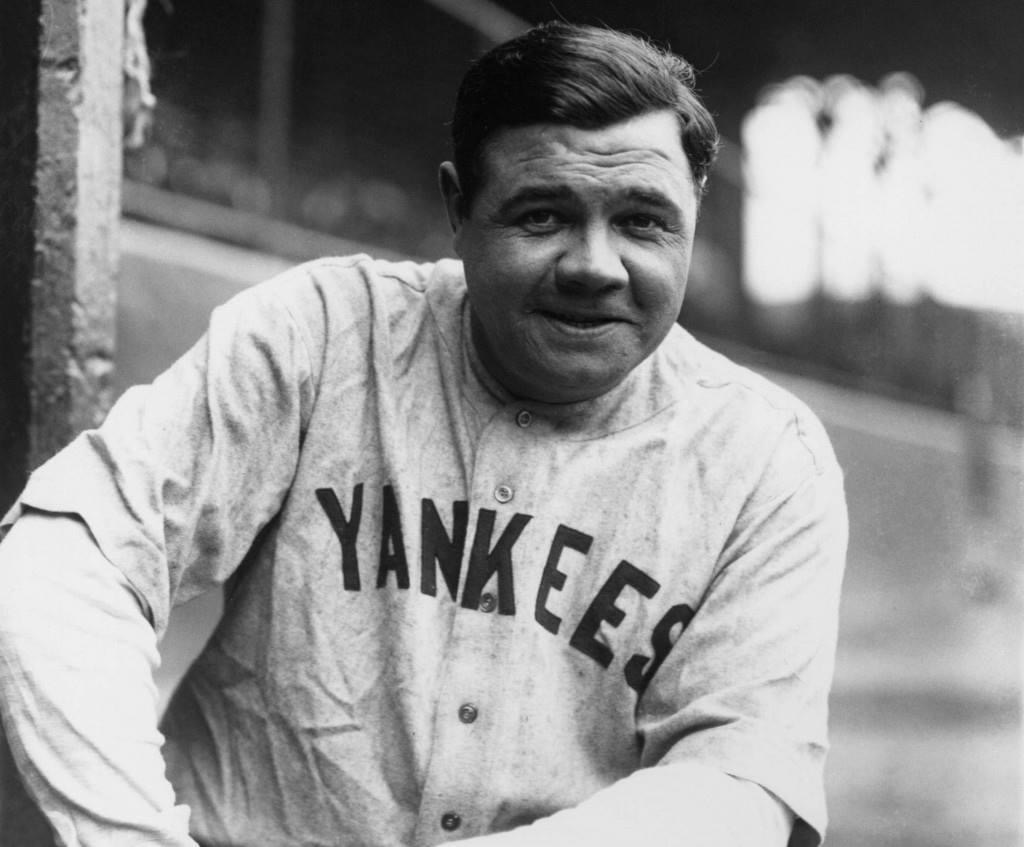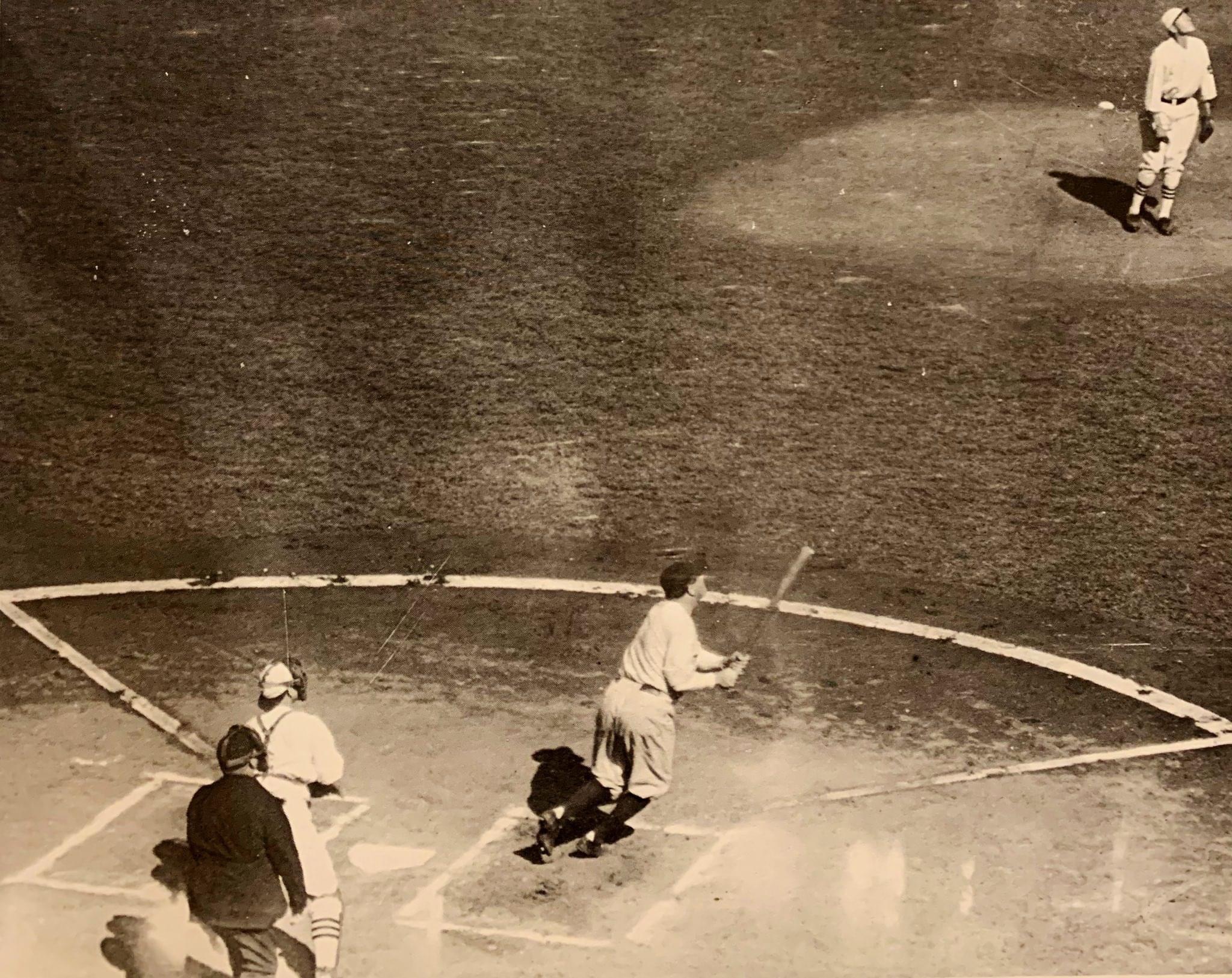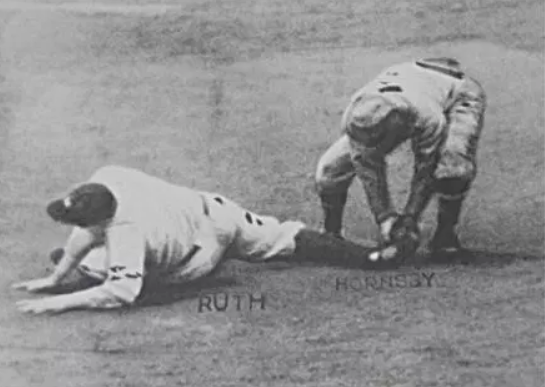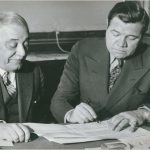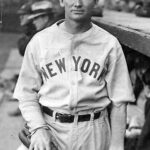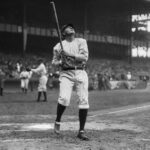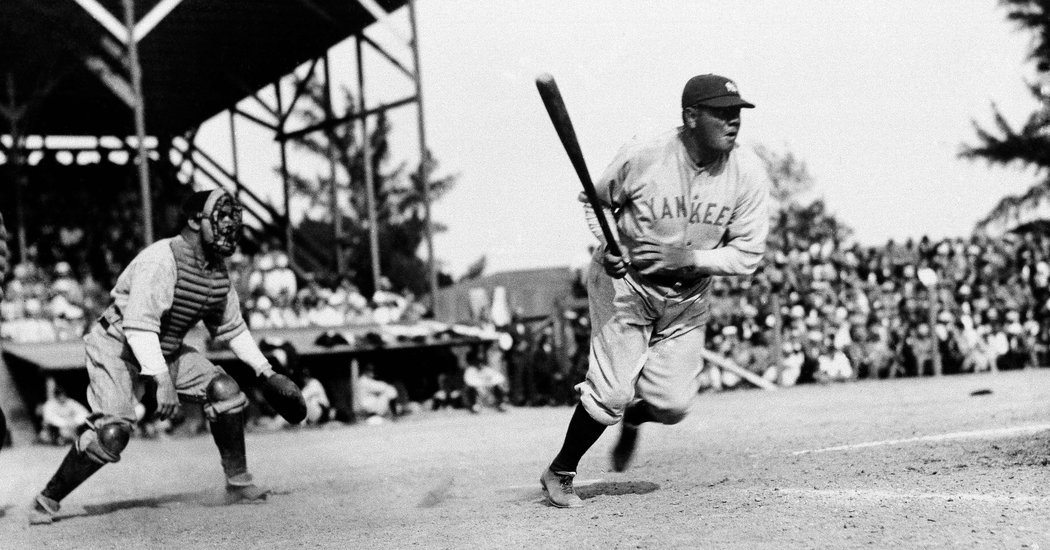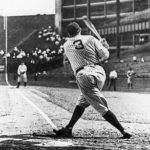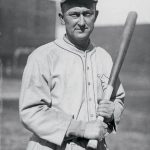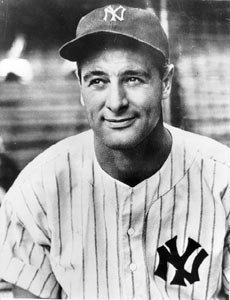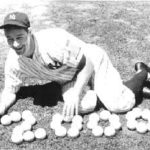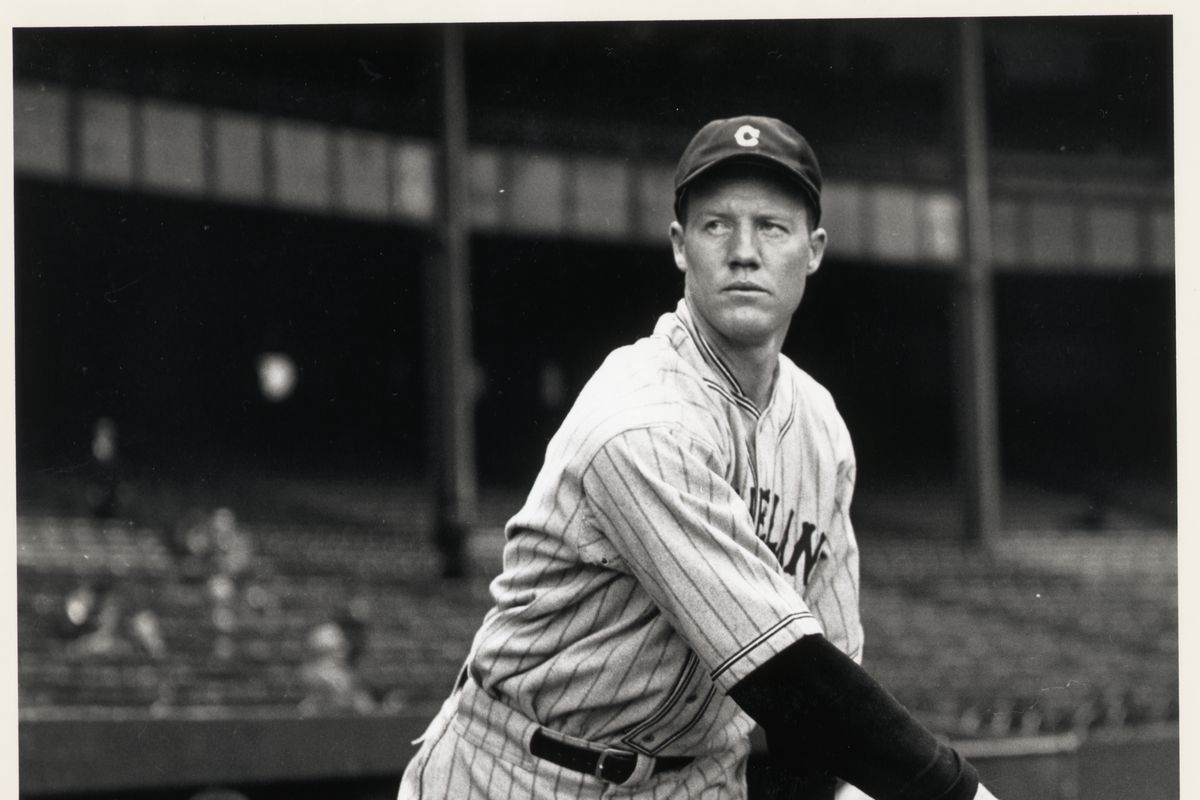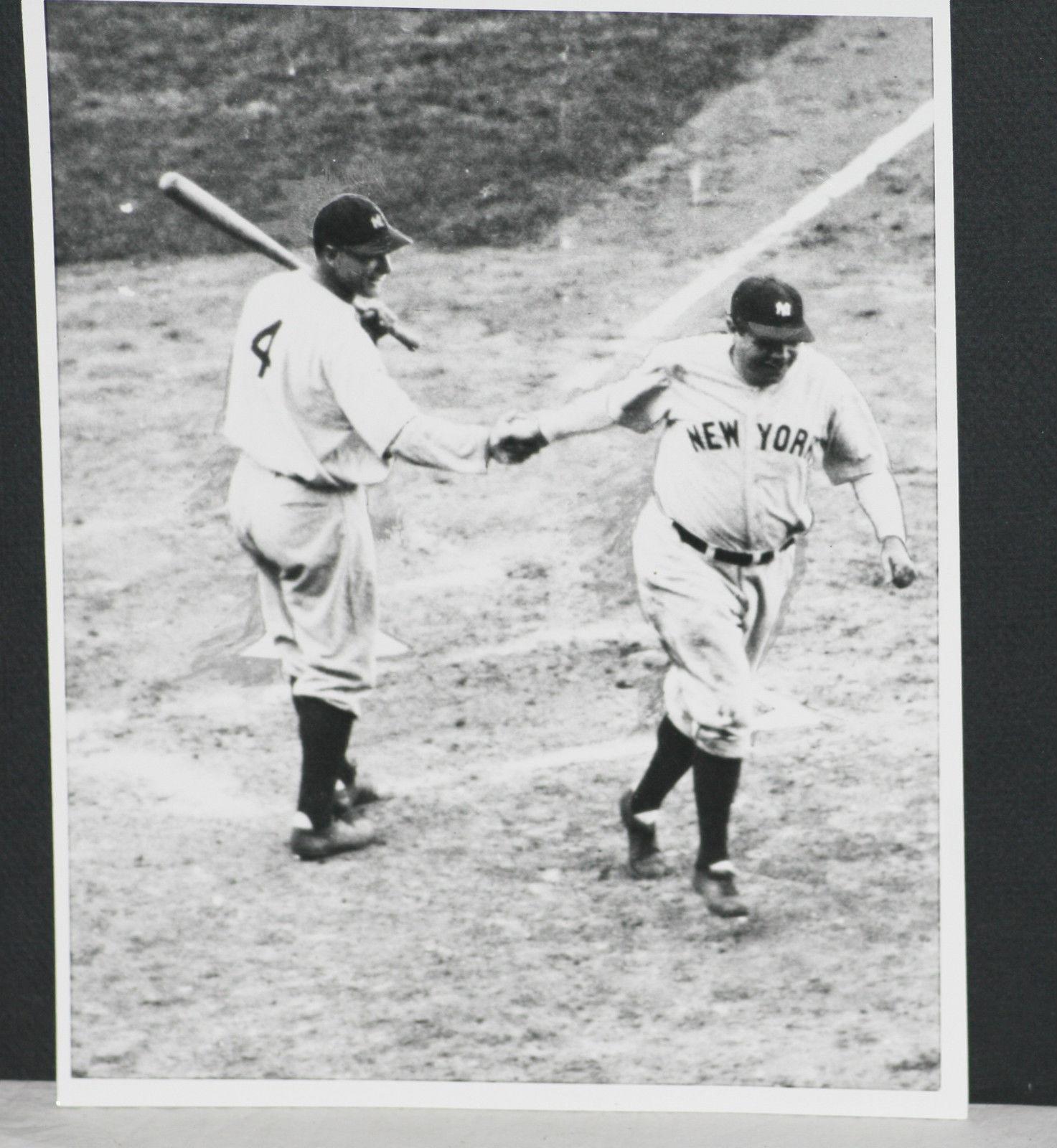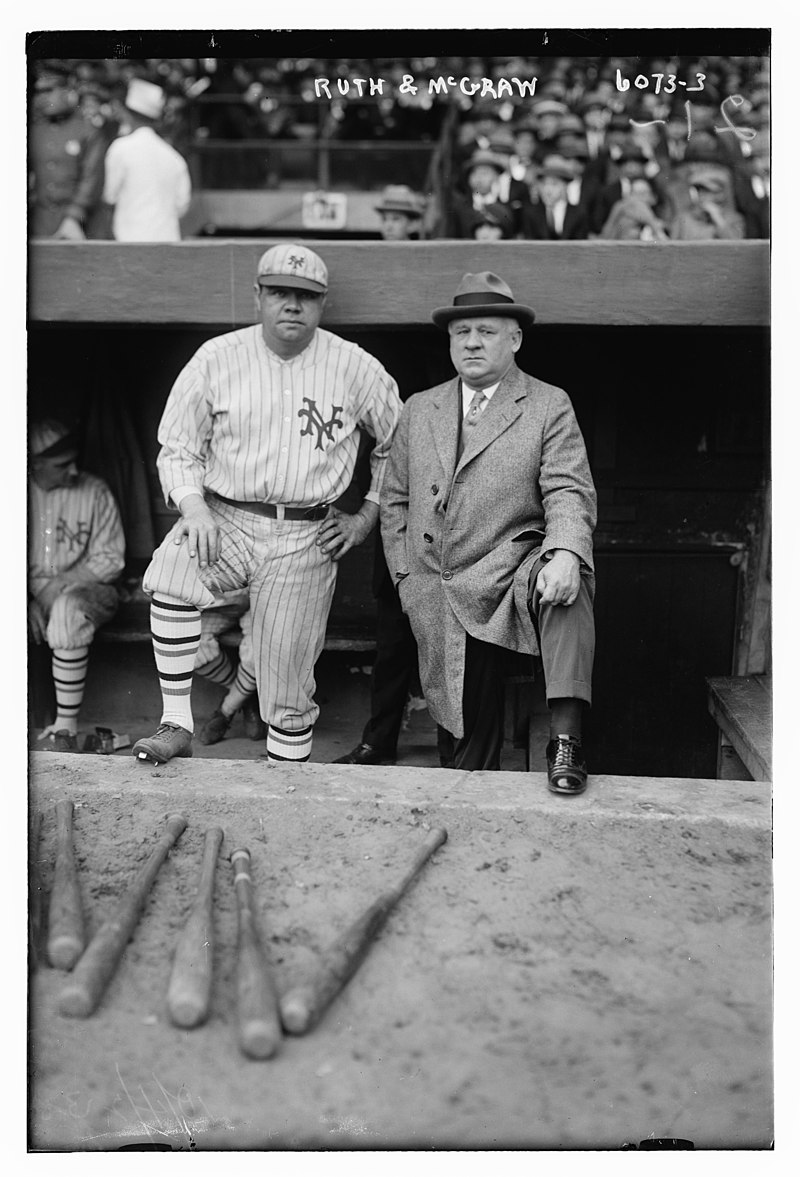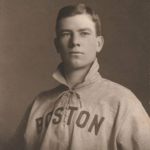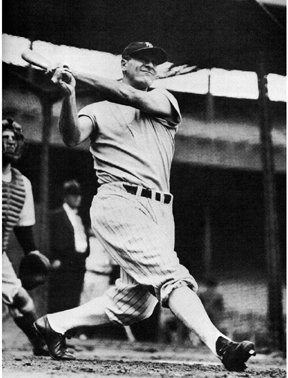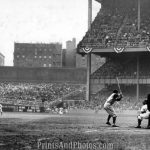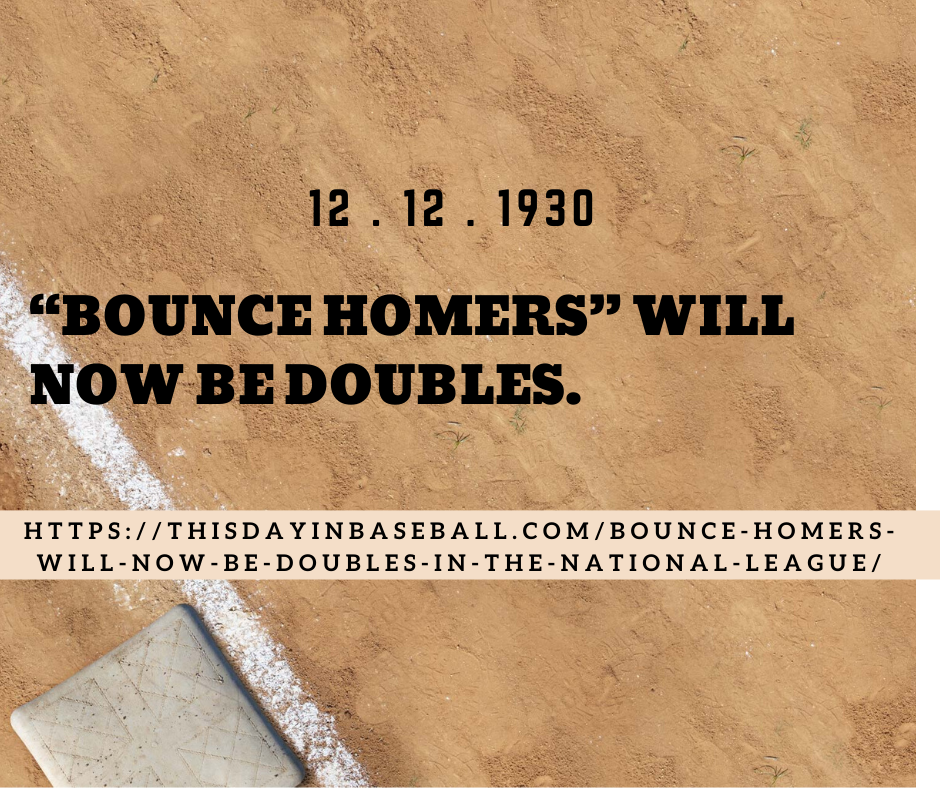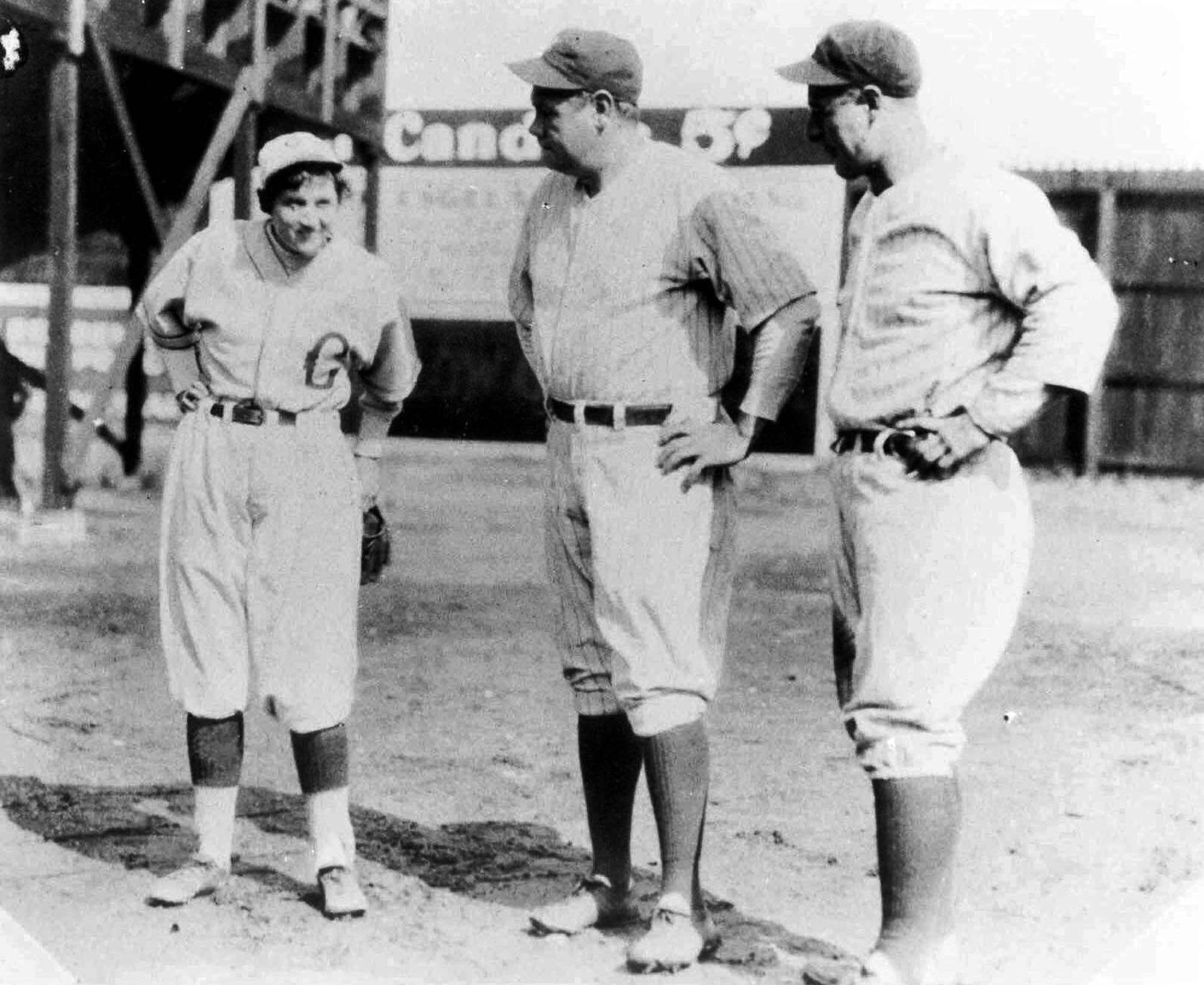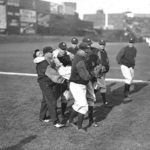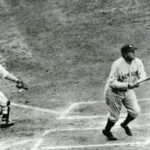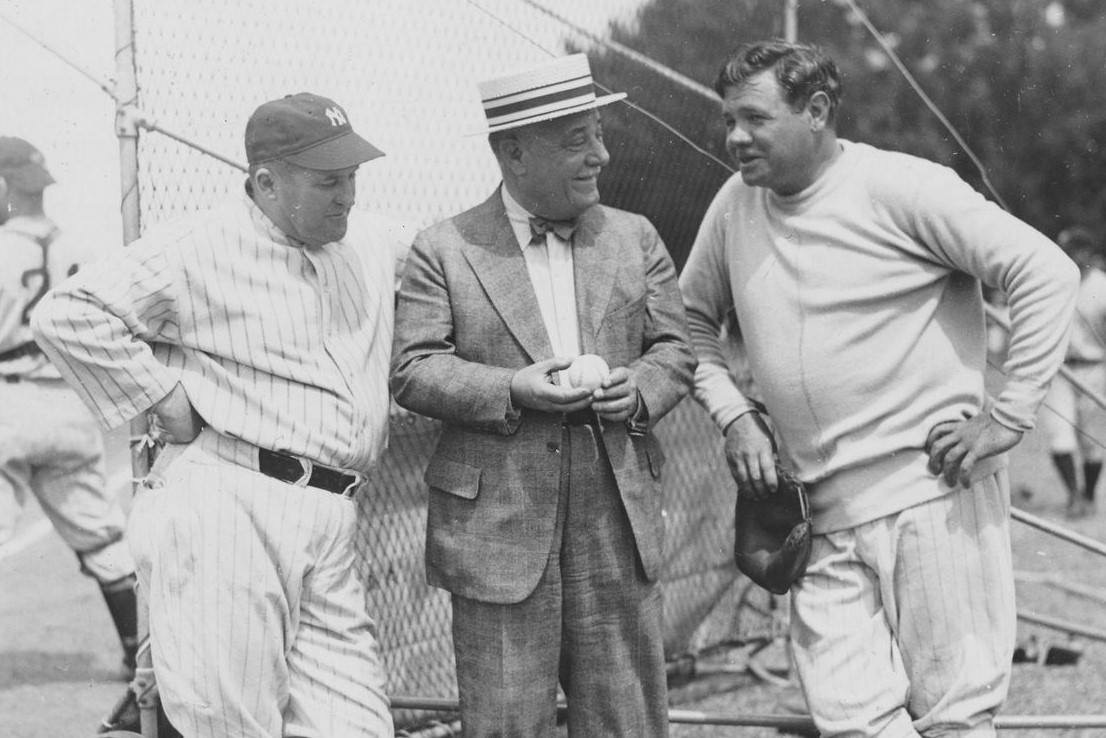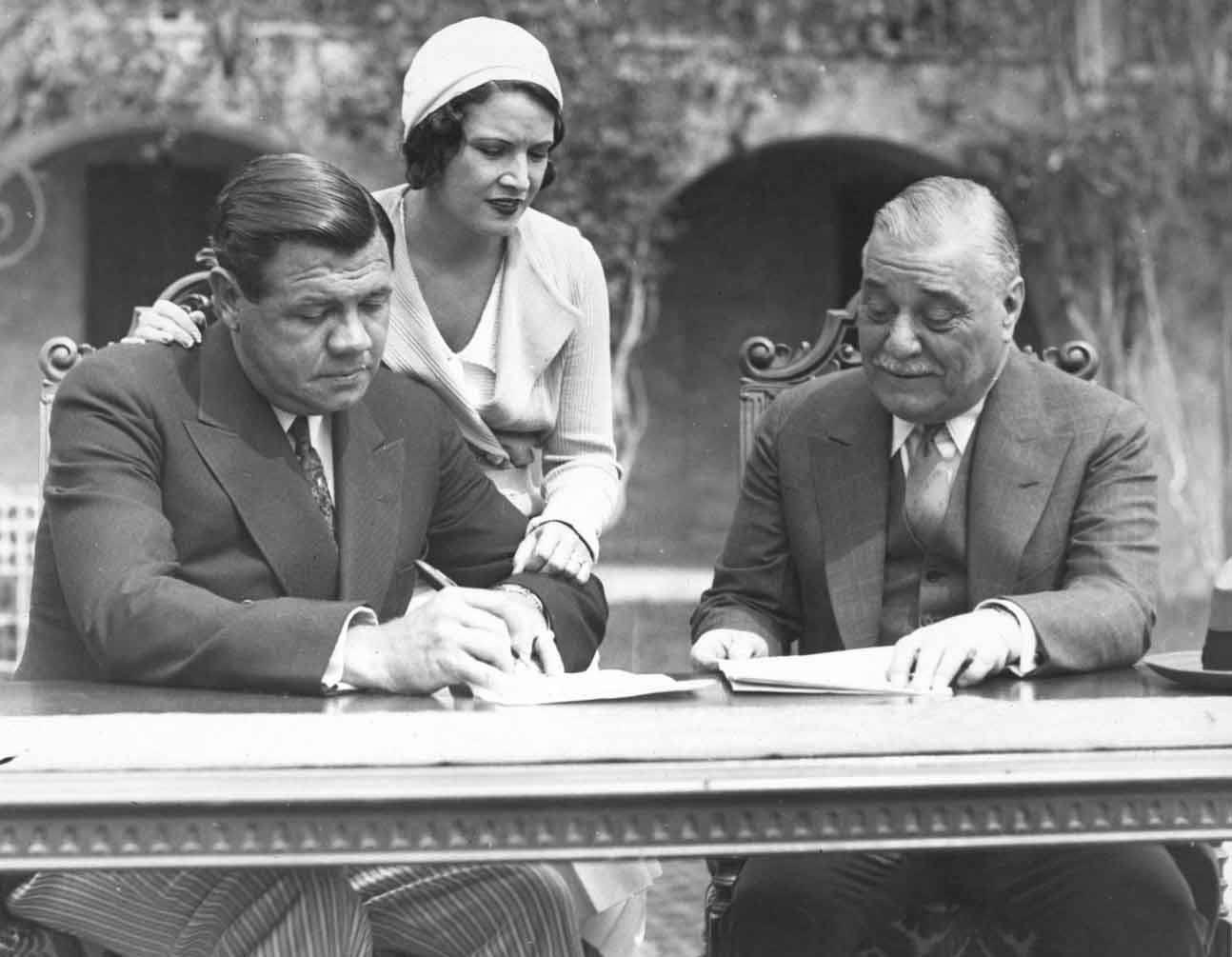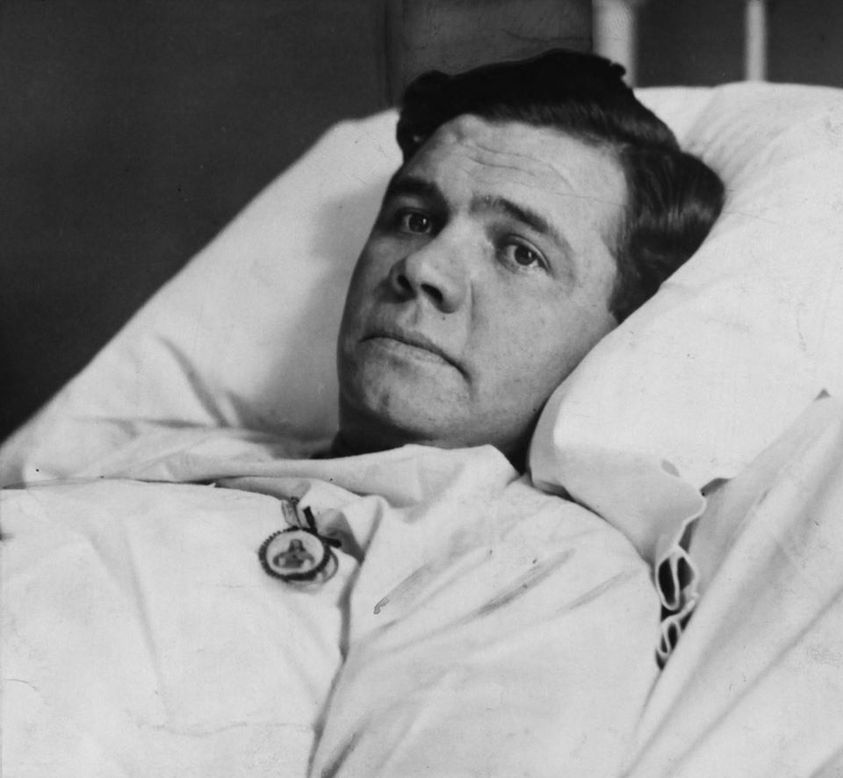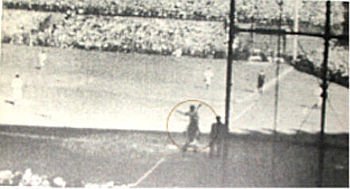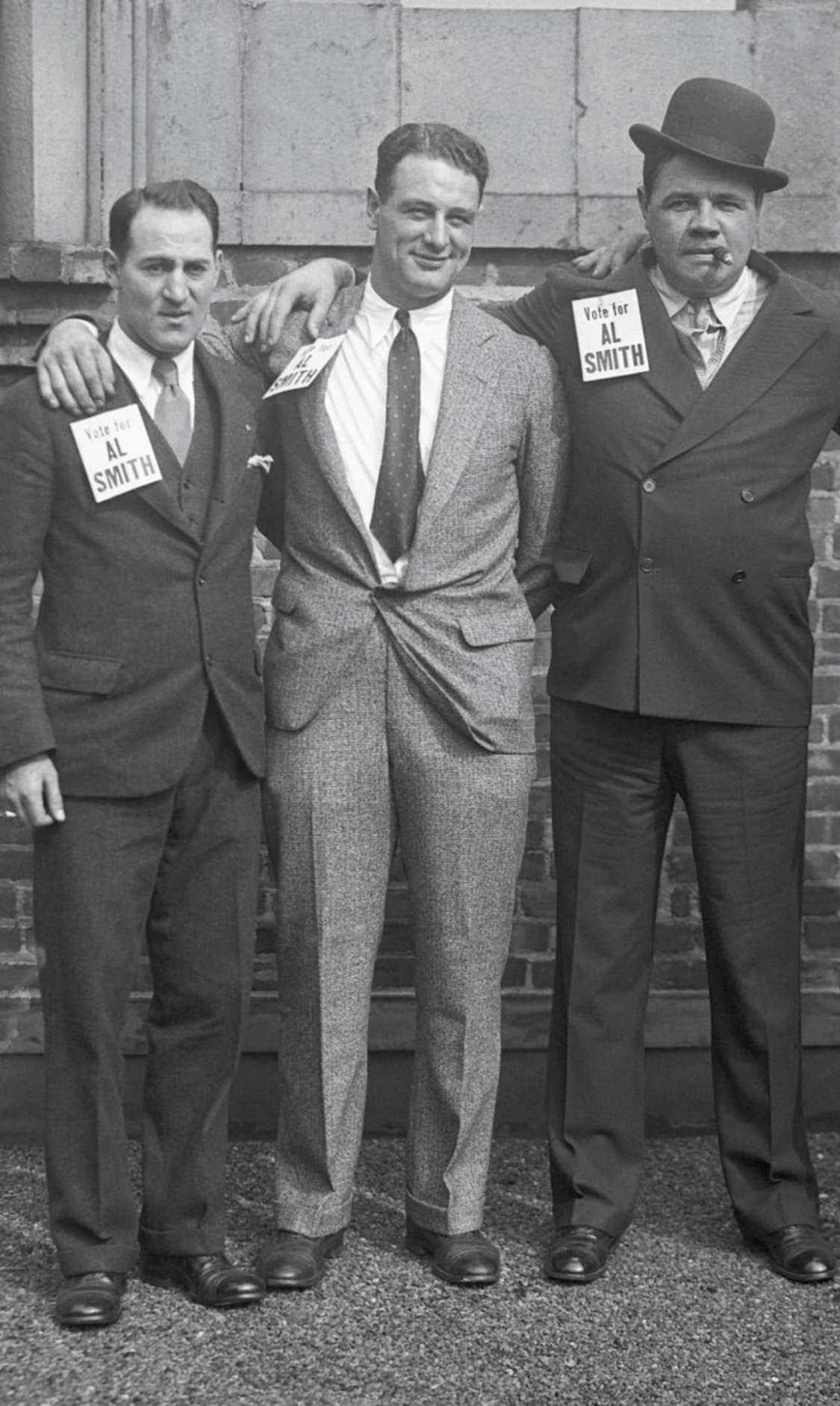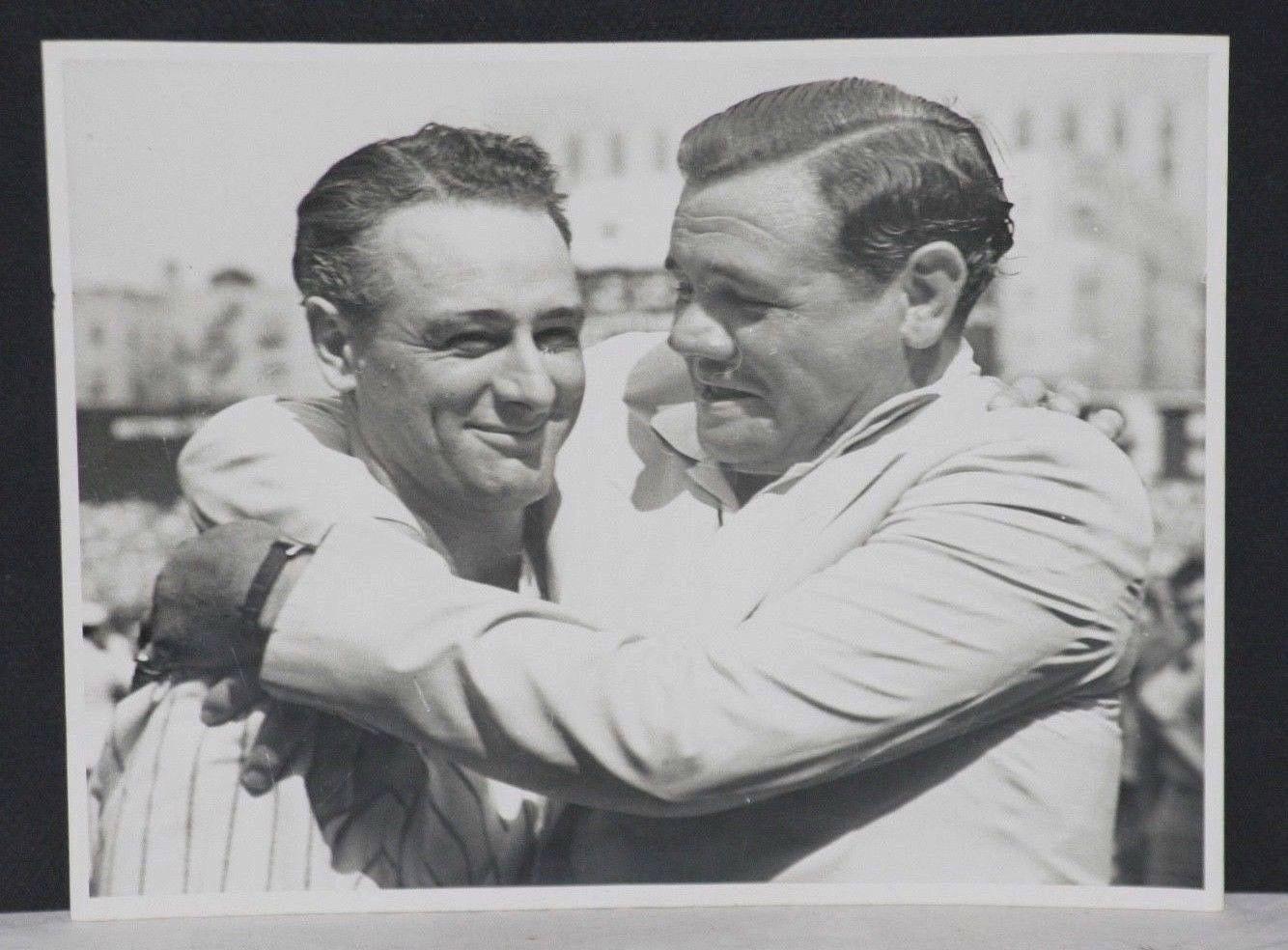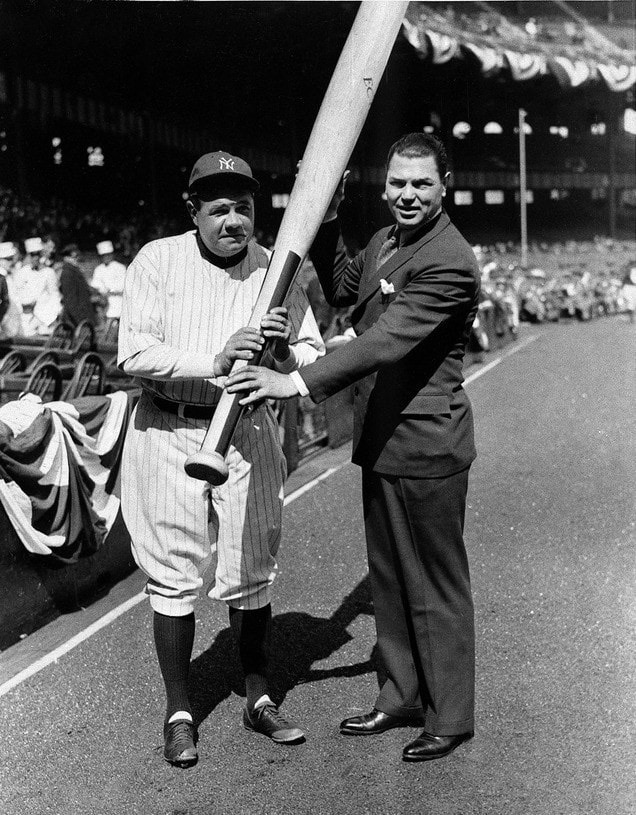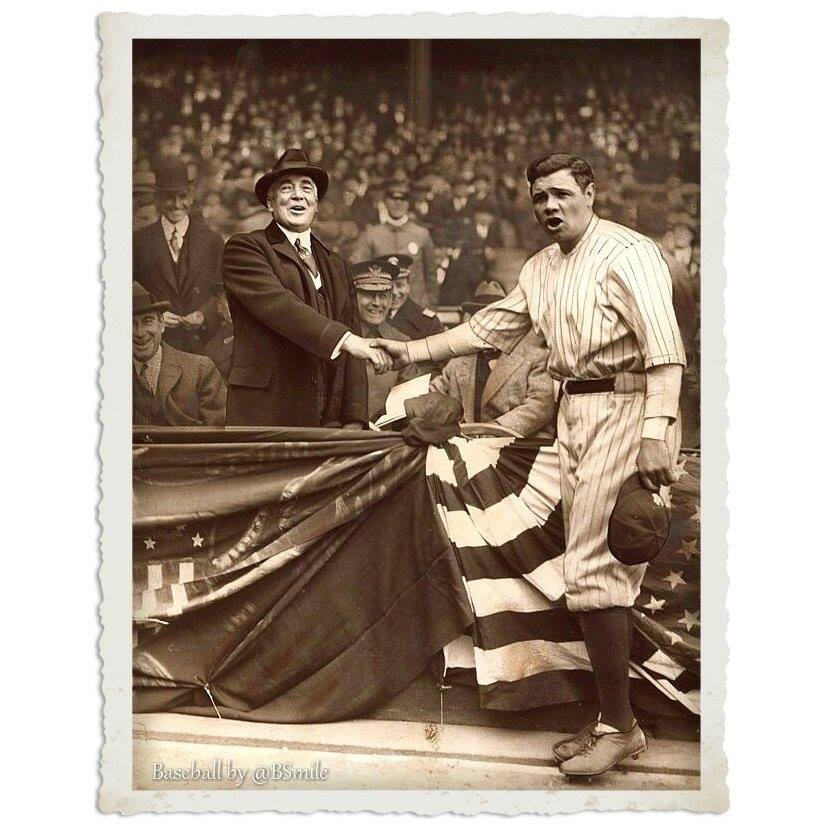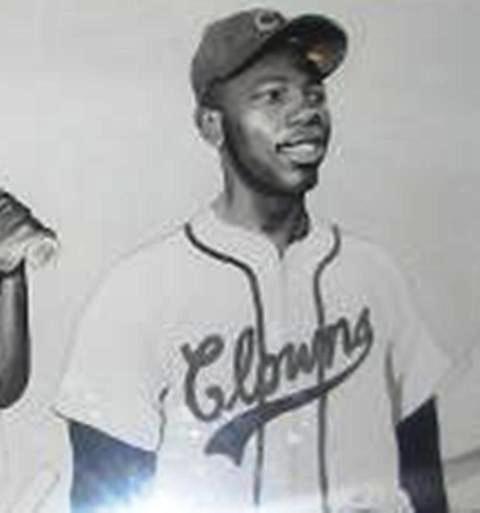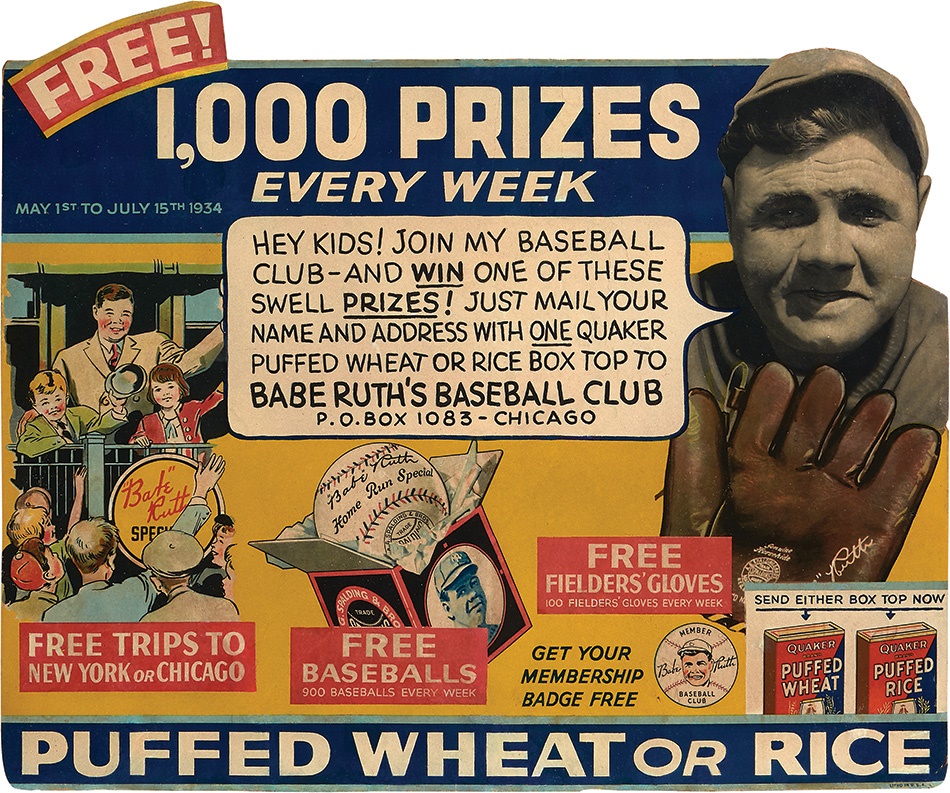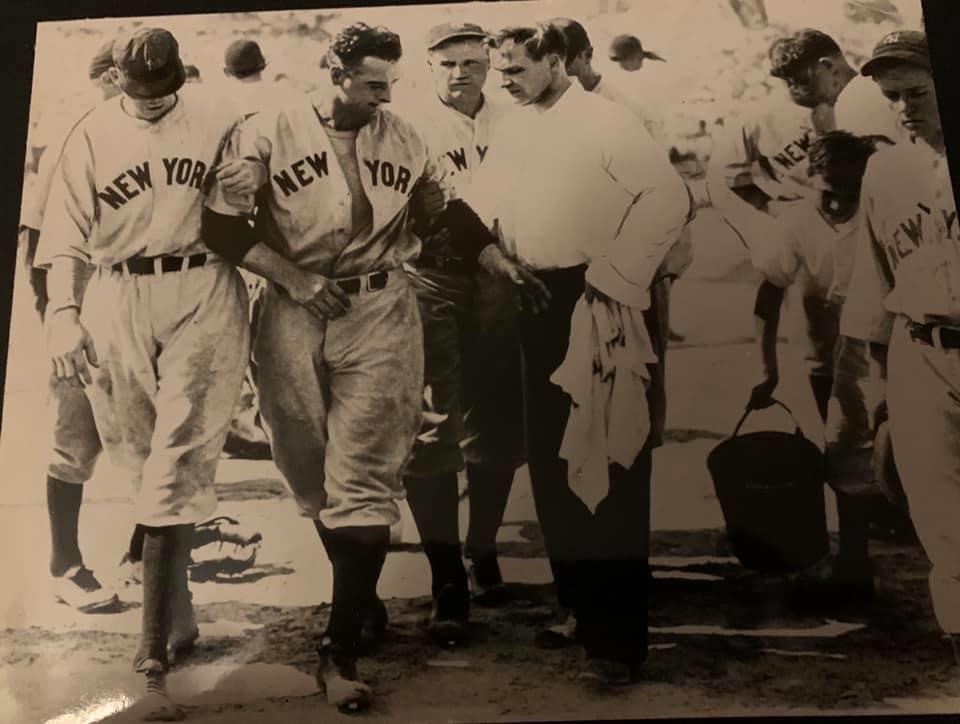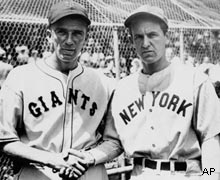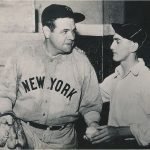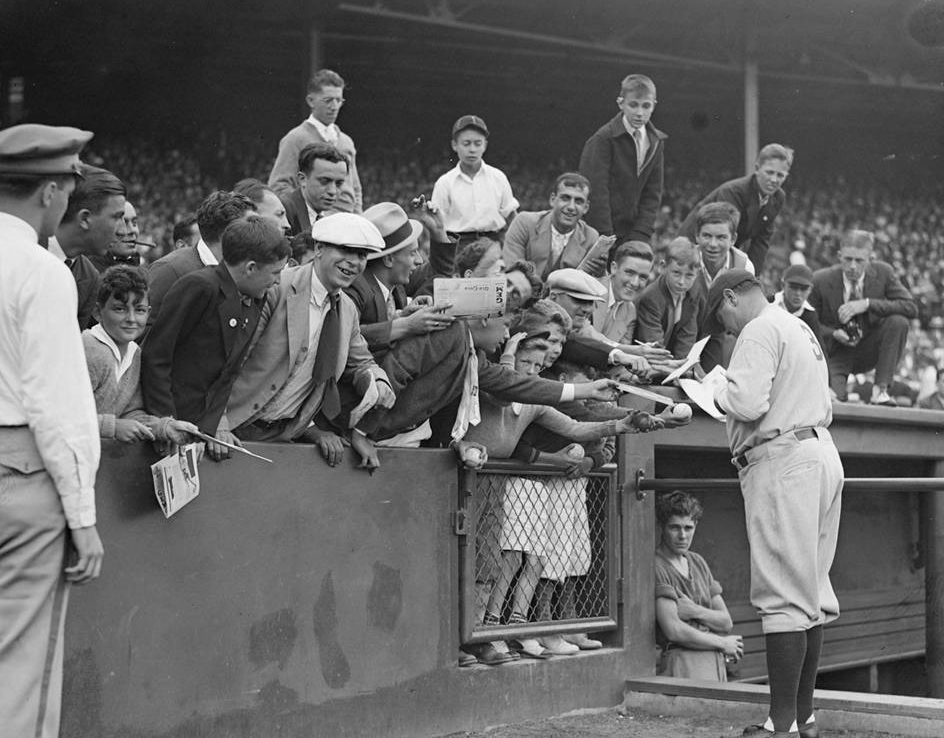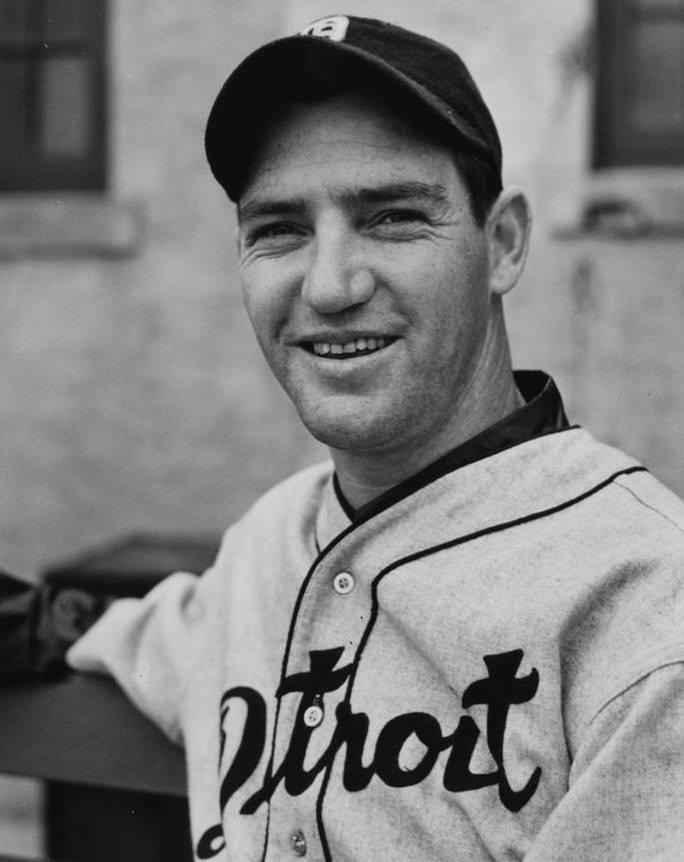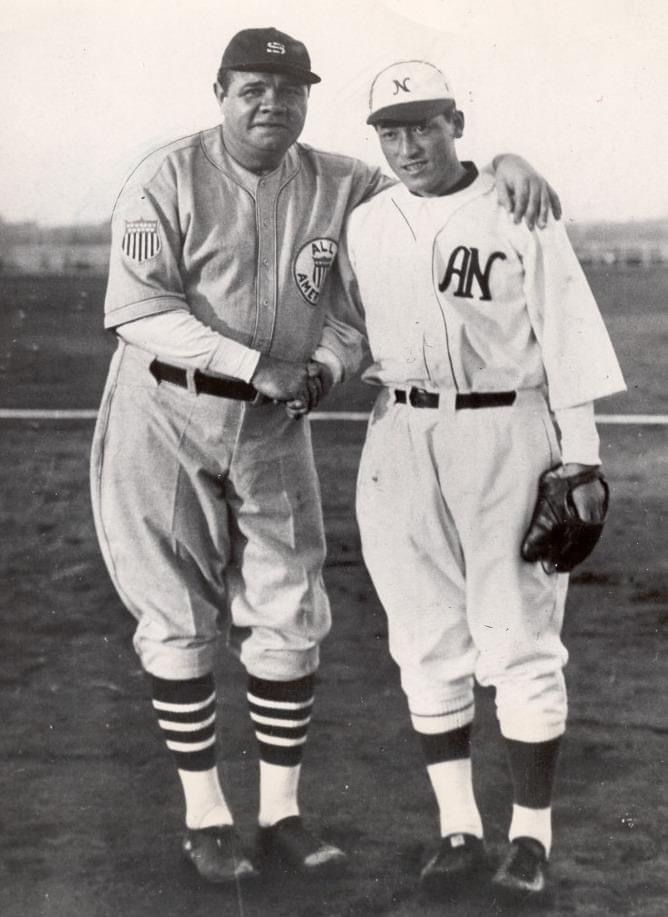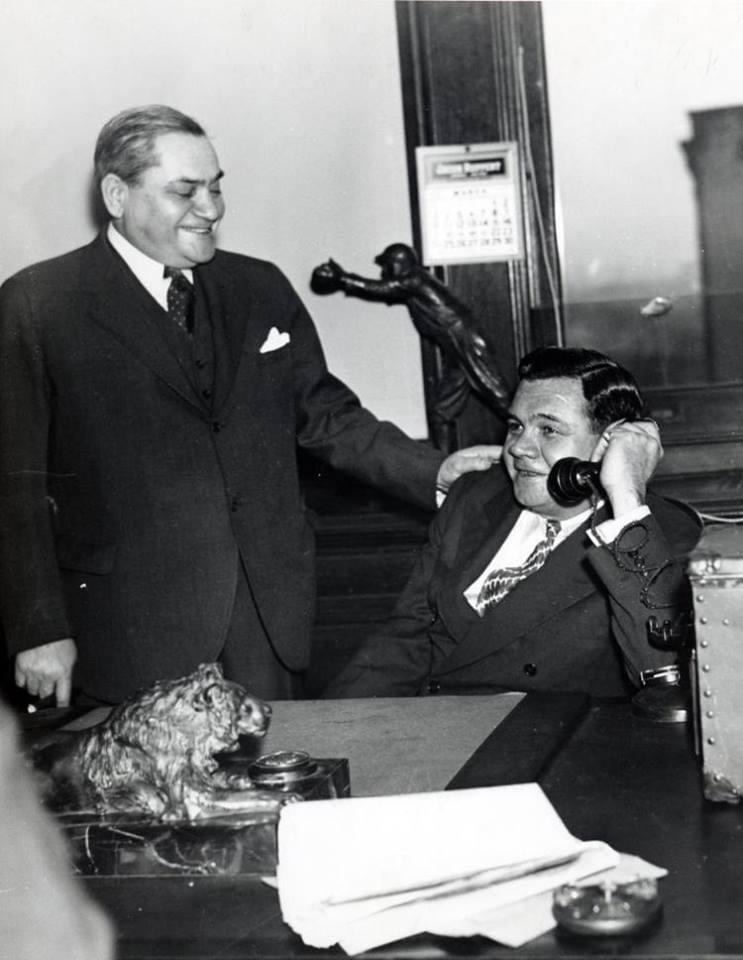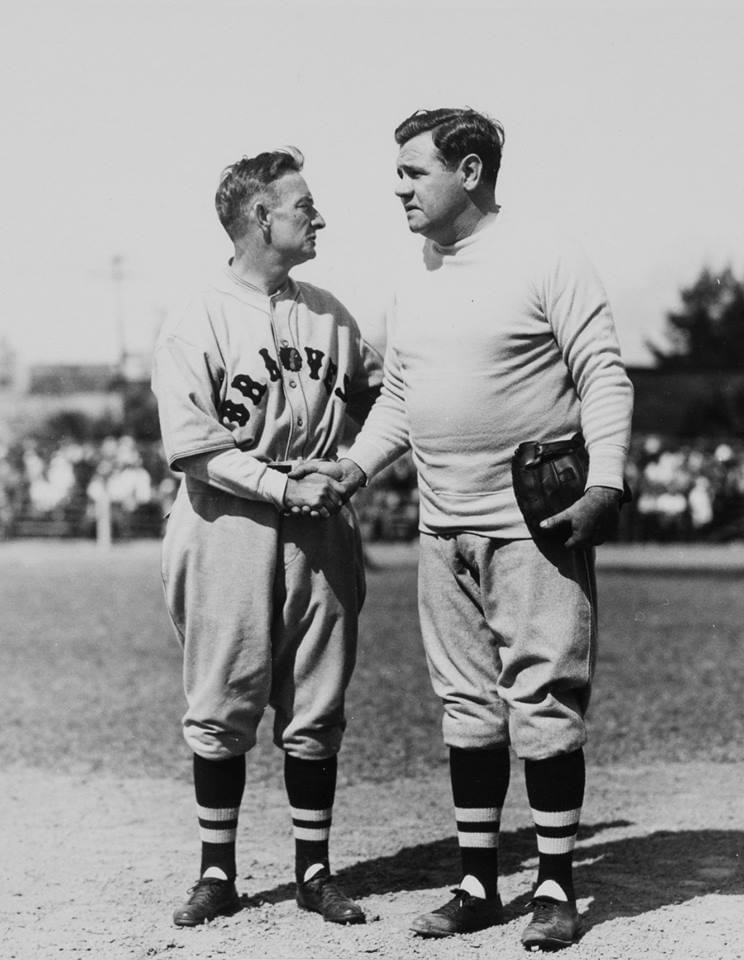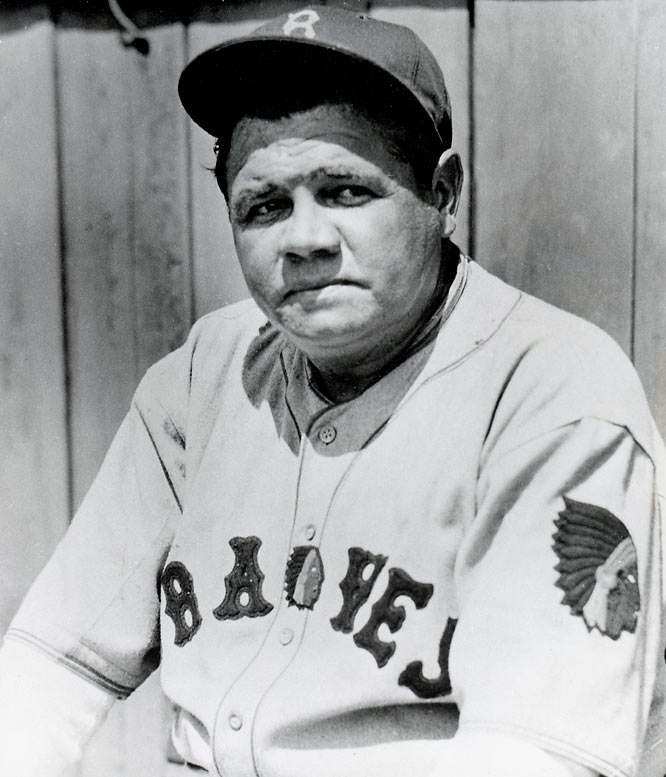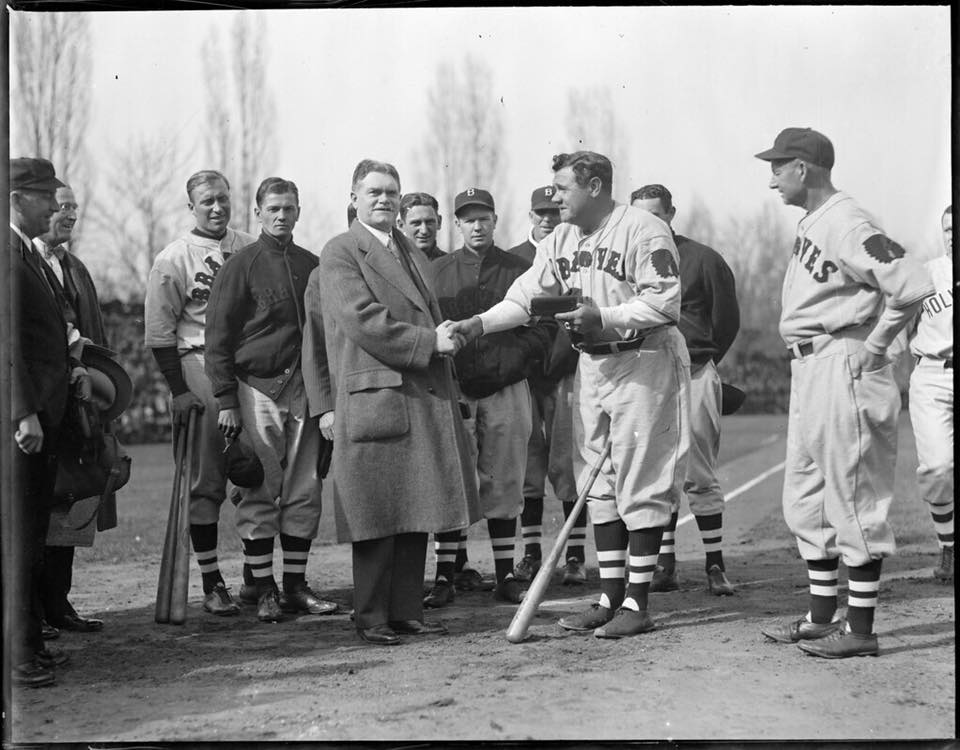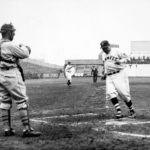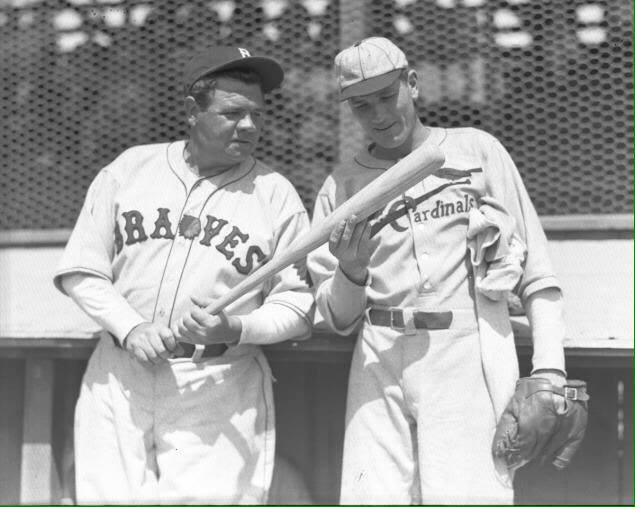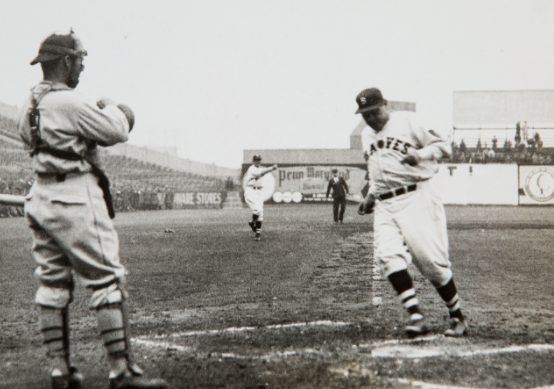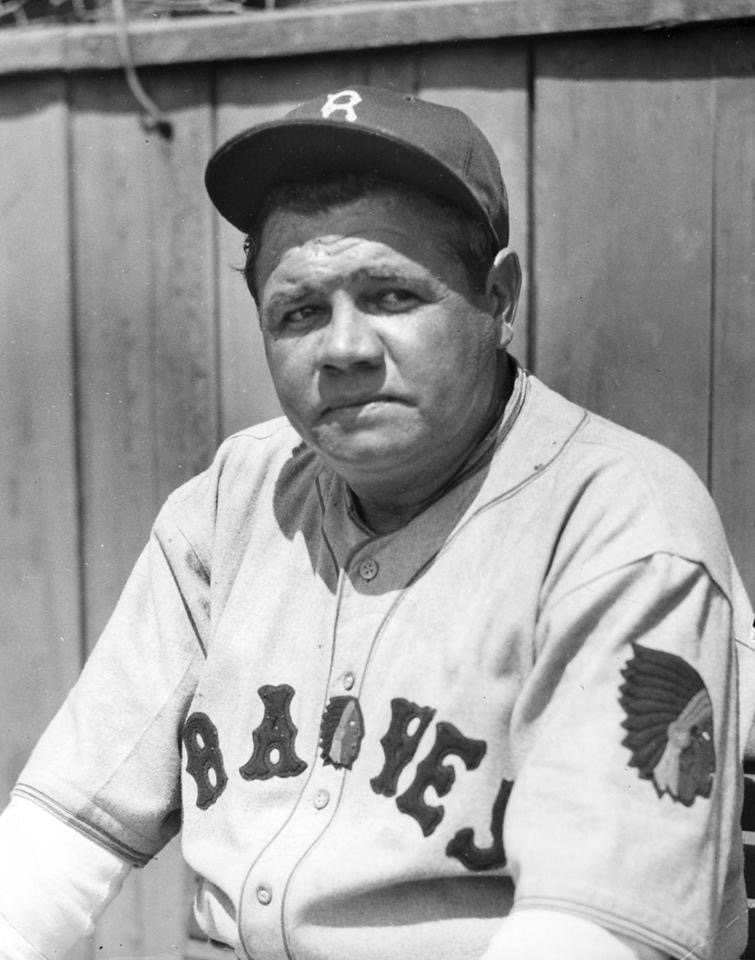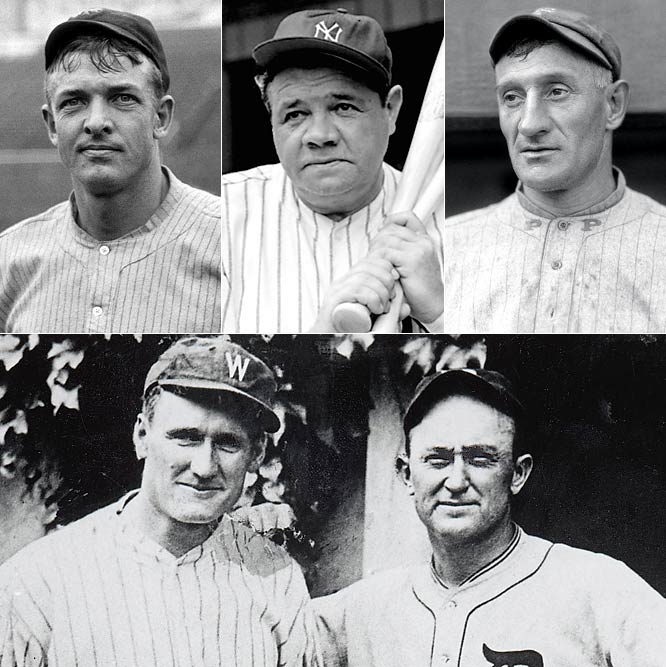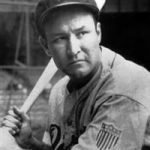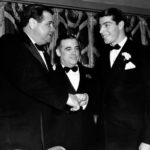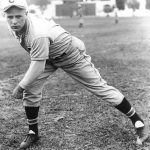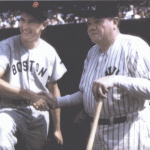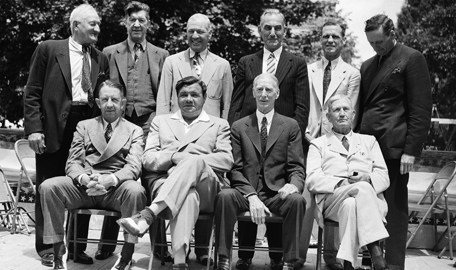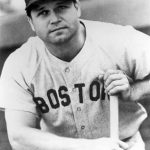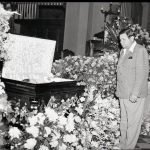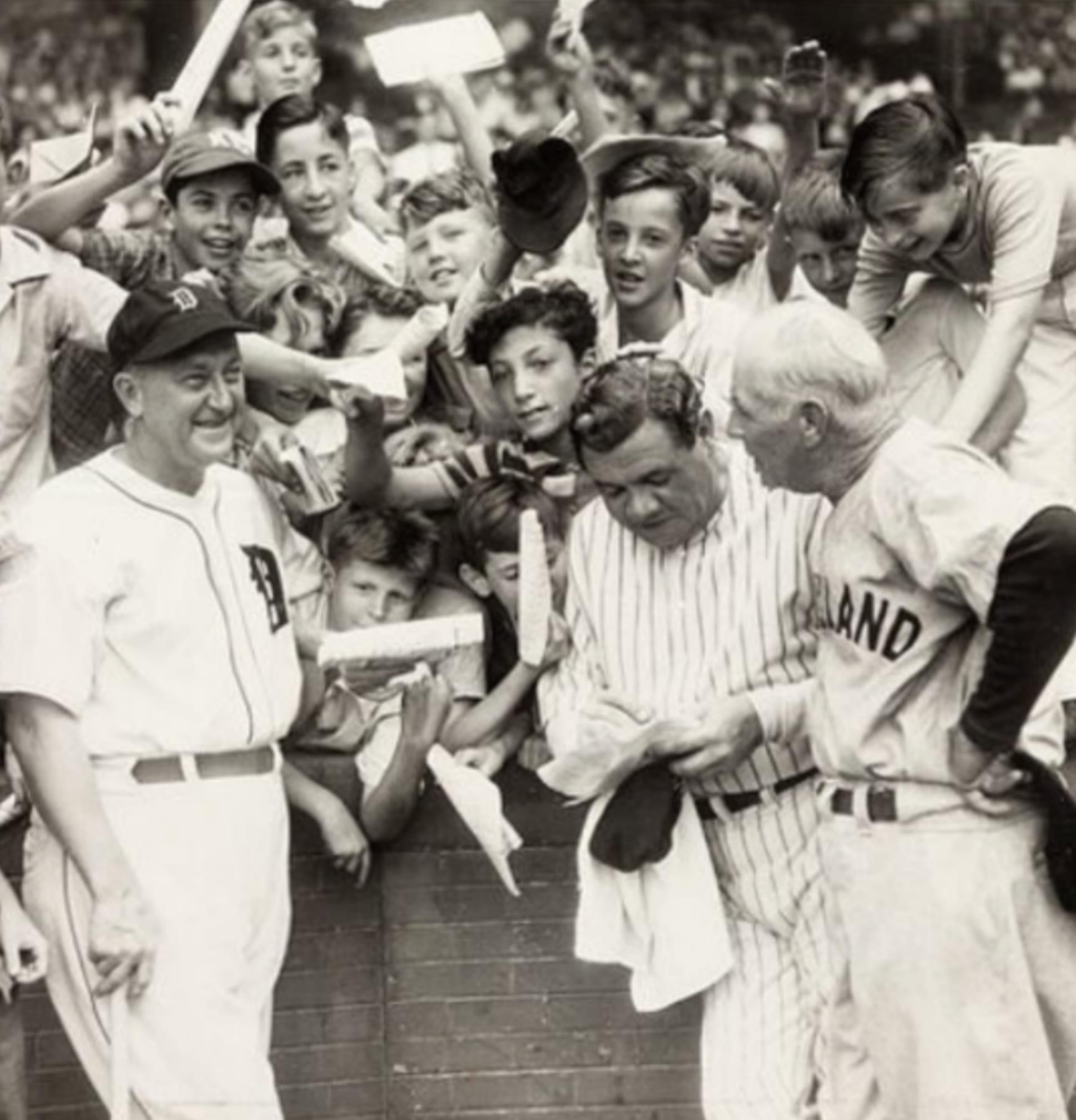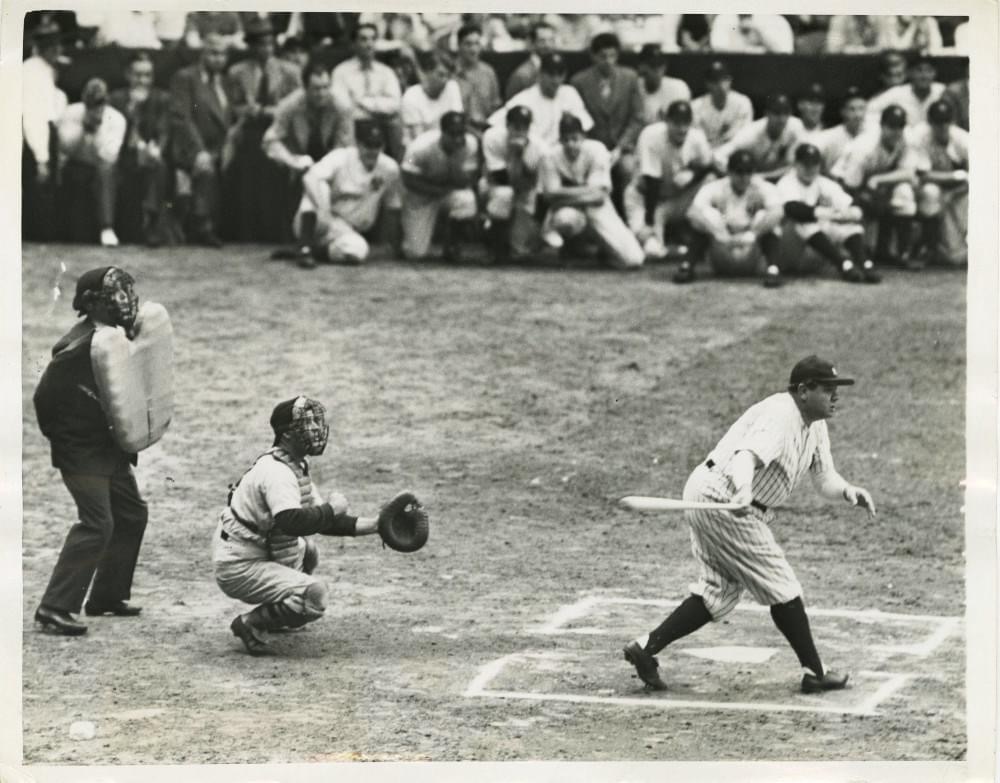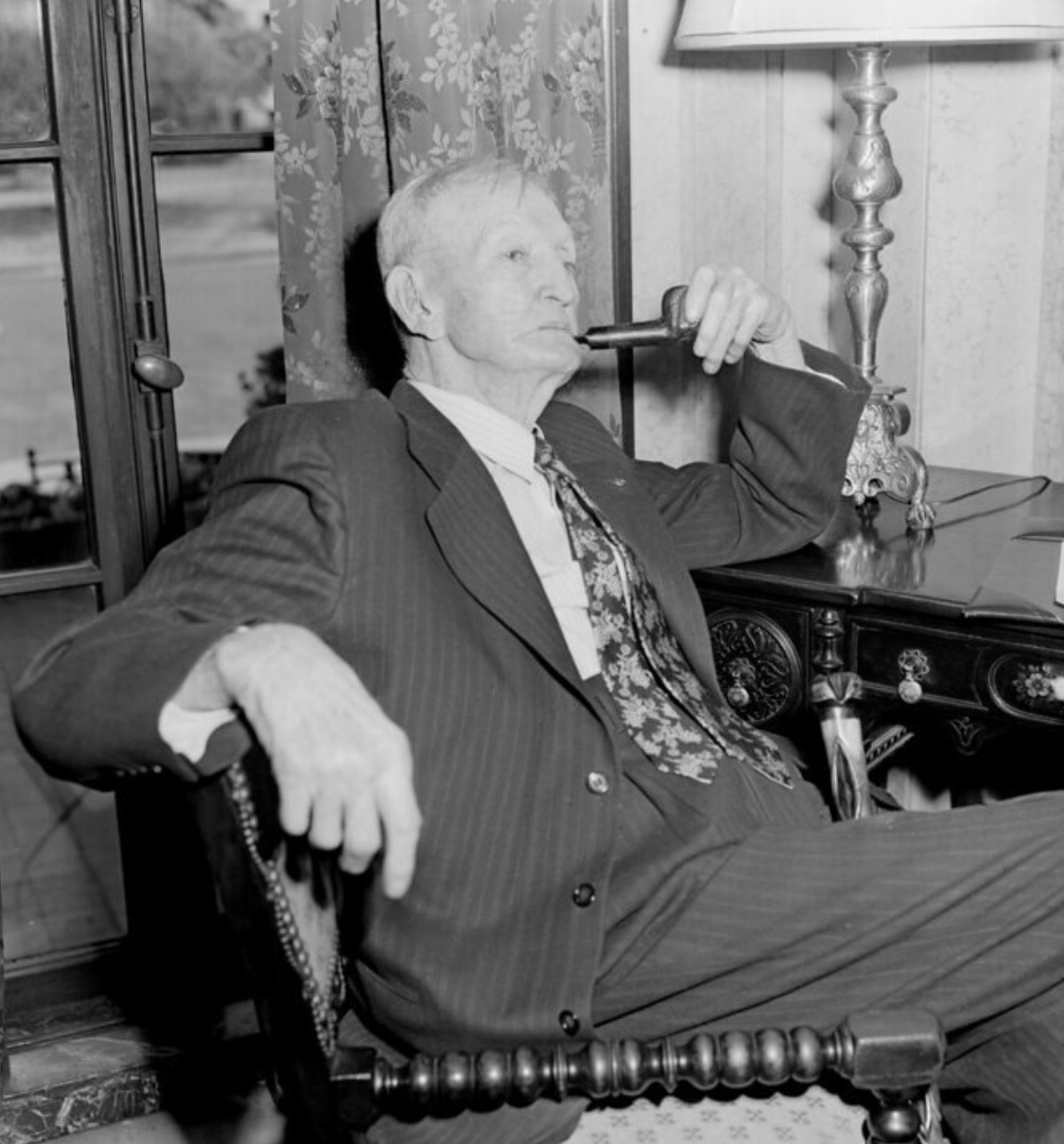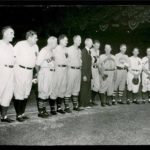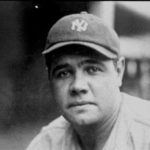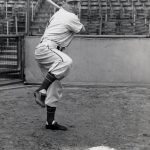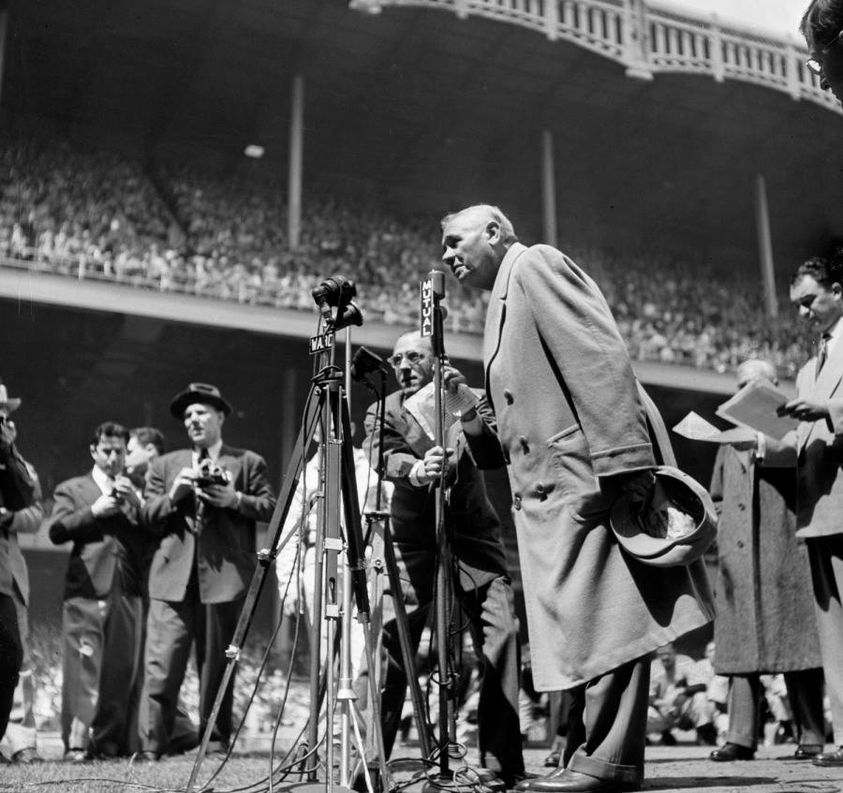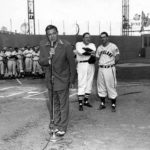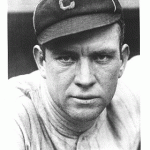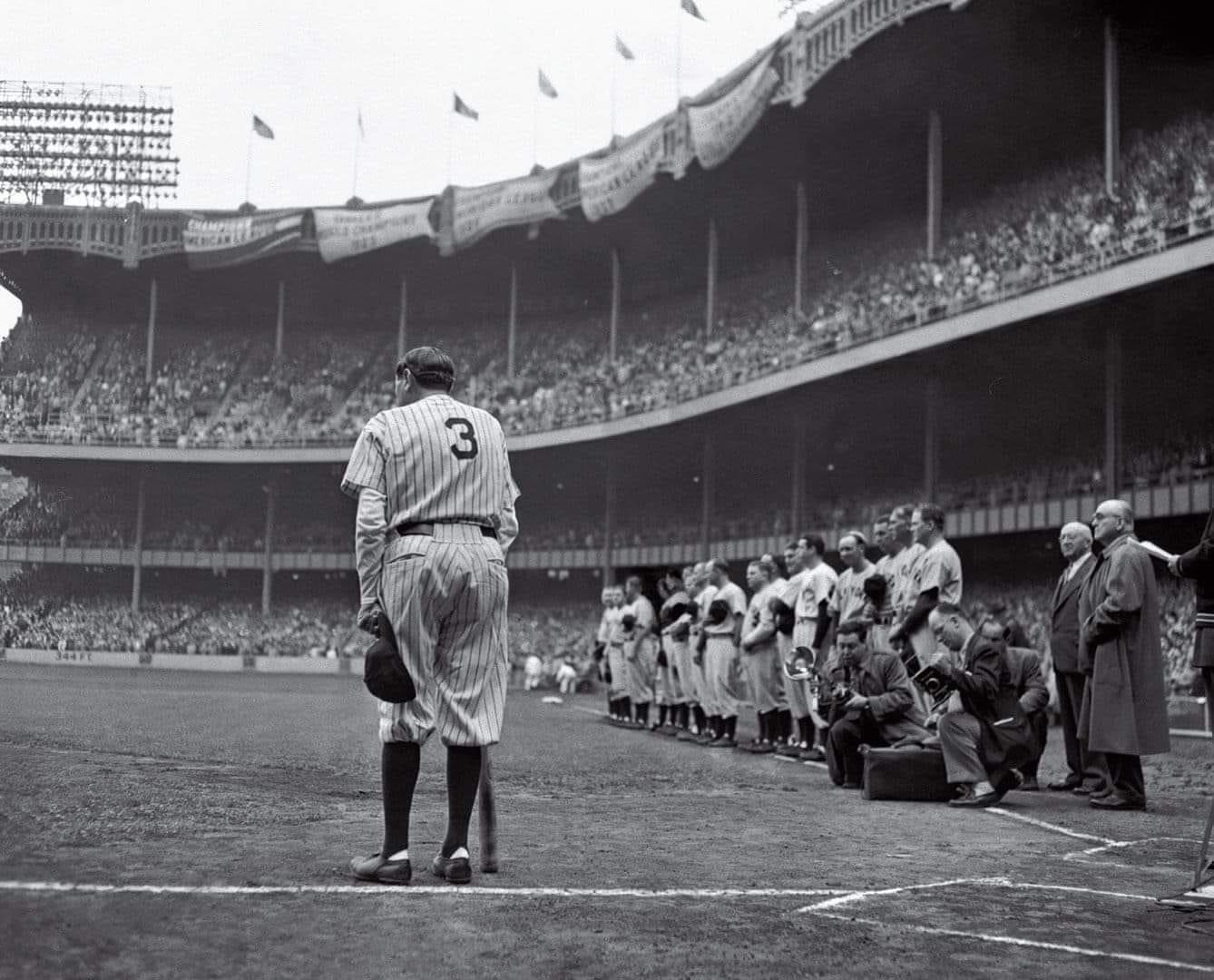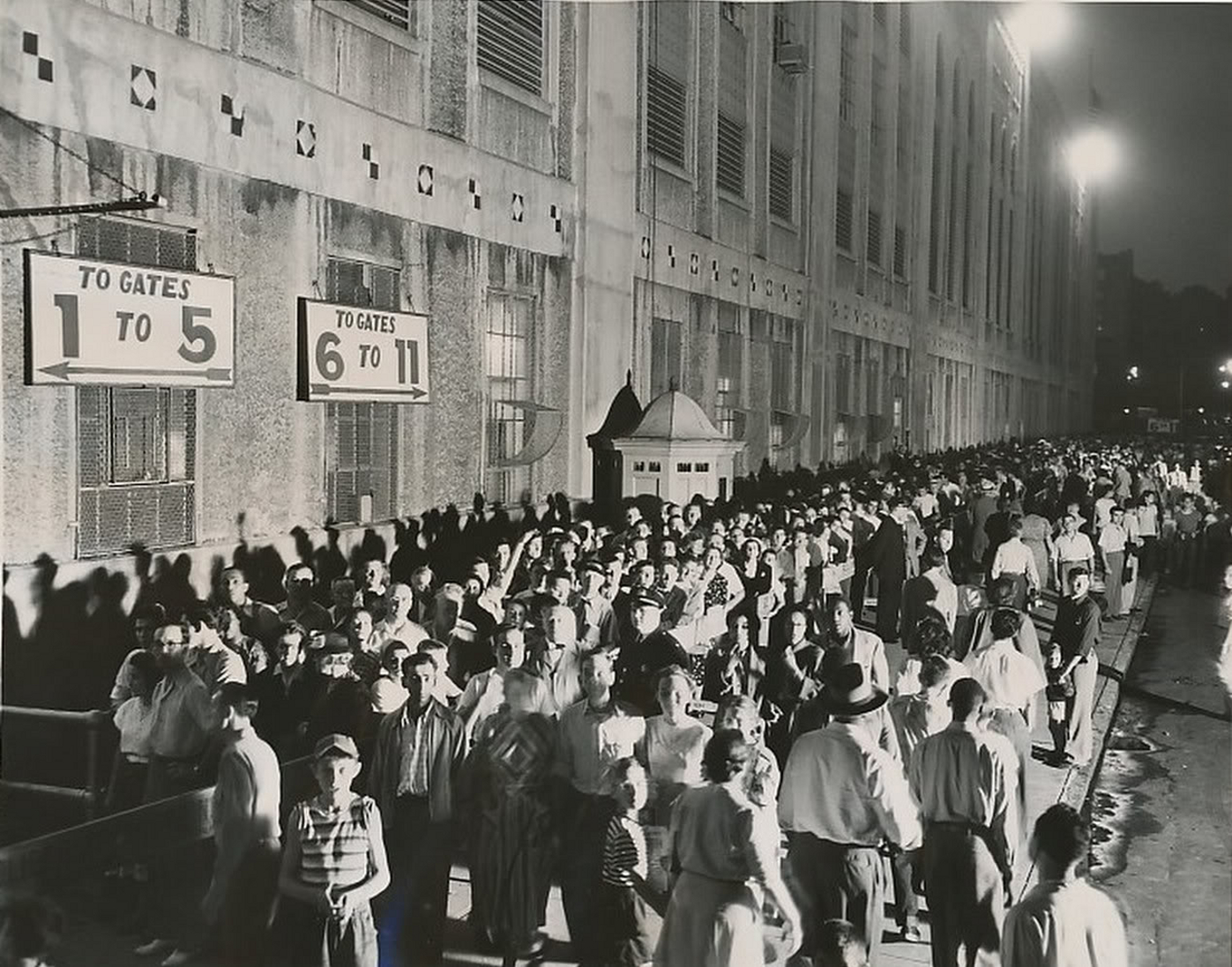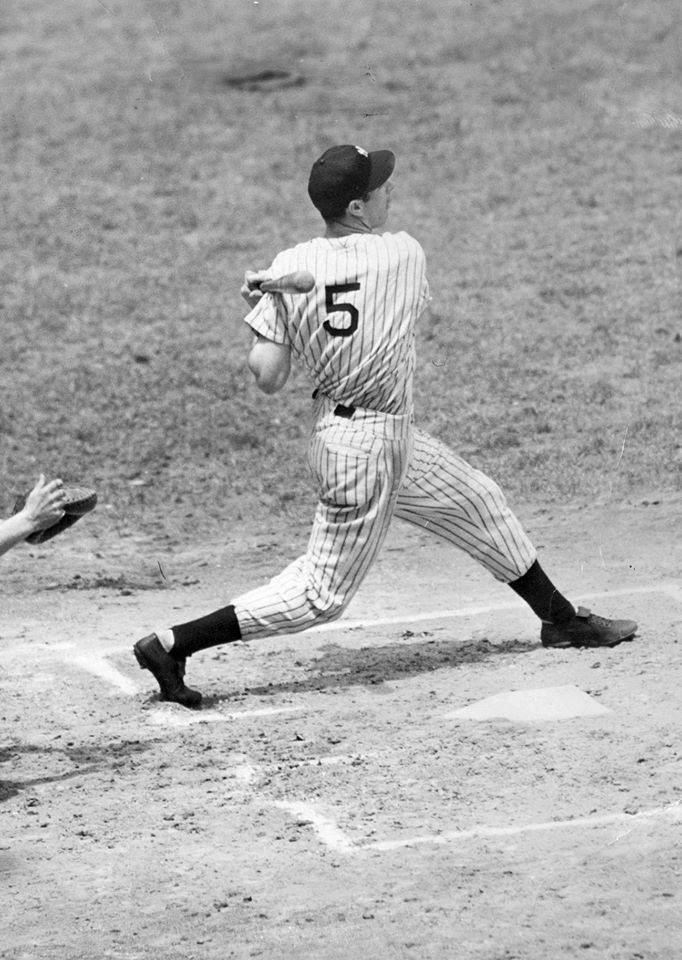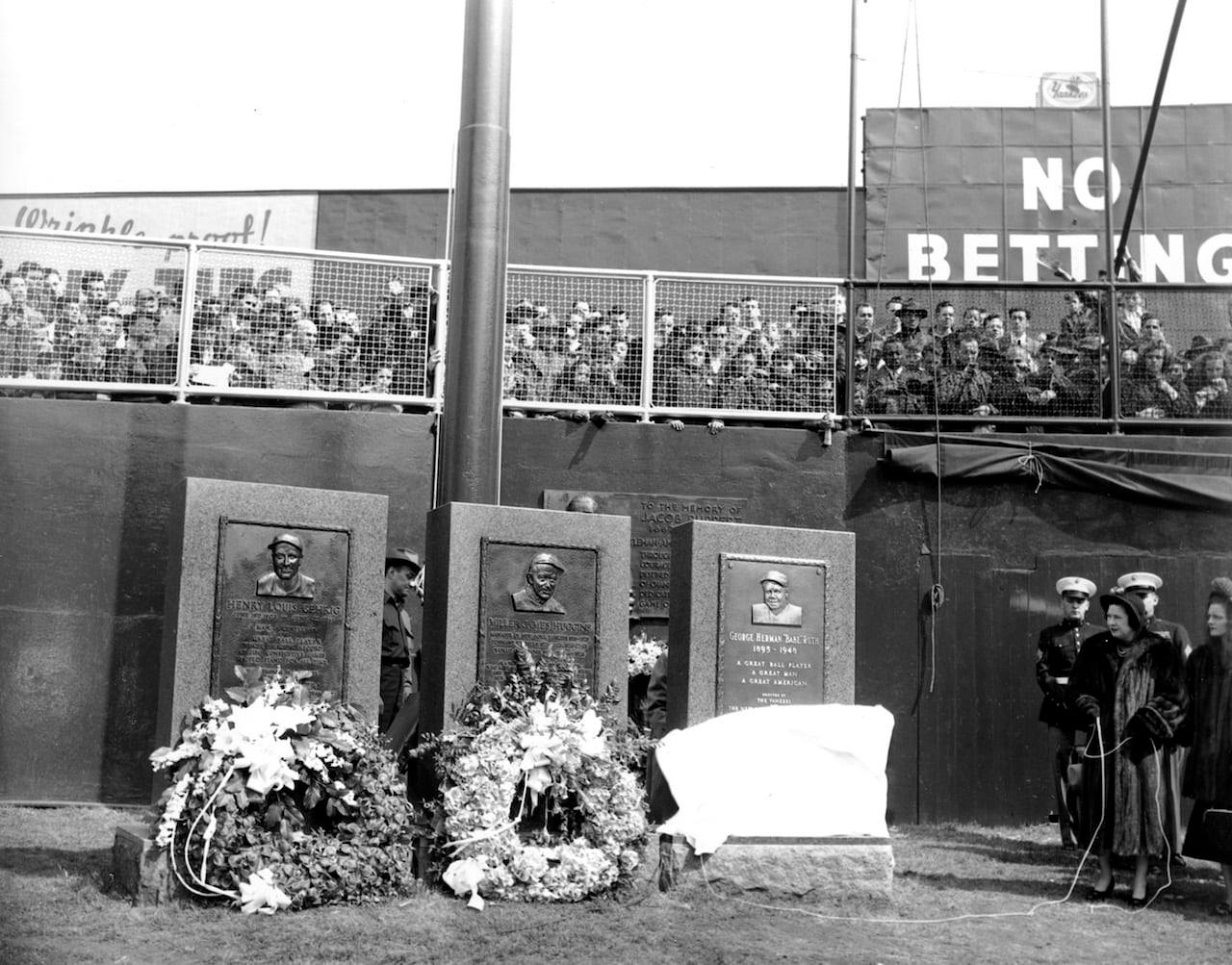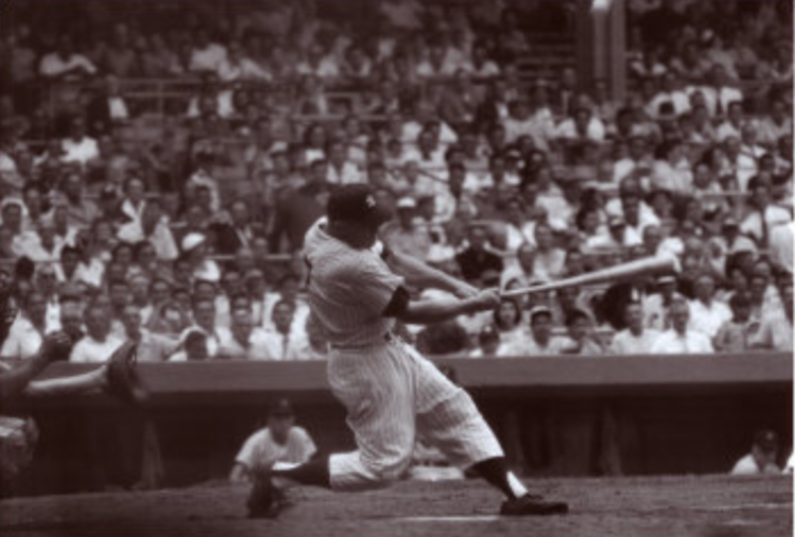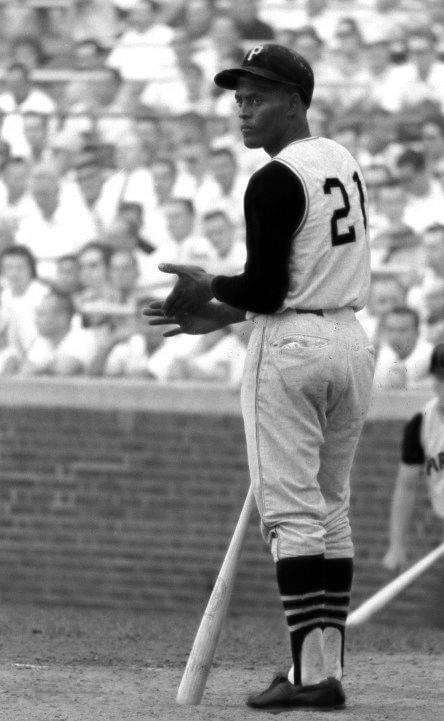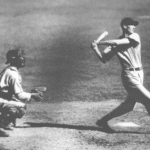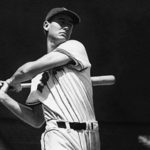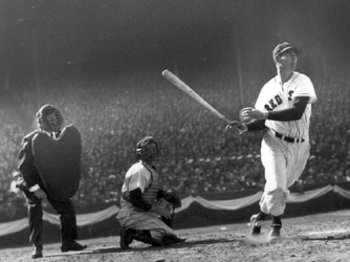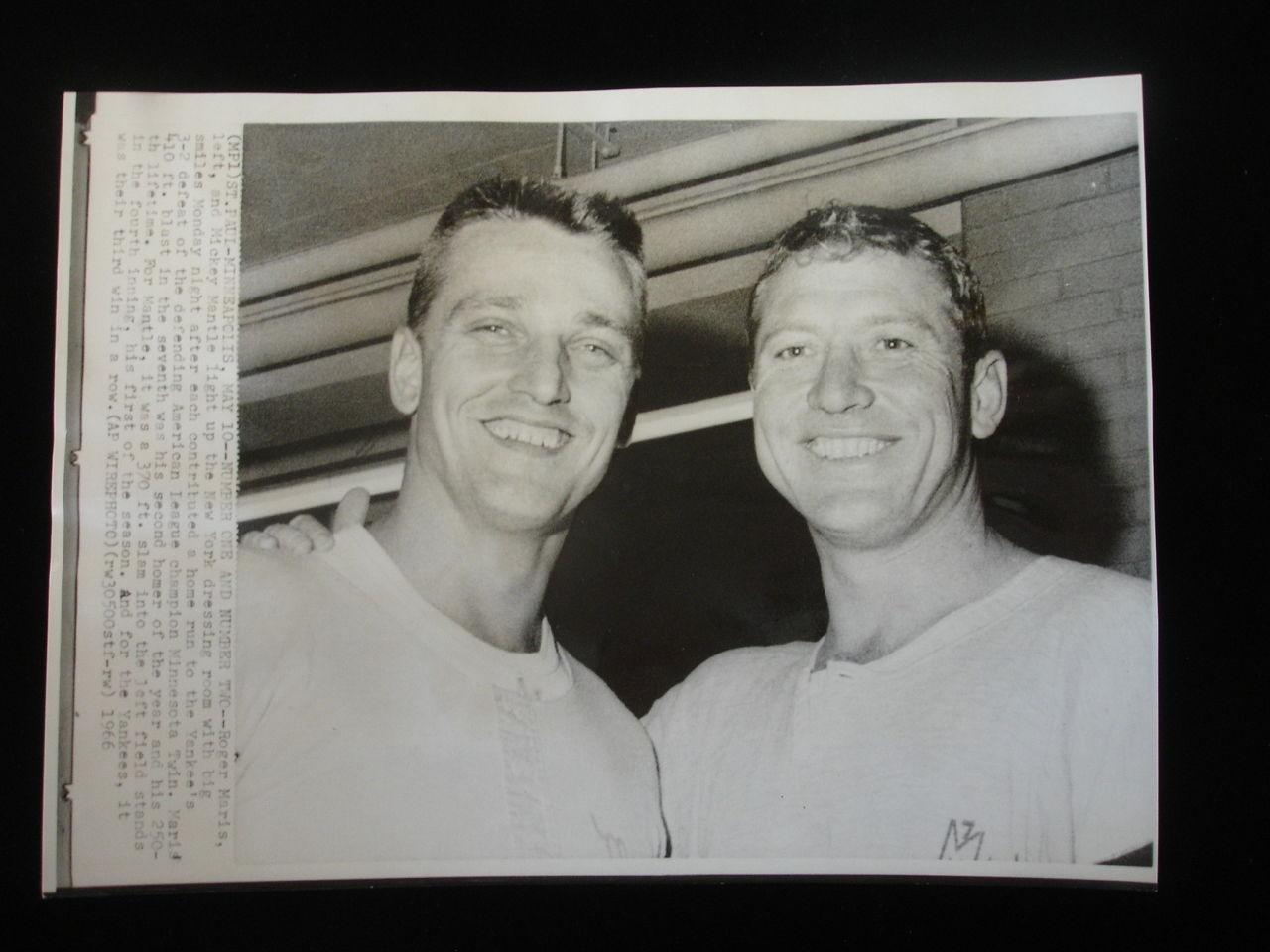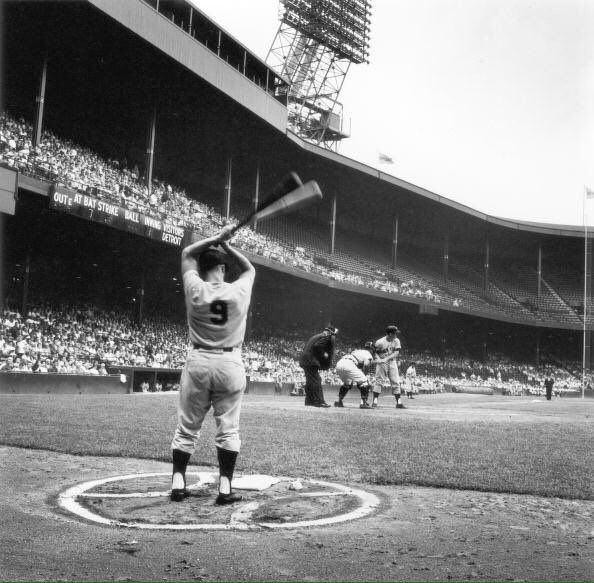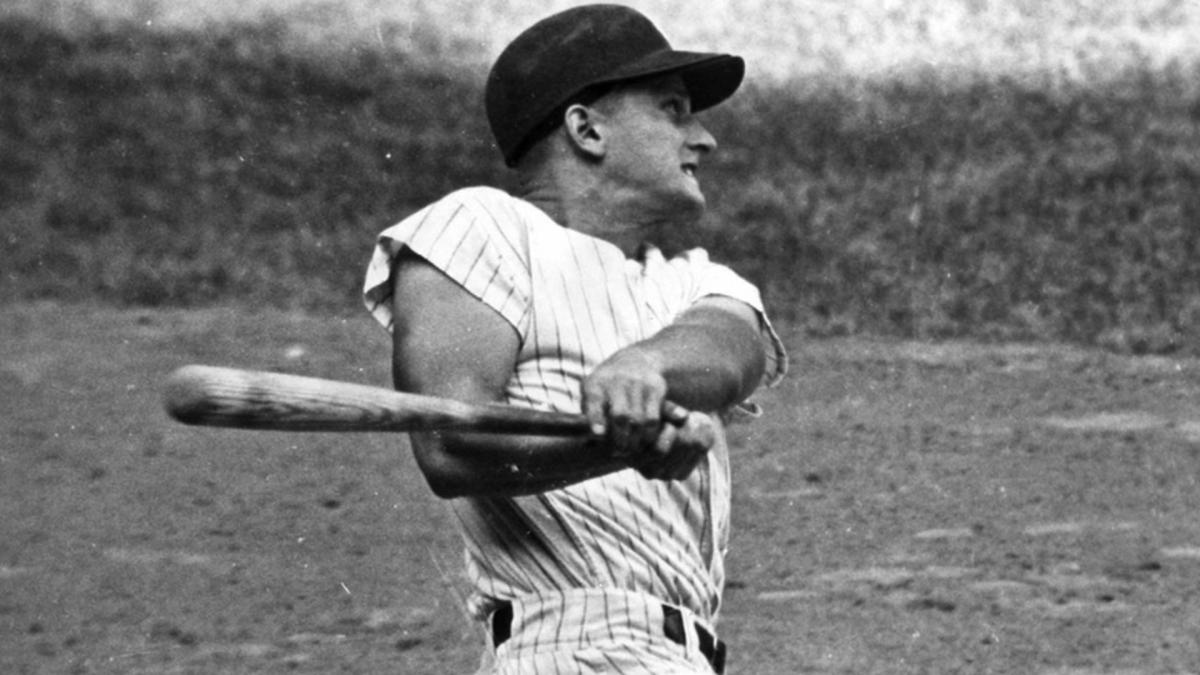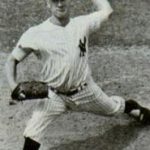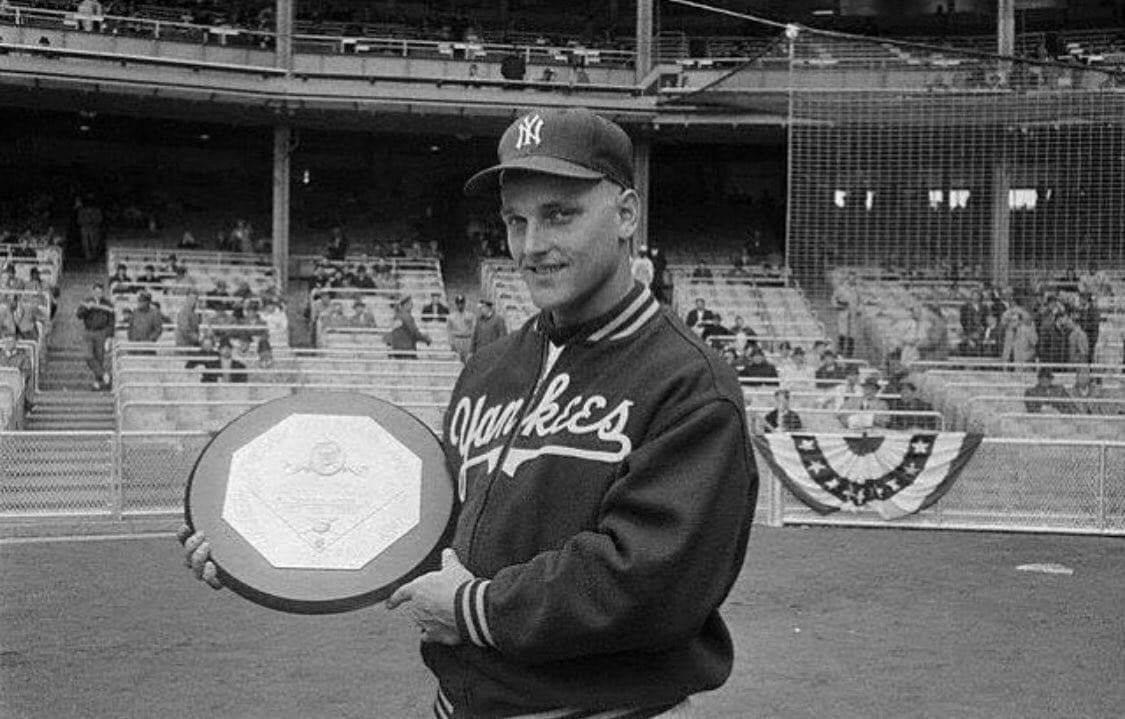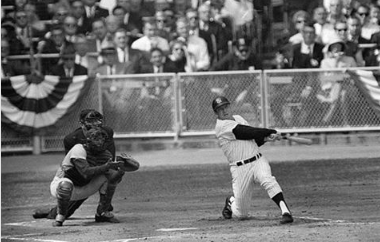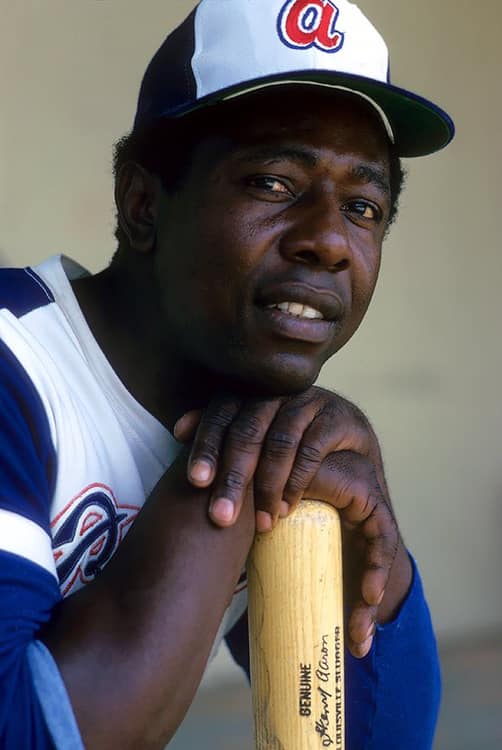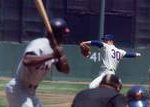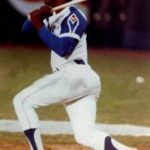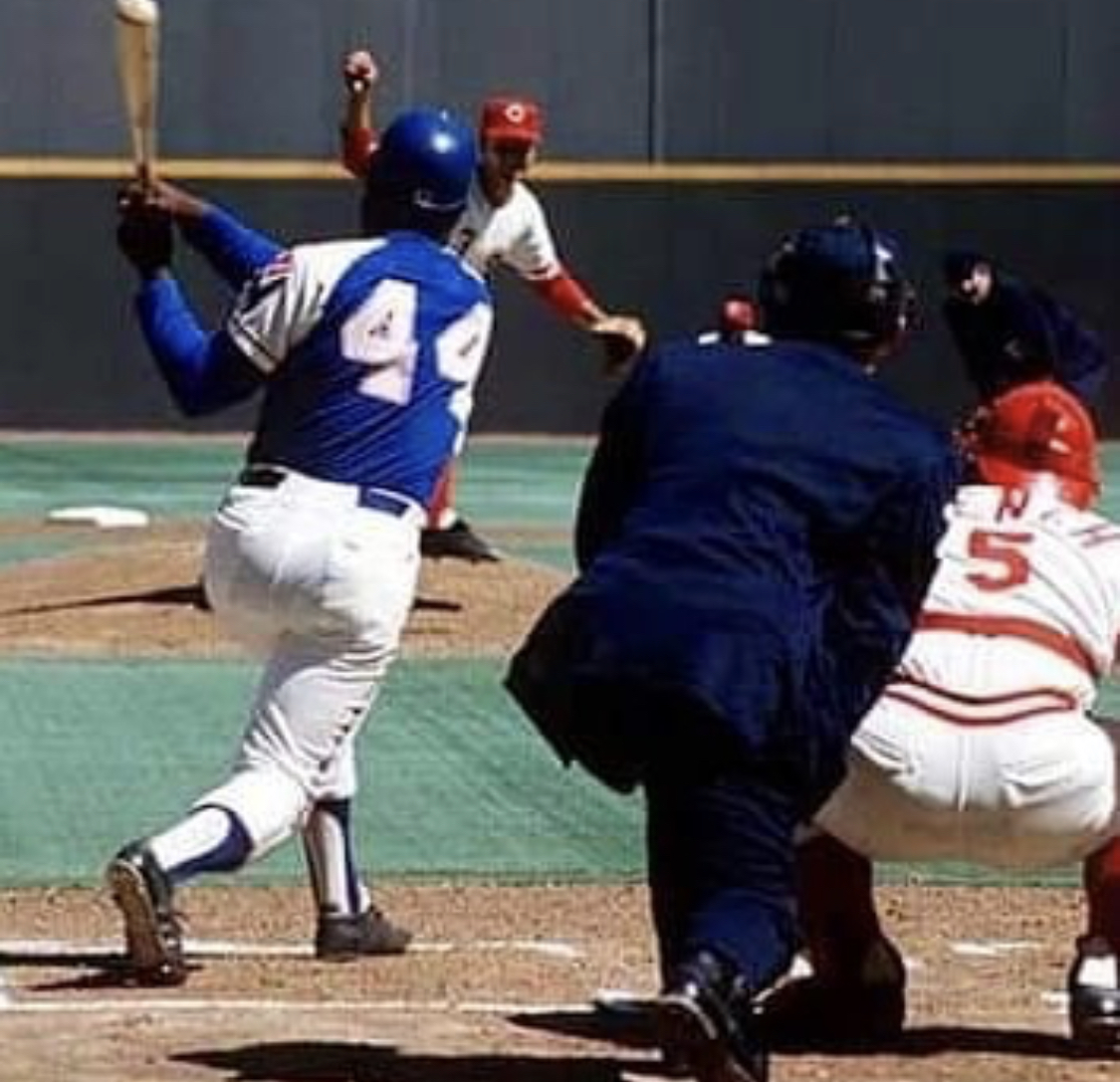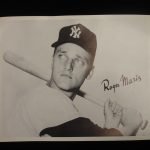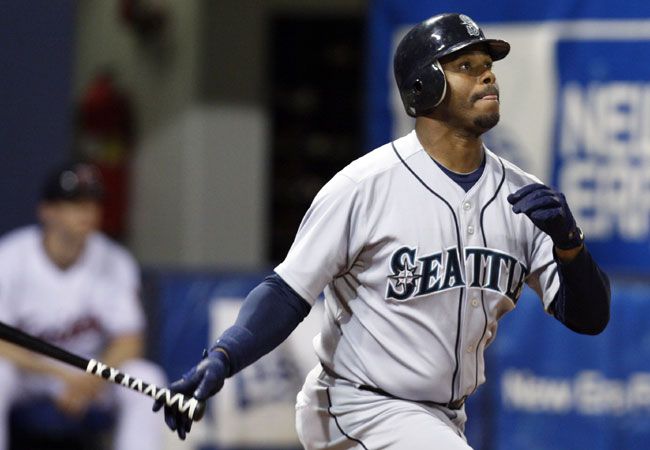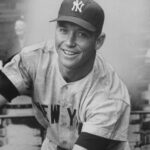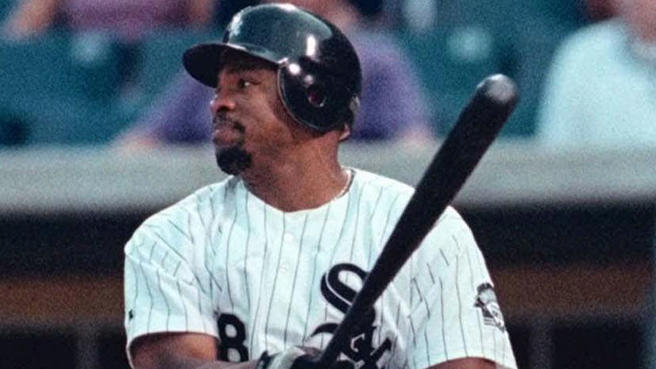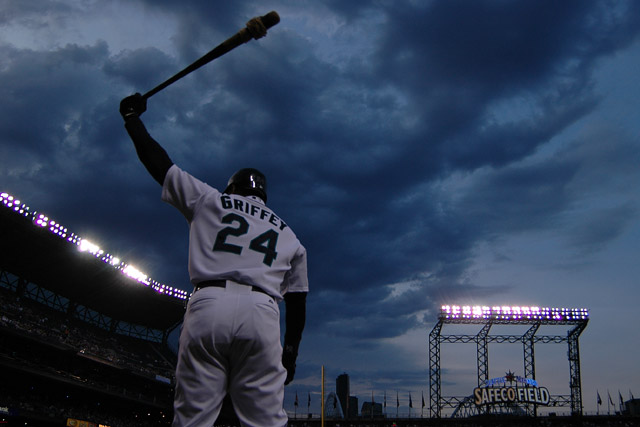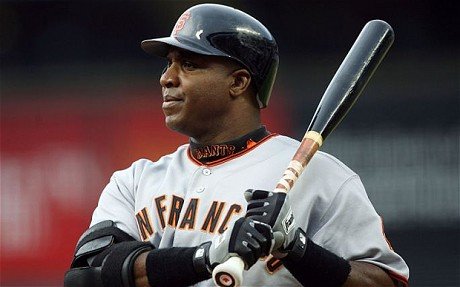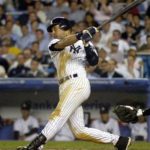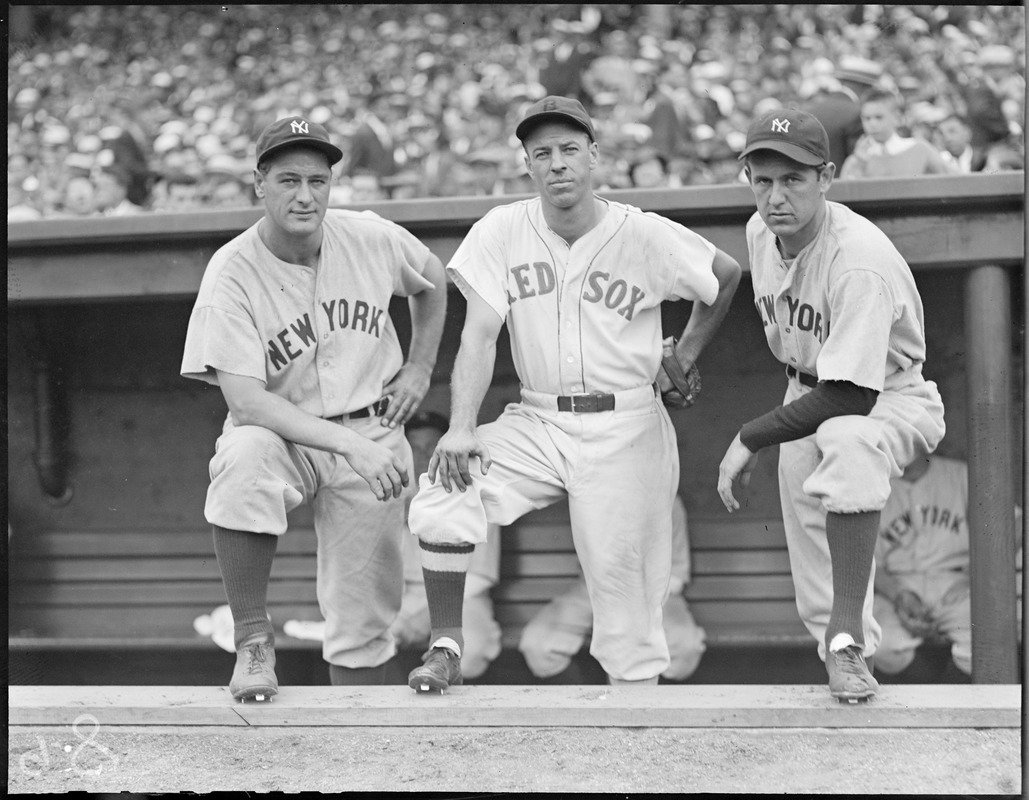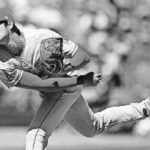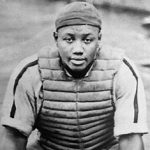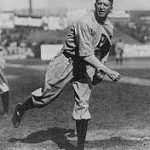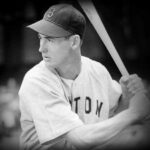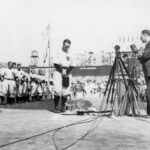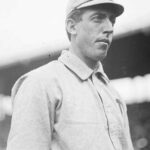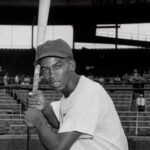Babe Ruth Career Highlights
Babe Ruth
Positions: Outfielder and Pitcher
Bats: Left • Throws: Left
6-2, 215lb (188cm, 97kg)
Born: February 6, 1895 in Baltimore, MD us
Died: August 16, 1948 (Aged 53-192d) in New York, NY
Buried: Gate of Heaven Cemetery, Hawthorne, NY
High School: St. Mary’s HS (Baltimore, MD)
Debut: July 11, 1914 (Age 19-155d, 4,204th in major league history)
vs. CLE 7.0 IP, 8 H, 1 SO, 0 BB, 2 ER, W
Last Game: May 30, 1935 (Age 40-113d)
vs. PHI 1 AB, 0 H, 0 HR, 0 RBI, 0 SB
Hall of Fame: Inducted as Player in 1936. (Voted by BBWAA on 215/226 ballots)
Induction ceremony in Cooperstown held in 1939.
View Babe Ruth’s Page at the Baseball Hall of Fame (plaque, photos, videos).
Full Name: George Herman Ruth
Nicknames: Babe, The Bambino, The Sultan Of Swat, Jidge, The Colossus of Clout or The King of Crash
Nine Players Who Debuted in 1914
Babe Ruth
Harry Heilmann
George Burns
Everett Scott
Red Faber
Sad Sam Jones
Dolf Luque
Jack Tobin
Braggo Roth
The Babe Ruth Teammate Team
C: Bill Dickey
1B: Lou Gehrig
2B: Tony Lazzeri
3B: Home Run Baker
SS: Everett Scott
LF: Bob Meusel
CF: Tris Speaker
RF: Harry Hooper
SP: Joe Wood
SP: Waite Hoyt
SP: Red Ruffing
SP: Lefty Gomez
RP: Johnny Murphy
M: Miller Huggins
Notable Events and Chronology for Babe Ruth Career
Biography
The most colorful and charismatic player in baseball history, Babe Ruth revolutionized the sport with his home-run hitting prowess, enabling it to survive the Black Sox scandal of 1919 and allowing the national pastime to reach new heights of popularity during the Roaring Twenties. Ruth was the game’s greatest ambassador and its number one drawing card. He also is generally considered to be the greatest player in the history of the sport, dominating his era as no other player ever has. Yet few people could ever have imagined that young George Herman Ruth would eventually become such a legendary figure.
As a youngster growing up on the streets of Baltimore, Ruth was completely incorrigible, spending much of his time in St. Mary’s Industrial School for repeatedly running afoul of the law. Raised primarily by his father, a saloon-keeper who frequently took to beating his son as a form of punishment, Ruth finally was admitted to St. Mary’s at an early age after his parents grew weary of trying to keep him out of trouble. It was in the boys’ home that the gangly and awkward-looking young man learned to harness his great energy and play the game of baseball. Ruth was released by Father Gilbert to pitch for the Baltimore Orioles of the International League in 1912 after Gilbert persuaded Baltimore’s owner-manager Jack Dunn to become the 17-year-old’s guardian. The nickname “Babe” soon became affixed to the rambunctious teenager, who spent the next two years pitching for the Orioles before the Boston Red Sox purchased his contract in 1914. The 19-year-old lefthander made his major league debut with the team later that year, appearing in four games and winning two of his three decisions. Ruth became a regular member of Boston’s starting rotation the following year, compiling a record of
18-8 and an outstanding 2.44 earned run average for the eventual world champions.
Ruth developed into arguably the best lefthanded pitcher in baseball in 1916, winning 23 games, completing 23 of his 41 starts, throwing 323 innings, and leading the league with a 1.75 ERA and nine shutouts. The Red Sox won the American League pennant, and Ruth helped them defeat Brooklyn in the World Series, allowing only one run and six hits during a 14-inning, 2-1 complete-game victory in his only start. Ruth had another
sensational season in 1917, winning 24 games, compiling a 2.01 ERA, and leading the league with 35 complete games. However, the Babe began to demonstrate over the course of that 1917 campaign that he also was quite proficient as a hitter, compiling a .325 batting average in his 123 at-bats. Boston subsequently decided to expand Ruth’s role as a hitter the following year, reducing his number of mound appearances and placing him in the outfield on those days he didn’t pitch. Ruth responded by excelling in both areas. In addition to winning 13 of his 20 decisions and compiling an outstanding 2.22 ERA, he batted .300 and led the league with 11 home runs, while totaling only 317 official plate appearances. Ruth then helped the Red Sox capture their third World Series in four seasons, continuing his streak of 29 2/3 consecutive scoreless innings in the Fall Classic, a mark that stood for 43 years. Although Ruth continued to pitch sporadically in 1919, he spent most of his time in the outfield, batting .322 and leading the American League with 29 home runs, 114 runs batted in, 103 runs scored, a .456 on-base percentage, and a .657 slugging percentage.
Fast-becoming baseball’s most popular and recognizable figure, Ruth demanded to be paid as such. However, Red Sox owner Harry Frazee, a theatrical producer who was deep in debt, refused to meet his disgruntled outfielder’s demands. More concerned with financing a Broadway show called No, No, Nanette, Frazee sold Ruth to the New York Yankees for $100,000 in December of 1919, and the rest, as they say, is history.
Ruth compiled astounding numbers his first year in New York, batting .376 and leading the American League with 54 home runs, 137 runs batted in, 158 runs scored, a .530 on-base percentage, and an .847 slugging percentage. The Babe’s level of dominance was so great that his 54 home runs were almost three times as many as the 19 homers league-runnerup George Sisler hit for the St. Louis Browns. In fact, the rest of the American League combined to hit only 315 long balls. Ruth’s .847 slugging percentage was also 215 points higher than the mark of .632 posted by Sisler, who finished second in that category as well. The Yankees improved their win total from 80 the previous season to 95 in 1920, and they finished just three games behind the pennant-winning Cleveland Indians.
Fans of the game began coming out to ballparks in droves to watch Ruth hit a baseball farther than they previously imagined possible. Babe didn’t disappoint them in the least in 1921, batting .378, leading the league with a .512 on-base percentage and an .846 slugging percentage, and establishing new major league records with 59 home runs, 171 runs batted in, and 177 runs scored. Many baseball historians still consider Ruth’s 1921 campaign to be the greatest ever turned in by any player. Babe’s slugging figures once again surpassed those of every other player by an incredibly wide margin. His 59 homers were 35 more than the 24 Ken Williams hit for the Browns, and his .846 slugging percentage was more than 200 points higher than the mark of .639 Rogers Hornsby posted for the Cardinals in the National League. The Yankees captured their first pennant in 1921, compiling a record of 98-55 and finishing 4 ½ games ahead of second-place Cleveland. However, they lost the World Series to the Giants, with whom they shared New York’s Polo Grounds.
Ruth’s raucous ways began to catch up with him in 1922. He ignored Baseball Commissioner Kenesaw Mountain Landis’s ban on barnstorming in the off-season and traveled with his own All-Star team. He was suspended for 39 days as a result of his transgression, causing him to miss the start of the regular season. In May, he threw dirt in an umpire’s eyes, took off after a heckler in the stands, and then proceeded to stand on the dugout roof, shaking his fist and yelling at the fans in attendance, “You’re all yellow!” when they booed him. He was suspended again. Ruth was suspended for a third time in September when he had another run-in with a fan. He ended up missing nearly a third of the 1922 campaign, although he still managed to finish among the league leaders with 35 home runs and 99 runs batted in, while topping the circuit with a .672 slugging percentage. The Yankees won the A.L. pennant again, but they were defeated by the Giants in the World Series for the second straight year. Hardly himself during the Fall Classic, Ruth batted just .118 against the cross-town rivals.
Ruth returned to the Yankees a humbled man in 1923, the year in which the team first began playing its home games in Yankee Stadium. Appearing in all of New York’s 152 games, Ruth batted a career-high .393 and led the American League with 41 home runs, 131 runs batted in, 151 runs scored, a .545 on-base percentage, a .764 slugging percentage, and an American League record 170 walks. The Yankees won 98 games to easily win the A.L. pennant, and Babe was named the league’s Most Valuable Player. The team then captured its first world championship, defeating the Giants in six games in the World Series. Ruth batted .368 during the Series and hit three home runs, despite receiving a total of eight walks.
The Yankees failed to repeat as American League champions in 1924, finishing just two games behind the first-place Washington Senators. Yet, Ruth had another great year,
driving in 121 runs and leading the league with 46 home runs, 143 runs scored, a .378 batting average, a .513 on-base percentage, and a .739 slugging percentage.
A serious illness caused Ruth to miss two months of the 1925 campaign, limiting him to only 25 home runs, 66 runs batted in, and 61 runs scored – easily his lowest totals since becoming an everyday player in 1919. With Babe absent from their lineup much of the year, the Yankees fell to seventh place in the American League, 28 ½ games behind the pennant-winning Senators.
Babe rededicated himself to his sport after he was scolded by none other than the President of the United States at the conclusion of the 1925 season for “letting down the nation’s youth.” Returning to the New York lineup with a vengeance, Ruth batted .372 and led the league with 47 home runs, 146 runs batted in, and 139 runs scored. The Yankees won 91 games to capture the American League pennant. However, they were subsequently upset by the Cardinals in seven games in the World Series. Although New York came up short in the Fall Classic, Ruth made baseball history, becoming the first player to hit three home runs in a World Series contest, a 10-5 Yankee victory in Game Four. Babe batted .300, drove in five runs, received 11 walks, and hit New York’s only four home runs during the Series.
Along with teammate Lou Gehrig, the 32-year-old Ruth led the famed 1927 Murderers Row New York Yankees to one of the most dominant single season performances in baseball history. Angered by their World Series loss to the Cardinals the previous season, the Yankees approached the 1927 campaign as if they had something to prove. They proceeded to post an astounding 110-44 record during the regular season, with Ruth and Gehrig forming the greatest one-two punch the game has ever seen. The two sluggers waged an assault on the Babe’s single-season record of 59 home runs, which he established six years earlier. A phenomenal month of September enabled Ruth to pull away from his teammate in the home run race, as he finished the campaign with 60 long balls to break his own record. Babe also knocked in 164 runs, batted .356, and led the league with 158 runs scored, a .487 on-base percentage, and a .772 slugging percentage.
The Yankees then disposed of the Pittsburgh Pirates in four straight games in the World Series, outscoring their overmatched opponents by a total margin of 23-10. Ruth batted an even .400 during the sweep, driving in seven runs and hitting the only two home runs struck by either team during the Series.
Ruth continued his prolific slugging in 1928, hitting a league-leading 54 home runs, to top the 50-homer mark for the fourth and final time in his career. He also led the league with 142 runs batted in, 163 runs scored, and a .709 slugging percentage. The Yankees repeated as American League champions and then gained a measure of revenge against St. Louis in the World Series by vanquishing the Cardinals in four straight games. Ruth batted .635 during the Series, drove in four runs, and duplicated his 1926 feat by hitting three home runs in one World Series game – New York’s championship-clinching Game Four victory.
Although the combination of a superb Philadelphia Athltetics team and an aging and substandard pitching staff in New York prevented the Yankees from winning the American League pennant in either 1929, 1930, or 1931, Ruth continued his assault on American League pitching. He led the league in both home runs and slugging percentageall three years, hitting a total of 141 homers during that three-year period, knocking in a total of 470 runs, and posting batting averages of .345, .359, and .373.
Although Ruth began to show signs of aging for the first time in 1932, the 37-year-old slugger still had an outstanding year, hitting 41 homers, driving in 137 runs, scoring 120 others, batting .341, and leading the league with a .489 on-base percentage. The Yankees returned to the top of the American League standings, finishing 13 games ahead of the second-place Athletics, before sweeping the Chicago Cubs in four straight games in the World Series. Ruth added to his legend in Game Three of the Series when he hit his famous “called shot” against Chicago pitcher Charlie Root during New York’s 7-5 victory. Babe batted .333 in his final World Series appearance, with two home runs and six runs batted in.
Ruth had his last productive season in 1933, hitting 34 home runs, driving in 103 runs, and batting .301. The aging slugger became merely a member of teammate Lou Gehrig’s supporting cast the following year, as the Yankee first baseman won the American League triple crown by topping the circuit with 49 homers, 165 runs batted in, and a .363 batting average. Ruth hit only 22 home runs, knocked in just 84 runs, and batted only .288. He was subsequently released by the Yankees at the end of the year, and he finished his career with the lowly Boston Braves in 1935, appearing in only 28 games and batting just .181 in his 72 official plate appearances. Babe experienced one final moment of glory with the Braves on May 25th of that year when he hit three home runs against the Pirates at Forbes Field, the last of which was the first ball ever hit completely out of that ballpark. The blast ended up being the last of Ruth’s 714 round-trippers. He announced his retirement from baseball one week later and spent the remainder of his life waiting in vain for some major league team to offer him a managerial job. Ruth died 13 years later from throat cancer, disappointed that he never got an opportunity to manage in the sport that he had helped to revitalize.
Although most of Ruth’s records have since been broken, his list of accomplishments is truly amazing. Upon his retirement, Ruth was the major leagues’ all-time leader in home runs (714) and runs batted in (2,213). He scored 2,174 runs, batted .342, amassed 2,873 hits, and compiled a .474 on-base percentage. Ruth’s .690 career slugging percentage is the highest in baseball history. He surpassed 50 homers four times, leading the league in that category on 12 separate occasions. He also topped the circuit in slugging percentage 12 times, on-base percentage 10 times, runs scored eight times, runs batted in six times, and batting average once, surpassing the .370-mark on six separate occasions.
Long after Ruth retired from the game, his legendary feats continued to be recounted by those who witnessed them. Hall of Fame pitcher Dizzy Dean stated, “No one hit home runs the way Babe did. They were something special. They were like homing pigeons. The ball would leave the bat, pause briefly, suddenly gain its bearings, then take off for the stands.”
Longtime manager Leo Durocher was a backup infielder on the Yankees in 1928 and 1929. Durocher later said, “There’s no question about it, Babe Ruth was the greatest instinctive baseball player who ever lived. He was a great hitter, and he would have been a great pitcher.”
Sportswriter Tommy Holmes said on the day of Ruth’s funeral, “Some 20 years ago I stopped talking about the Babe for the simple reason that I realized that those who had never seen him didn’t believe me.”
Hall of Fame pitcher Lefty Gomez joined Ruth on the Yankees during the latter stages of Babe’s career. Gomez later said of his former teammate, “He was a circus, a play and a movie, all rolled into one. Kids adored him. Men idolized him. Women loved him. There was something about him that made him great.”
Babe Ruth was more than just a great baseball player. He was an American hero who became a legend and a larger-than-life figure. Long after his last home run, his name remains synonymous with the game of baseball.
Factoids, Quotes, Milestones and Odd Facts
Played For
Boston Red Sox (1914-1919)
New York Yankees (1920-1934)
Boston Braves (1935)
Similar: Are you kidding?
Linked: Lou Gehrig, Roger Maris, Henry Aaron, Mark McGwire, Barry Bonds, Rickey Henderson
Best Season, 1920
In 1920, Ruth shattered the single season home run mark when he clubbed 54 for his new team, the Yankees. Though he would later tie or better that mark three times, he never had a better overall campaign. He hit .376, fourth best in the league; his slugging percentage was an absurd .847 – the highest total ever to that point by almost 200 percentage points. His .530 OBP was the highest in history to that point. He led the league in extra-base hits, runs, RBI, walks and total average, which was an all-time high of 1.934, or nearly two bases for every out made! His efforts brought the Yankees their first pennant.
Awards and Honors
1923 AL MVP
No-Hit Fame
6/23/1917: For BOS (A) vs. WAS (A), 4-0 at BOS. 0 innings pitched.
Post-Season Appearances
1915 World Series
1916 World Series
1918 World Series
1921 World Series
1922 World Series
1923 World Series
1926 World Series
1927 World Series
1928 World Series
1932 World Series
Description
Like many players of his era, Ruth was extremely superstitious. He believed in the power of four-leaf clovers, horseshoes and rabbit’s feet. He also kept a mascot with him for several years, batboy Eddie Bennett.
Factoid
Babe Ruth hit the first home run in All-Star Game history, at Chicago’s Comiskey Park in 1933.
Scouting Report
In 1921, Columbia University had Ruth undergo a series of tests to determine his athletic and psychological capability. Here are some of their findings, from an article by sportswriter Hugh Fullerton in Popular Science Monthly:
The tests revealed the fact that Ruth is 90 per cent efficient compared with a human average of 60 per cent. That his eyes are about 12 per cent faster than those of the average human being. That his ears function at least 10 per cent faster than those of the ordinary man. That his nerves are steadier than those of 499 out of 500 persons. That in attention and quickness of perception he rated one and a half times above the human average. That in intelligence, as demonstrated by the quickness and accuracy of understanding, he is approximately 10 per cent above normal.
Where He Played: Ruth was a right fielder mostly, though he did play a few seasons in left early in his career. Of course, he also pitched. In 490 at-bats as a pitcher, Ruth hit .304 with a .504 slugging percentage. He scored 75 runs, had 34 doubles, 11 triples, 15 home runs, and drove in 73… According to David Vincent, the guru of home run stats, Ruth hit 354 homers as a right fielder, and 313 as a left fielder. He and Ernie Banks (shortstop and first base) are the only players to hit as many as 300 HR at two positions.
Minor League Experience
1914: Baltimore Orioles (International Association)
1914: Providence (International Association)
Ruth’s only minor league homer was hit in Toronto.
His Arsenal: The Pitches He Threw
Ruth’s first professional catcher, Ben Egan, had this to say about Babe the pitcher: “Babe knew how to pitch the first day I saw him. I didn’t have to tell him anything. He knew how to hold runners on base, and he knew how to work on the hitters, so I’d say he was a pretty good pitcher on his own.
Egan caught the Babe with the Baltimore Orioles in 1914.
Post-Season Notes
Ruth holds the record for the longest complete game victory in World Series history. In 1916, Ruth went 14 innings to defeat the Brooklyn Dodgers… Babe and the Yankees were back in the World Series in 1932, playing the Chicago Cubs. There was no love lost between the Babe and Chicago fans. They jeered and spat upon him and his wife as they entered and left their hotel. As the Series progressed into its third game, the stage was set for one of the most remembered events in baseball history. In the first inning, Ruth hit a three-run homer off pitcher Charlie Root. When he came to bat again in the fifth, the crowd and the Chicago bench released a torrent of abuse upon him. Babe waved his arm and shouted something, though due to the loud noise, no one heard exactly what he said. Whether he was gesturing toward the Cubs bench, to Root or the fence beyond is anyone’s guess. But what happened next is beyond doubt. On Root’s next pitch, Ruth swung mightily and connected with a home run over the center field fence, farther than any home run had ever been hit at Wrigley Field. Had he really called his shot? He was evasive when questioned, responding with, “Why don’t you read the papers? It’s all right there.” Years later a film of the event showed that the Babe was probably not signaling to the bleachers, but rather to his tormenters – the Cubs bench. Nevertheless, the legend of “The Called Shot” remains.
Injuries and Explanation for Missed Playing Time
Early in the 1920 season, Ruth was filming a movie titled Headin’ Home. During the shooting on location in New York, Ruth was stung by an insect and his wrist swelled. A physician had to make an incision to drain fluid and reduce the swelling. Ruth missed six games. This information comes from SABR member Jim McLauchlin.
Hitting Streaks
26 games (1921)
26 games (1921)
Transactions
Sold by Boston Red Sox to New York Yankees (January 3, 1920).
Jail Stripes to Pinstripes
On the morning of June 8, 1921, Ruth was arrested for speeding in New York City. Sitting in jail while he arranged for his release, Ruth was allowed to change into his uniform in his cell. He arrived at Yankee Stadium in time to play in New York’s 4-3 victory over Cleveland.
Factoid
When Babe Ruth hit 60 home runs in 1927, he hit 14% of all home runs in his league that year. For a player to hit 14% of all home runs today, he would have to hit over 300 home runs in one season.
Ruthian Feats
Three home runs in a World Series game twice… The Babe hit 340 solo home runs, 252 two-run shots, and 98 three-run taters. He also slugged 16 Grand Slams… 51% of his homers came with a man or men on base… He hit 16 homers in extra-innings, 10 inside-the-park variety, and one as a pinch-hitter (in 1916 with the Red Sox)… 459 of his career regular season homers came against right-handed pitchers, or 64%. 219 times he blasted a circuit blow off a lefty… In six seasons with the Red Sox he hit 49 homers, 11 in Fenway Park, 38 on the road. With the Yankees in 15 seasons, he slugged 659 long blows, 334 at home, 325 on the road… Ruth hit at least one home run in 12 different ballparks… 72 times, Ruth slugged a pair of homers in a game, a major league record that still stands. He connected for three homers on May 21, 1930, with New York, and with the Braves on May 25, 1935, including the final homer of his career, off Pirate Guy Bush… His 686 home runs as an outfielder are the most by any player at any position. He hit 15 long balls as a pitcher… Collected RBI in 11 consecutive games in 1931… Stole home 10 times… Won two legs of the Triple Crown seven times (1919, 1920-1921, 1923-1924, 1926, 1928)… First player to hit three home runs in a single game in the AL and NL… 11 consecutive games with at least one extra-base hit (August 28 to September 8, 1921) the second longest streak in major league history… Holds the all-time single season record for most total bases (457 in 1921) and times reached base (375 in 1923)… Three times he had 4 extra-base hits in a game… Ruth had six five-hit games in his career… Scored five runs in a game twice… On April 20, 1926, he drove in eight runs, his career high… Collected more RBI than games played in six seasons. (1921-27-29-30-31-32).
Most Walk-Off Home Runs, Career
Jimmie Foxx……..12
Mickey Mantle……12
Stan Musial……..12
Frank Robinson…..12
Babe Ruth……….12
Tony Perez………11
Dick Allen………10
Harold Baines……10
Reggie Jackson…..10
Mike Schmidt…….10
Quotes About Ruth
“I stopped telling people stories about how great he was, because I realized no one believed me.” — Hall of Fame pitcher and Ruth teammate Waite Hoyt.
The Curse of the Bambino
Babe Ruth may have become the greatest player in Boston Red Sox history, if not for the greed and short-sightedness of one man. In 1917 the team was purchased by H. Harrison Frazee, a high-living, hard-drinking theatrical producer who loved baseball but loved Broadway more. He saw the Red Sox as a means of financing his theatrical operations, and began selling off all of his best players to Colonel Jacob Ruppert, owner of the New York Yankees, to raise cash for a number of Broadway ventures. Ruth became victim to this practice in 1920, when Frazee sold him to Ruppert for $125,000 and the promise of a $300,000 personal loan with which to finance his plays. Fenway Park was put up as security for the loan. The Red Sox have never recovered from the loss of Ruth. They had won five of the first fifteen World Series, but would not play in another for 28 years, and did not win the title again until 2004. Red Sox fans refer to this as “The Curse of The Bambino.”
Factoid
On May 6, 1915, Babe Ruth hit his first major league home run off Jack Warhop, who pitched, ironically enough, for the Yankees.
Credit Where Credit is Due
Most historians give the credit for Ruth’s move to everyday outfield status to Boston manager Ed Barrow. In fact, the idea was first mentioned seriously by Red Sox Hall of Fame outfielder Harry Hooper, who saw the value in the Babe’s bat and glove in the outfield on a regular basis. Barrows does deserve the credit for going through with the switch.
Home Run Facts
In 10 seasons together, Ruth and Lou Gehrig homered in the same game 72 times, and in the same inning 19 times. The two combined as teammates for 783 homers (434 for Babe, 349 for Lou), the highest total ever, until Henry Aaron and Eddie Mathews… 1919 (4), 1922 (1), 1925 (1), 1926 (1), 1927 (2), 1929 (3), 1930 (1), 1931 (1), 1932 (1), 1934 (1). (16 total) In 1927 he hit a grand slam in consecutive games, September 27th and 28th.
Hall of Fame Artifacts
The Hall of Fame has Babe Ruth’s bowling ball, shoes and bag. They also have his jersey, several of his bats, his locker from Yankee Stadium, and his spikes. Also in the Museum’s collection are products endorsed or featuring Ruth, including underwear that were sold in the 1920s.
Matchup Data
Ruth blasted A’s hurler Rube Walberg for 17 home runs in his career, one of 216 different pitchers he victimized.
Trivia: When did Babe Ruth star in movies?
Answer: According to SABR member Rob Edelman: In 1920, Babe Ruth played a character known simply as “Babe” in HEADIN’ HOME. Back then, Ruth could be cast as a clean-living, mother-loving all-American boy. The “Babe” in HEADIN’ HOME is a character who, off the field at least, is quite unlike the man who played him: a simple, humble chap, residing with his mother and kid sister in a small town. Babe passes his spare time chopping down trees and fashioning them into baseball bats. He prefers quiet evenings enjoying his mother’s home cooking to attending town socials. His shyness prevents him from expressing his feelings to the girl he loves.
In other words, the “Babe” played by Ruth in HEADIN’ HOME is a mythical all-American boy-hero.
By 1927, Ruth’s real-life off-the-field carousing had become such public knowledge that NEW YORK TIMES sportswriter/columnist John Kieran could casually refer to him as the “Playboy of Baseball” in a piece written the day after the Bambino hit his record-setting 60th home run. So he could be caricatured as egocentric (in SLIDE, KELLY, SLIDE) and as boisterous (in CASEY AT THE BAT). I would say that the SLIDE, KELLY, SLIDE character is derisive; while the CASEY AT THE BAT character is far less harsh, his interest in beer and chorus girls does not fit that of an all-American “hero.”
Also in 1927, the Bambino starred in a second feature film, a comedy titled BABE COMES HOME. Here, his character’s name is lengthened to “Babe Dugan.” He enacts a role that is more reflective of the real Bambino: a baseball star with an affinity for dirtying his uniform with tobacco stains. Unfortunately, this film is lost; I would love to see it. Anyway, according to plot synopses of the film, “Babe Dugan” becomes engaged to Vernie (Anna Q. Nilsson), the laundress who cleans his uniforms. She sets out to reform him. He gives up tobacco in the name of love, but slumps badly and is benched. After coming to understand her beloved’s need for tobacco, Vernie relents and gives the big guy a plug of the stuff during an important game. Babe is revitalized, just as Popeye the Sailor is after chugging down a can of spinach, and he wins the contest with a homer. There is a point to all this: If the Babe were not allowed to be, well, the Babe, he just might not have been able to belt all those real-life homers.
Finally, the WARMING UP citation comes from a lengthy, mostly negative review of the film, published in VARIETY on June 27, 1928. (This film also is lost.) Here is the full paragraph: “The (storyline) concerns the trials and tribulations of Bee Line Tolliver (Mr. Dix), a rube pitcher who wanders onto the ball grounds where the Yanks are training in Florida. McRae, the slugger for the Yanks, supposed to be a prototype of Babe Ruth, and whose only resemblance to the immortal Bamb is under the arms, decides to trick the rube with the ‘iodine’ bit. This is a goofy invention of the author whereby the rooky is tricked into thinking he has beaned the batter. The latter takes a prop fall and the players sneak a dab of iodine on his forehead.”
As the story plays itself out, Tolliver is the hero and McRae is his nemesis. Later on in the review, McRae is referred to as the film’s “heavy.” “Mr. Dix” is Richard Dix, the film’s star.
All-Star Selections
1933 AL
1934 AL
Replaced
Ruth entered the Red Sox rotation in place of Ray Collins, the lefthander who had helped anchor the 1914 staff. By 1918, Ruth had begun to see action in the outfield. Previous Sox flychasers whom he took playing time from included: Chick Shorten, Tilly Walker and Jimmy Walsh. But it was really the exit of Duffy Lewis that helped open the way for Ruth to become an everyday outfielder. In New York, Ruth and Lewis met again, with the same result. The Yankee outfield in 1919 had been Lewis, Ping Bodie and Sammy Vick. In 1920 Ruth and Bob Meusel grabbed playing time, while Bodie and Lewis were relegated to fighting over the third spot. It wasn’t until 1923 that the pinstripers had a three man outfield in place with Meusel, Ruth and Whitey Witt.
Replaced By
That unfortunate task fell to George Selkirk, a one-time wrestler, who decided to try his hand at baseball and found himself in the major leagues with the Yankees after Earle Combs was hurt in 1934. In 1935, after Ruth exited for Boston, Selkirk took his spot. The team didn’t make it easy on him, giving him Babe’s old #3 uniform number and his third spot in the lineup. Selkirk was a left-handed batter more familiar with left field than right. Longtime minor league teammate Myril Hoag battled him for the open outfield spot created by Ruth’s departure, but Selkirk, nicknamed “Twinkletoes”, won out. In ’35, he hit .312 but slugged just 11 homers. In 1936, he upped it to 18 with 107 RBI, but the numbers were too low for a Yankee outfielder. By 1937 he was pushed out by Joe DiMaggio’s arrival, and used sparingly until World War II ended his career.
Best Strength as a Player
Power
Largest Weakness as a Player
Judgement on the basepaths…
Worst Stolen Base Percentage, All-Time
(Minimum 200 attempts)
Lou Gehrig… 50.2% (102-for-203)
Babe Ruth… 51.3% (123-for-240)
Greg Gagne… 52.9% (108-for-204)
Charlie Jamieson… 54.4% (131-for-241)
Pete Rose… 57.1% (198-for-347)
Well, you have to be a pretty good player to attempt 200 steals. Ruth was known for his hubris – he thought he was faster than he was. Gehrig was said to be quick, but for whatever reason he stole bases at a poor clip. The other three players: Gagne, Jamieson and Rose, couldn’t afford to be poor base stealers as much as Babe and Lou could. Had Rose never tried to steal a single base in his career, he may have scored the 80 or so runs he needed to catch Ty Cobb on the all-time list.
Other Resources & Links
View Player Info from the B-R Bullpen
View Player Bio from the SABR BioProject

